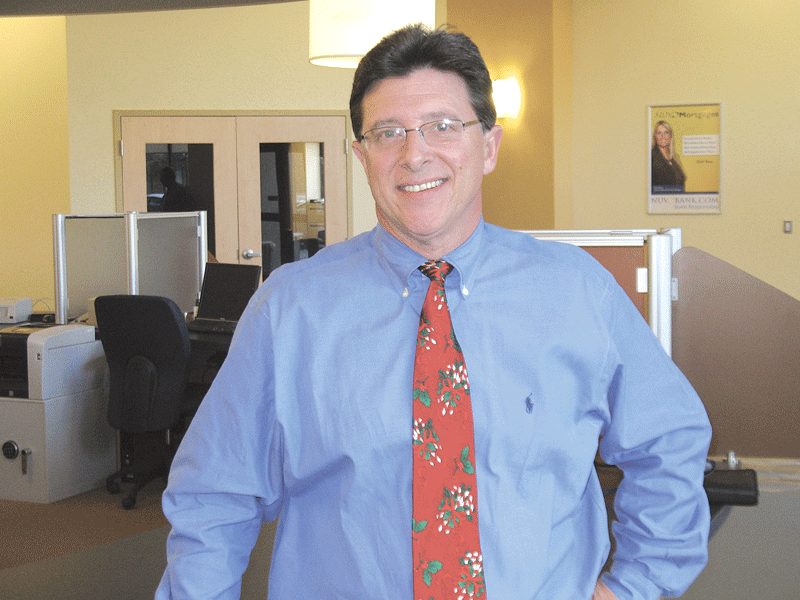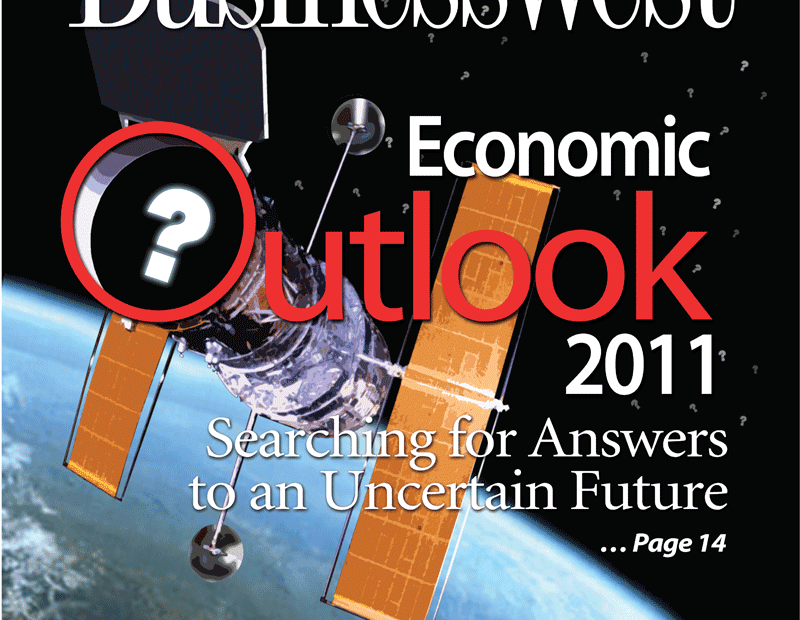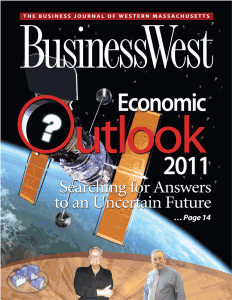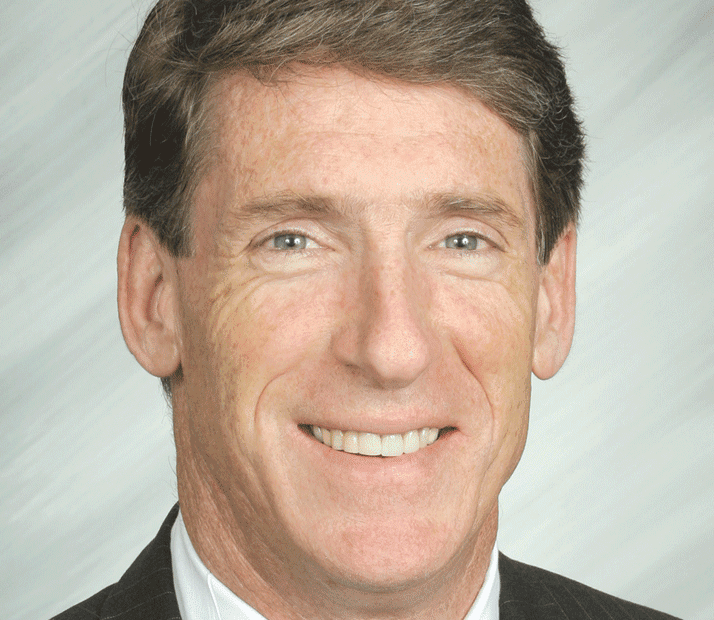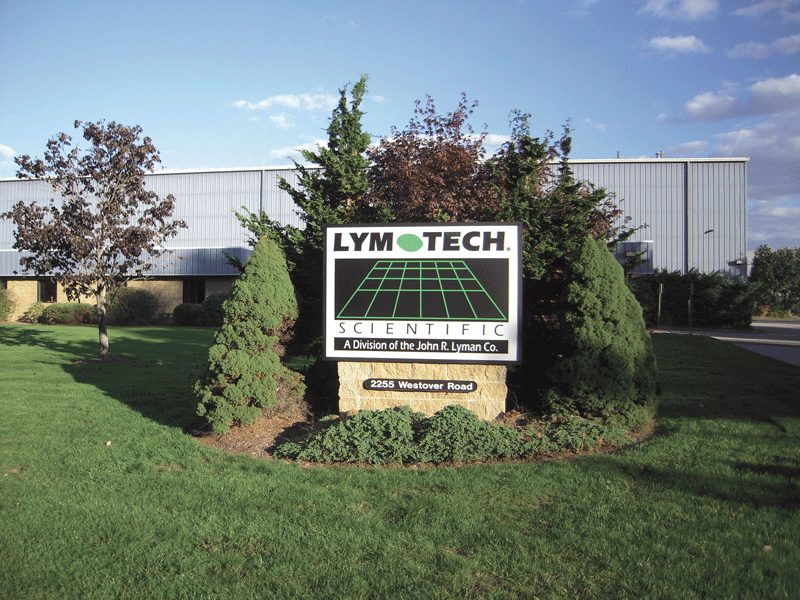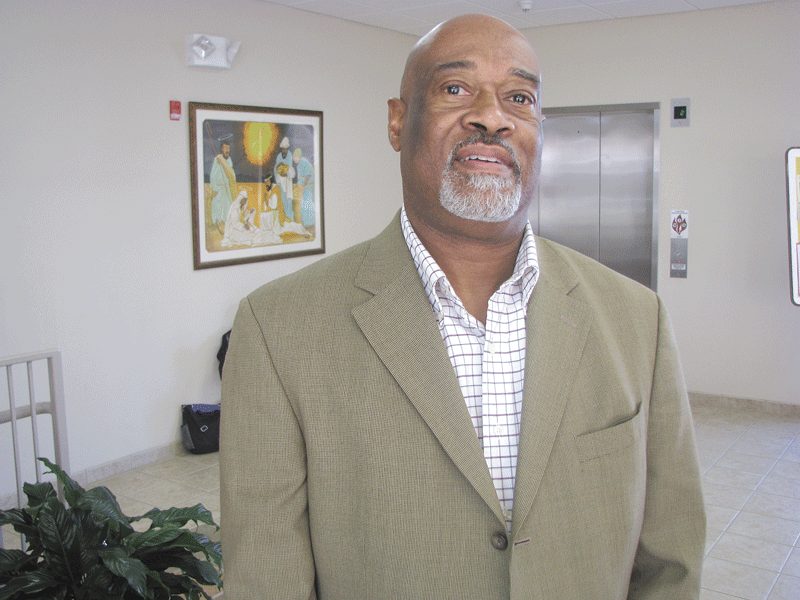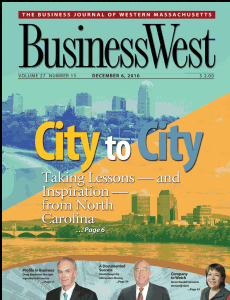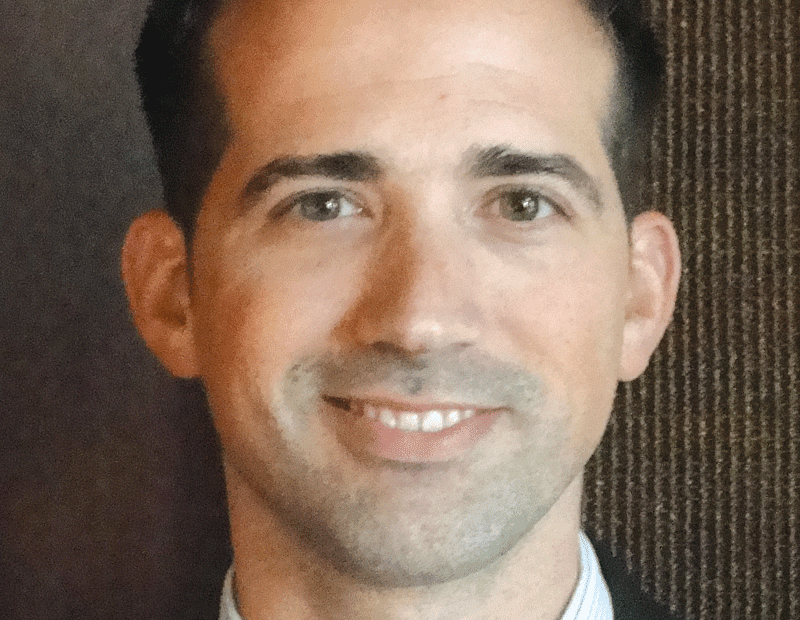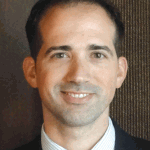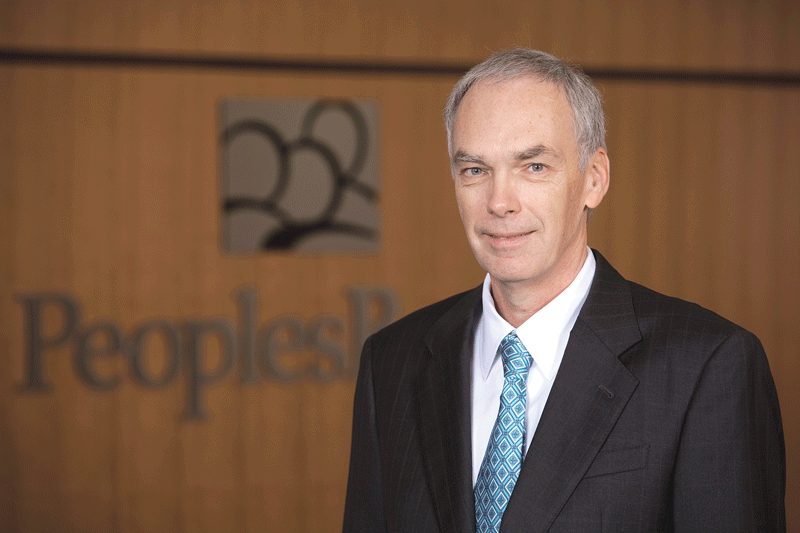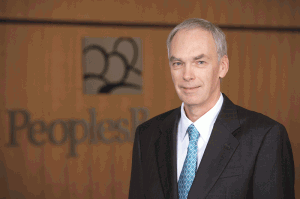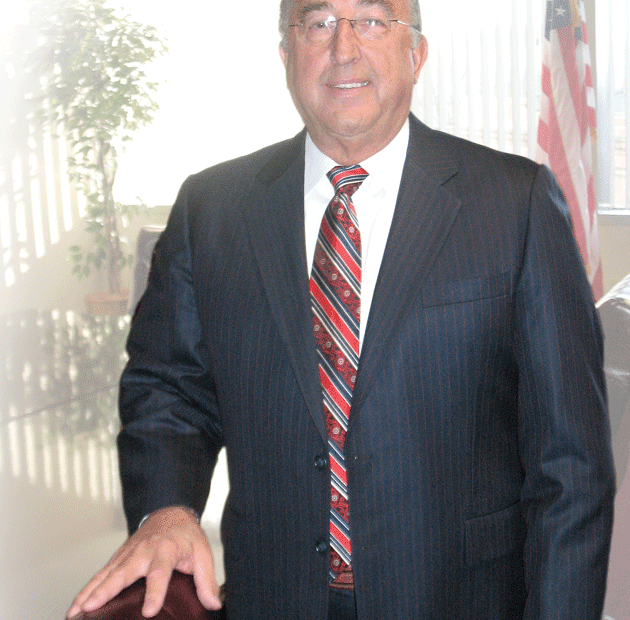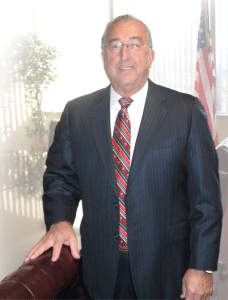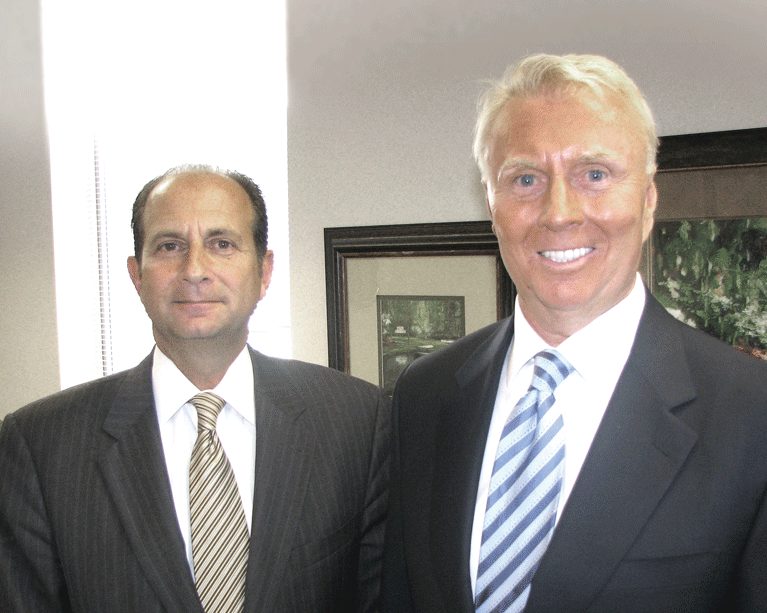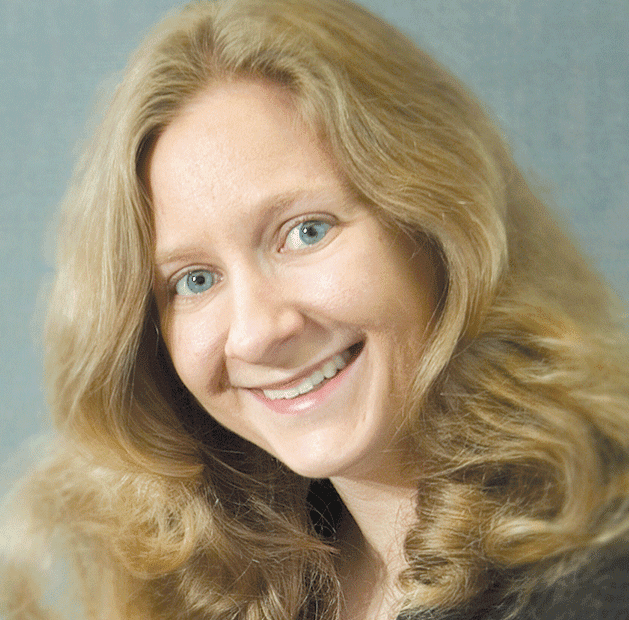Bankruptcies were not available at press time. This issue’s filings will be printed in the next edition of BusinessWest.
Year: 2010
How to Ask an Employer for a Raise in a Difficult Economy
Regardless of economic conditions, rewarding good employees is an investment companies have to maintain. Recession or not, employers need to consider the consequences if their best employees leave. And, let’s be honest, if you’ve made it this far, you’re probably on the list of good employees.Although the job market is often tough to crack when you’re unemployed, those who do have jobs may find themselves in an interesting position. That’s because some businesses prefer to look only at people who are already employed. Although that sounds strange, let’s think about it. In a tough economy, most companies make their first cuts in areas that aren’t vital to their operations. The employees who survive are likely to have skills that are essential to the business.
So you still have a job, and you think you have a desirable skill set. How do you ask for a raise when the economy is struggling? The first thing to do is spend some time evaluating your current employer’s position. Some organizations have found it difficult to provide raises. They’re fortunate to be meeting their current payroll, and are just hoping to survive until things turn around. If this is your company’s situation, you’ll have to wait for your organization’s fortunes to improve, but, while you wait, work on broadening or developing the skills you have. You want to make your boss’s decision an easy one when the time comes.
You may learn that your company’s position is not all that bad. Some businesses have been building their financial reserves. As we emerge from the downturn, these companies are looking to expand their operations by adding key personnel. What better way to strengthen your company’s position than by luring vital employees away from your competitors? This atmosphere can create a unique bargaining opportunity for employees who are aware of the value they represent.
Before you ask for a raise, you also have to determine if your salary warrants an increase. You can get some perspective on your current pay by visiting Salary.com or any of the government’s compensation Web sites. If you’re already paid above your market pay rate, negotiating a raise can be difficult, though not impossible. There are a number of intangibles that you may bring to the table, often based on your years of experience. It is also important to remember that a successful negotiation is always based on your merit and not on why you need additional money. While your employer may care about you, providing additional salary to fund your chosen lifestyle is not their responsibility.
If your research indicates that you are undervalued, you then need to justify why you deserve a raise. One of the best ways to identify your value is to track your accomplishments. Keep a notebook, or a computer file, which summarizes your accomplishments, the date you achieved them, and a summary of the work completed, plus what you’ve learned. In our knowledge-based economy, you want to draw attention to the additional skills you’ve acquired since you were first hired. This would include any certifications, continuing education, industry or community awards, or any other activities that show you’ve grown as an employee. You’ll also want to document any cost savings you’ve achieved, how you’ve helped improve productivity, any important projects you’ve worked on, and other ways in which you’ve contributed more than your job required.
There is probably no best time to ask for a raise when the economy isn’t doing well. However, if you’re confident you have a case to make, there are a few things you should consider before approaching your employer. First, be cognizant of their time. If your boss’ schedule is hectic on a particular time of day, be sure to schedule an appointment outside of that time frame. Furthermore, you want to plan to ask for a raise before the annual budget is complete. After the budget is set, it may be difficult for your employer to allocate any additional funding for increased compensation. Finally, be mindful of the overall work environment. If things are particularly crazy, and people are juggling multiple tasks or racing to meet deadlines, wait until things die down.
You should also give some thought to what you’ll do if your employer declines your request, or agrees to a raise that isn’t exactly what you had in mind. Discuss your employer’s reasons, and ask what you can do over the next few months to improve your chances for increased compensation in the future. Don’t back them into a corner. Your attitude should clearly be, “how do I become a more valuable employee?” That should make their decision easier next time around.
Thomas J. Fox is the community outreach director at Cambridge Credit Counseling in Agawam. He is an AFCPE-accredited credit counselor, a CFC-certified educator in personal finance, and an NCHEC-certified housing counselor. He also hosts Your Money 2.0 (YouTube) and Money America (91.9 WAIC); (413) 241-2362; [email protected]
A Key Step Toward Economic Diversity
There wasn’t much fanfare when the Economic Development Council of Western Mass. (EDC) created a new position this past summer, that of ‘manager of Cluster Development.’ But this addition to the staff could have some important implications for the future health and well-being of this region’s economy.
The new cluster czar, if you will, William Wright, who has held a number of business and economic-development-related positions at UMass Amherst and in Michigan, has been handed an important assignment: devising strategies for growing and strengthening clusters of like businesses in this region.
His presence in the EDC’s suite of offices in downtown Springfield is part of a growing movement, nationally and internationally, to take what is inherently an organic process — the development of business clusters — and essentially expedite the process. If he is successful, the region will be taking some big steps toward the diversification of its economy that has become necessary — but not exactly reality — since the area’s manufacturing base started to deteriorate.
Backing up a bit, Wright told BusinessWest (see story, page 6) that clusters are nothing new. They’ve been around for centuries, and this region has developed several, mostly small in size, including gun making, paper and textiles, and, to a lesser extent, plastics. What is relatively new is the notion that cluster development can be accelerated and facilitated, perhaps shaving years or even decades off the process.
This isn’t easy work, and it’s complicated further by the fact that many cities and economic regions are now doing it, but we believe it is an important step forward.
Why? Because, as we’ve said many times before, in this region, and Springfield in particular, there has not been sufficient movement in the process of reinvention. There has been movement in some areas, including distribution (many jobs have been added in that sector), precision manufacturing, technology, biosciences, and even clean energy — but certainly not enough to replace the thousands of manufacturing jobs lost over the past half-century, and not enough to sustain the region moving forward.
So many so-called Gateway cities — Lowell, Holyoke, Fall River, and Worcester are others — have been stuck in neutral for many years now. Clusters are game changers. Anyone who’s been to Cambridge (life sciences), Silicon Valley, or the Research Triangle knows that. The Pioneer Valley is certainly not likely to replicate any of those efforts, but it can grow some existing clusters into more powerful economic engines that will create vibrancy for the future.
There are many facets involved with cluster development, from fostering entrepreneurship to creating stronger partnerships between the business community and the region’s colleges and universities; from facilitating the flow of capital to making a region top-of-mind when it comes to deciding where to launch or grow a business. It all comes down to one word — connections.
Wright is just getting started with his work to make such connections and foster cluster development. This work is difficult, as we said, and no one really knows whether it will bear any fruit. But from all indications, this is an important step forward for the region, one that could lead to real progress in those ongoing efforts to diversify and reinvent.
More Big-bank Customers Switch to Community Banks and Credit Unions
Jim Kelly has long touted the benefits of banking with a local institution.
“It’s important to do business with people you trust,” said Kelly, president of Polish National Credit Union. “When you run into a difficult situation, you can come into our credit union and talk to someone face to face. I think that’s important. It’s all about helping people.”
These days, that’s a message that resonates more than ever, as large, national banks have begun to see a trickle — perhaps a stream — of customers closing their accounts and moving them to smaller institutions.
“All our business is coming from other banks,” said Trent Taylor, chief operation officer and chief credit officer of NUVO Bank, which opened its doors for business just three years ago. “Everyone who comes in here has come from another bank. And the tellers out front are constantly seeing people come in because they’re tired of the fees, and they’re aggravated by their old bank.”
That aggravation is widespread. According to a Zogby survey earlier this year, almost 15% of respondents moved from a national bank to a community bank or credit union in the previous year alone. Reasons — and many people named more than one — ranged from lower service charges (36%) to better rate of return (32%) to convenience (20%). A full 60% added that they wanted to make a statement of protest against one or more policies of the large bank.
Some people feel that way but are hesitant to change, Taylor continued, but many feel the hassle of switching is worth it. “We can offer all the frills of the other banks, but none of the charges.”
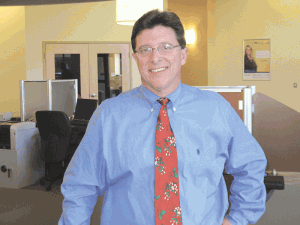
Jeff Sattler says the largest institutions don’t care whether they lose a $1,000 checking account, but community banks value those customers.
“Every time a bank is acquired, change is inevitable, and as they get bigger, Western Mass. becomes a smaller percentage of the size of the bank,” he told BusinessWest. “The big banks are not the bad guys, but this is just not the market they’re interested in anymore. A $100 billion bank doesn’t have the same appetite for a $1,000 checking account; it’s just simple math. And they’re going to charge the fees and say ‘take it or leave it.’
“Bank of America is a trillion-dollar bank,” he continued. “They want that business to leave. But that’s our bread and butter. Our roots are here; we have no one else to answer to.”
Jumping Ship
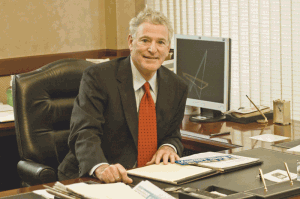
John Heaps says national banks have been losing mortgage, commercial-loan, and retail business to smaller institutions.
“On the mortgage side, it’s clear that consumers and Realtors both like going to local banks because they can look people in the eye and know they’re getting the right product for their financial situation,” he said. “And they know that we, as well as other local banks, also service the loans. That’s huge; we don’t sell the servicing. If you have a question about your mortgage, you can come in and talk to us, and we’ll do what we need to do.”
That local presence is important to both borrowers and their agents, he continued. “If they have a need to modify the loan, like going interest-only, we can make a decision right here in this area. If they have an issue and need to talk to somebody, we’re right here. Realtors are also concerned with getting a relatively short turnaround time for a purchase.”
On the small-business side, Heaps continued, “you just can’t find people in this market area from the larger banks who are looking to make small-business loans. They don’t have the resources; all the people have been transferred to Hartford or Boston, and as a result, the local community banks have really picked up the pace.”
Heaps said he has heard chatter about whether banks are prepared to lend, but that it hasn’t been an issue for institutions based in Western Mass.
“Every single community banker I’ve talked to in this marketplace is willing to lend,” he noted, adding that most of the reluctance to pursue loans is on the borrowers’ side, partly due to uncertainty over the status of the extension of Bush-era tax cuts.
“There’s a reluctance among business people to invest, particularly until they know what the tax situation is,” Heaps said. “A significant number of borrowers have come to us with great ideas, but said, ‘as a small-business person, I don’t know what’s going to happen with my taxes.’ Keeping the tax rates in place for at least next year will have a more significant impact than people realize.”
Finally, on the retail side, Heaps said, many depositors in large banks have become weary of constant changes to the fee schedule designed to hit them with charges for everything from debit transactions to fraud alerts.
In fact, constantly changing fee schedules (rarely in customers’ favor) have chased many depositors away from national banks and toward community banks with much more stable charges (see story, page 28).
“That’s what we’re all about,” Polish National’s Kelly said. “We have some of the lowest fees in the area. We don’t need the money; we make a lot of bottom-line income, so we don’t have to charge a lot of fees. A lot of these large banks brag about how many households they have, but to customers, I don’t think ‘too big to fail’ is seen as a positive thing anymore.”
He said the public recognizes the role of megabanks — specifically questionable lending practices — that contributed mightily to the economic collapse of 2008, and the fact that this region’s community banks and credit unions never operated like that should be a selling point.
“Some of these large banks are going to try to regain their respectability in the industry, and we don’t have to do that,” Kelly explained. “We’ve always done the right thing. If you’re applying for a mortgage, you want to know more than whether you’re getting the best rate and not paying a lot of fees; you also want to be with a financial institution you can trust. These things didn’t come into play a few years ago; then, you were shopping for a rate, and that’s it.”
It’s no surprise, he said, that customers increasingly want to bank at institutions that embrace responsible practices no matter what the economic conditions.
“We’re not going to be able to predict the next recession, but we will have one at some point,” Kelly continued. “At the start of the Great Recession, when the market melted down, we not only maintained strong capital, but remained profitable, and didn’t see any impact on asset quality.”
Should I Stay or Should I Go?
With seemingly so many reasons to leave megabanks, Megan McArdle, business and economics editor at the Atlantic, recently explored the question of why some people choose not to leave. And she started with herself.
“I bank in two places: Navy Federal Credit Union and Citibank,” writes the Washington, D.C. resident. “NFCU is better in all ways except one: they don’t have a branch in D.C. That means that every time I want to make a deposit, I have to drive out to Virginia. So I tend to go there once every few months and put a bunch of cash in the bank for our regular or big expenses: car loan, wedding stuff, rent and utilities. But it is not a convenient place to do my everyday banking.”
She admitted that she stays with Citibank because it has a presence all over the country, and she’s moved her residence often over the past decade — not to mention business travel.
“America does have high rates of labor mobility, and a lot of people travel for work,” she concludes. “That’s going to favor national banks, which, in turn, lets them offer less-favorable terms to their customers. I’m paying for convenience. But frankly, it’s worth it.”
Still, an increasing number of customers insist that it’s not, and that they’d rather bank at the institutions that didn’t contribute to the financial meltdown, yet will have to pay in some ways for the mistakes of the megabanks. Heaps noted that, while about 30 new rules emerged from federal regulators in the wake of the Enron scandal, the Dodd-Frank financial-reform bill passed earlier this year includes about 300.
“That’s what we’ve been living with; we’ve paid the price,” he said. “But now we’re starting to see consumer confidence picking up.” And that means more opportunities for big-bank customers who are starting to reconsider the value of the local touch.
Joseph Bednar can be reached at
[email protected]
Success in His Chosen Field Was No Accident
Rick Recor was recalling his early days as an entrepreneur, more than 35 years ago, when he hung out his shingle in the highly competitive world of auto-body work.When asked if that venture, like the current operation on Pasco Road, put his first name over the door, he had to pause and think.
“You know … it was so long ago, I don’t even remember,” he told BusinessWest. “It must have, because I don’t recall ever naming it anything else. But when I look back, I don’t think it even had a name; I was doing almost exclusively wholesale at the time.”
So you might say that both Recor and his operation have made names for themselves in this business — and well outside it — over the past four decades. Indeed, by most standards, Rick’s has become one of the more well-known and established brands in the region, an accomplishment made possible by everything from heavy repeat business to a highly orchestrated billboard campaign that continues today, although on a much smaller scale than 10 years ago.
And now, as then, Recor is heavily involved with even the most minute of details involving all facets of this business, something he believes casual observers of his enterprise probably don’t know or understand.
“I’m not out on some island like Tahiti, which is what some people think,” he said. “I’m out there [in the shop] on production, every day. I look at every car before it goes off for delivery, and I look at it during the repair process, as well. I’m in here six days a week, and working hard; I have to — that’s the nature of this business.”
From very humble beginnings — a business with no name and just a few customers — Recor has grown his venture into one of the largest of its kind in the region, one with 40 employees, and maybe 100 cars in the shop at any given time. Rick’s will handle more than 3,000 jobs in a typical year.
Much has changed since those early days. “When I first started, it took two people to take a bumper off a car. That’s how much one weighed, maybe 200 or 300 pounds — they were all chrome; now, you can do it with one finger because everything is so light for fuel economy,” Ricor noted, citing just one example.
But the basics haven’t changed, he continued, listing solid customer service, attention to detail, and the need to generate business volume as just some of the things in that category.
For this, the latest installment in its Profiles in Business series, BusinessWest chronicles the winding road Recor took to this point in his life and career, and in the process gets a crash course in the auto-body business.
Scratching the Surface
As he talked about the ins and outs of his chosen field, Recor made repeated reference to a red Corvette parked in the back corner of the huge garage. Much of the front end had had been stripped off, and the hood was gone, revealing the powerful engine.
“The ‘BP’ written on the windshield stands for ‘blueprint,’” said Recor, referring to the battle plan for returning the car to its pre-mishap condition and the name of the technician who will carry it out — written next to those two letters. The BP follows the disassembly, or tear down, of the damaged portions of a vehicle, a process followed by the cataloguing, ordering, and checking of replacement parts, sequential steps that are carried out methodically to avoid having to do things twice, a very high priority given the low margins shop owners work under in this state (more on that later).
Recor said he gets involved in each of these steps and others that follow, including paint-shop work and final inspection before the car goes back to its owner, a regimen he describes as “orchestrating” each and every job that comes into the shop, including the longest and most expensive project to date — repairs to a Mercedes that totaled $68,000.
“There were more than 300 parts involved with that one job, when you count every nut and clip,” he said, adding that he inspected every step in that endeavor, as he has with every job, right down to a simple fender replacement.
Aside from the six months he was being treated for and recovering from throat cancer in 2005, this is the way it’s been for Recor since he first entered the world of auto body work after dropping out of high school in the early ’70s.
He started with sanding and taping duties for Boston Road Motors in Springfield, for which his father sold used cars. Later, he went to work for Central Chevrolet in West Springfield, where he painted cars and started the progression from employee to employer.
“I mentioned to (owner) Floyd Voke that I could paint a lot more cars if I had some people helping me,” he recalled. “He said that, if I split the ticket, split the compensation, I could hire people. So I did, I hired two people. They prepped the cars and I painted them, and I worked til 10 o’clock at night.”
After painting cars for a few other area dealers, he decided, in 1974, that it was time to go into business for himself.
He set up shop in a one-car garage behind Millie’s Pierogi on Broadway Street in Chicopee, and started doing work for a few auto dealers in the area.
He steadily added customers and, with his name now on the signs and work orders, grew the business into progressively larger garages. In 1997, he moved into a 40,000-square-foot facility on Pasco Road that was formerly home to Grossman’s Lumber. There, he now manages a truly family business.
Indeed, his wife, Mari Tarpinian, a long-time travel-bureau employee who was downsized when that industry shrank, joined Rick’s several years ago. She’s responsible for marketing and human resources, and handled most all of the myriad logistics, including the rugged permitting process, involved with getting the new digital sign now outside the business up and running.
Meanwhile, Recor’s sister-in-law, Susan, is the office manager, and his father-in-law, Leo, now in his 80s, picks up and drops off customers and “chases parts,” among other duties.
Not officially family members, but certainly critical to the organization, are the 40 or so other employees, said Recor, noting that many have been with him for two decades or more.
Framework for Success
As he gave BusinessWest a tour of the many departments within the sprawling shop, Recor would occasionally stop at a car, reach in an open window, pull the work order off the dashboard, and point to the line at the bottom of the page where it lists who referred the customer in question.
In each case, and not coincidentally — remember, he knows practically everything about each car in the garage — the words ‘return customer’ were stamped onto that line.
“Repeat business is very important in this field,” he explained while reaching into another window. “We have to generate volume, and to do that, we have to give people reasons to come back, not look somewhere else the next time.”
Elaborating, Recor said that he and all other players in this sector are continually challenged by the hourly rates that insurance companies are willing to pay for work done. Those rates average perhaps $37 per hour, he continued, and with the highly skilled workers he employs and his considerable overhead, there is literally no margin for error.
“We’re working with the lowest labor rate in the country, which makes it very hard to make a profit,” he explained. “To be profitable you have to be as efficient as possible, and you need to be as thorough as possible, because there’s no time to do anything twice.”
While discussing his business and how he handles its many challenges, Recor had to clear his throat often, and took repeated hits off a bottle of water. The dryness is one of the lingering effects of his throat cancer; another was the loss of roughly half his hearing.
He described his course of treatment and recovery as the most difficult time of his career, when he was left with no choice but to relinquish his orchestration duties and let someone else supervise the shop.
“It was hard, but you seem to forget about work when your health is an issue,” he explained. “It just not that important anymore.”
These days, work is paramount again, and, as always, Recor is singularly focused on the 60 or 70 cars that are in his shop and in various stages of repair. He said he enjoys riding his motorcycle when the weather allows, and likes to get away to New York City with Mari. But his first love appears to be his orchestrating at the shop. Which is good, because he’s at it maybe 60 hours a week.
“The best part of my job is that I still love what I do, and to me, that’s everything,” he said. “I’m usually one of the first people here, and I’m the last one to leave. I like it that way.”
Now 58, Recor said that while at various points in his career he thought about possibly expanding and opening multiple locations, he is content with his one shop.
“It’s too late in the game for me now; it’s always been my dream to be where I’m at, but it just took too long to get there,” he said, adding that the logistical difficulties of major expansion, as well as the problems he would have finding enough qualified help, have stifled those ambitions.
But looking back over 35 years, he can say that he’s certainly enjoyed this ride, and there are many miles still to travel.
George O’Brien can be reached at
[email protected]
Searching for Answers to an Uncertain Future
While uncertainty is the one word most experts are using to frame their opinions about 2011, something approaching consensus is taking shape. It appears the region and nation are due for more slow, unremarkable growth, and probably insignificant gains in terms of employment. In other words, it looks like more of the same that we saw in 2010.Andre Mayer had an intriguing way of summing up what happened with the economy in 2010, one that captured the sentiment of most observers.
“It’s been a year in which conditions have certainly improved … but in a rather disappointing way,” said Mayer, vice president of Communications and Research for the Associated Industries of Mass. (AIM). Indeed, after recording fairly significant growth in the first six months of the year, the economy stumbled, and then seemed to take at least one step backward for every step forward.
“In 2010, we had a pretty good first half in terms of working our way out of a recession,” Mayer continued. “The state economy improved, and business confidence increased, right up until June, and fairly steadily. But then, things began to deteriorate, and some of that has to do with the diminishing impact of stimulus actions on the part of the federal government. We had quite a disappointing third quarter, and while the fourth quarter has been a little better than the third, we’re well behind where we thought we’d be in terms of recovery.”
Karl Petrick, an assistant professor of Economics at Western New England College, agreed.

Karl Petrick says a “Mexican standoff” between consumers and business owners is one of the many issues limiting recovery from the Great Recession.
That report — which showed that just 38,000 jobs were added for the month of November, after robust growth in October, and an unemployment rate of 9.8% — has many economists scratching their heads and shrugging their shoulders when they talk about 2011 and what can be expected regionally and nationally.
But while there is certainly a large amount of uncertainty, there is something approaching consensus when it comes to the outlook on the months and quarters ahead — growth that will be slow and generally unremarkable, with probably only slight improvement in the jobs situation.
This goes double for Western Mass., said Bob Nakosteen, professor of Economics at UMass Amherst, because this region lacks what he calls a “jobs-creating fuel source” like the technology and biosciences clusters in Central and, especially, Eastern Mass., which greatly outperformed the western counties in 2010.
“The problem, of course, is that we really haven’t replaced our declining manufacturing base with anything that has dynamism into the future,” he said, with ‘we’ referring to the Pioneer Valley as a whole, but especially its largest city. “Springfield has not reinvented itself; it has a lot of potential, but isn’t that the worst curse in life, to have a lot of potential?”
“We’re just in for a period of relative stagnation, if that’s the right word,” he continued. “There will be slow growth; I think this may start to improve, but it probably won’t happen before midyear. And it’s only when the national economy starts to improve that we’re going to feel some of the benefits in this part of the state. And there just isn’t enough of an economic engine here to have traction once the national economy starts to grow.”
But Mayer was much more positive in his outlook. “I think 2011 should be a year in which it becomes clear that the recovery is taking hold. We should see improvement from a very low rate of growth as the year goes on, and we’ll enter 2012 in much better posture than we’ll enter 2011.
“Unless we fall off completely,” he continued with a laugh, noting that there is just too much uncertainty — in this area code and countries like Ireland, Portugal, Greece, and others — to say with any degree of confidence what will happen.
For its Economic Outlook 2011, BusinessWest talks with several economists about the immediate future and what will shape it from a recovery standpoint. Overall, they said there are far more questions than hard answers.
Realistic State of Mind
Amid the prevailing disappointment over how 2010 played itself out, there were some bright spots that could prompt optimism if one were so inclined.
Mayer said the state’s performance, which exceeded the nation’s, was one such positive, in part because it showed some depth and diversity in the Commonwealth’s economy, although the good showing likely had more to do with the fact that the Bay State isn’t dominated by the industries hardest hit by the Great Recession, such as home building and automobile manufacturing.
“The fact that we’ve not only been able to keep pace, but actually outperform the nation so far in this slow and halting recovery is a good thing for us,” he explained, adding that, historically, the state has lagged behind the rest of the country when it comes to bouncing back.
Meanwhile, the Commonwealth’s performance helped it retain some talented young people who might otherwise have left for presumably greener pastures.
“We have not seen the kind of outflow of human capital, mostly young people with marketable skills, that we’ve seen after past recessions,” Mayer explained, “because they would leave to seek better job opportunities elsewhere in the country. Right now, there aren’t those kinds of opportunities.
“In fact, the kinds of places where they used to go, the areas with high population growth, like Arizona, Florida, and Nevada, are suffering very badly in this cycle,” he continued, “because those are places where real estate and home construction are very important parts of the economy, and those sectors have just been hammered.”
Overall, the Massachusetts economy — and individual businesses large and small — have “adjusted,” said Mayer, which, roughly translated, means they’ve become more efficient and able to do the same with fewer people, which is another positive from a competitiveness standpoint, but not from a job-growth perspective.
“On balance, companies have been able to adjust to more-difficult circumstances, to a slow-growth economy,” he told BusinessWest. “They’ve been able to keep afloat and in some cases do pretty well, but they’re doing this, in large part, at the expense of job creation; they’ve slimmed down their staffing, and they’re very reluctant to add on new people, so we haven’t seen a whole lot of job creation.”
And, surprisingly, one of the areas where there’s been recorded growth is manufacturing, noted Mayer, adding that this is probably the last sector most observers thought would expand. “Manufacturers can usually squeeze more productivity out of their existing staff, and they’ll usually do that before they add people, so this has been an odd pattern, but something else that bodes well for the state.”
Despite these positive developments, 2010 has been rather forgettable, said Mayer and other observers, and the sluggishness of the past few months, not to mention the November jobs report, makes it that much more difficult to gauge what the year ahead will be like.
“One month you get 172,000 jobs, and the next, 39,000 new jobs, one-fifth the number that was forecast,” said Petrick. “That just really shows how uncertain the recovery remains in terms of when it’s going to gain steam.
“Most forecasters were almost writing 2010 off, saying, ‘we’re going to see some improvement, but not a lot,’ and those people were right,” he continued. “But then, most people were forecasting that things would pick up in 2011; now, some of the more pessimistic forecasts are for 9.5% unemployment nationwide, and the optimistic ones are for 8%, which is significantly higher than it had been, and that doesn’t bode well for Western Mass.”
Petrick noted that perhaps the biggest stumbling block to economic progress, both regionally and nationally, is confidence, or lack thereof. This fear of what is still very much the unknown has both consumers and business owners frozen in their tracks and either unwilling or unable (or both) to step forward with any conviction.
“Consumers are uncertain — they’re holding back as much as they can,” he explained. “Businesses are uncertain, not because they’re worried about taxes, but because they’re worried about what’s happening with consumption. It’s a Mexican standoff between consumers and businesses, each one saying ‘you first.’ Consumers are saying ‘hire us and we’ll spend,’ and businesses are saying ‘spend and we’ll hire you.’”
Stimulating Conversation
Whether there is any relaxing of this standoff in 2011 depends largely on when and to what degree the national economy improves, said Petrick, adding that there are several factors that will play into this.
These include everything from the fate of the announced compromise tax plan to the impact of whatever stimulus funding is still to be spent, to the Federal Reserve’s attempts to actually spur inflation, or at least ward off the more dangerous deflation.
“They are trying to get a higher rate of inflation than we have now, because there are some things that might spring from this that are healthy,” said Nakosteen. “If businesses can get a bit more of a margin in the prices they charge, if low interest rates in the face of a little more inflation prompt investors to get more into the stock market, these are good things, and two outcomes the Fed is trying to get by doing this.
“The risk is that they’re in a little bit of uncharted territory,” he continued, “and it’s not real clear that those actions are actually going to prompt the economy to begin to recover. There are only so many things they can try, and they seem to have tried one of everything; no one really knows.”
Those four words apply to many of the questions concerning the regional and national economy, including the matter of federal stimulus efforts.
Indeed, while many believe the impact of stimulus programs is now mostly in the past tense, Petrick said there remains a substantial amount of stimulus funding that has been allocated for this region but not spent.
“This is construction money, by and large, and it will be helpful, because that’s the sector that’s been the hardest-hit,” he explained. “There still could be a positive effect in the next year from that money that’s been allocated for different projects but hasn’t been spent.”
Locally, progress for the short and long term may well depend on if and to what degree the region can advance the process of reinventing itself.
Petrick sees some signs of progress in the Valley’s ongoing efforts to build its ‘green’ sector.
“This is a region that could, with a lot of work, start to make a name for itself in terms of green technology,” he said. “We have some green shoots — individually, they’re not much, but collectively, this could be a positive thing that could prompt hiring across a number of skill levels.”
But Nakosteen says the region still has a lot of work to do with regard to the process of reinvention.
“We’ve had this long-term decline in our base,” he explained. “There’s nothing really stopping that, and there’s nothing arising to take its place. There’s nothing taking hold to get these gateway cities going, and Springfield is one of those gateway cities.”
The biggest concerns for the year ahead involve jobs and the likelihood that this state and region won’t be creating many.
“We’ve done all right in Massachusetts relative to the rest of the nation,” said Mayer. “October was a pretty good month, maybe the first we’ve had, and then the November report came out, and we went backwards. So it’s very hard to predict what will happen next year.”
U Guessed It
While the past few months have shown that seemingly anything can happen in 2011, economists are in general agreement that the nation and region will likely continue moving along what is the bottom of the U that several referenced when taking about the shape of the recovery.
There may be more movement back up, Petrick told BusinessWest, predicting what amounts to more of the same for at least the next few quarters.
In other words, when 2011 nears its end, you may be seeing and hearing economists say there was improvement, but in a rather disappointing way.
George O’Brien can be reached at
[email protected]
You generally must include taxable fringe benefits in an employee’s gross income. Most are subject to income-tax withholding and employment taxes. Here are some of these taxable items to include:
1. Personal use of auto. The value of an employee’s personal use of a company-provided auto should be included as income. There are IRS guidelines to determine the amount of this calculation.
2. Value of life insurance if over $50,000. To the extent that the benefit of the life insurance exceeds $50,000, an amount as determined by IRS tables is a taxable fringe benefit.
3. Memberships in country club dues or other social clubs. If these payments are strictly for personal use by the employee, they are a taxable fringe.
4. Tickets to entertainment or sporting events. The value of the tickets for personal use should be included as taxable to the employee.
5. Discounts on property or services. The taxable portion is the extent to which the discount exceeds the cost of the product (or more than 20% of the price for services charged to customers.)
However, some fringe benefits are not taxable (or are minimally taxable) if certain conditions are met. Some of these items are as follows:
6. Services provided to your employees at no additional cost to you.
7. Certain minimal fringes, including an occasional cab ride if an employee must work overtime, or meals that you provide at eating places that you run for your employees if the meals are not furnished at below cost.
8. Qualified transportation fringes. These are subject to special conditions and dollar limitations, including transportation in a commuter highway vehicle.
9. Qualified moving-expense reimbursements. Reimbursed and employer-paid qualified moving expenses paid under an accountable plan are not includible in an employee’s W-2.
10. Use of on-premisis athletic facilities. If substantially all of the use is by employees, their spouses, or their dependents, this is not a taxable fringe benefit.
You should contact your tax advisor to determine the value of the taxable items to include, or to determine whether or not certain items are taxable.
Why Blocking Employee Access to Social Media Won’t Work
Many employers are fearful of opening up Pandora’s box and allowing employees access to social sites that may cause a distraction and reduce productivity. Well, if your employees carry cell phones, most of them already have access right in their pockets or purses, so your effort to block access is defeated before you even implement it.Employers should try to understand that, first and foremost, social-media sites such as Twitter, Facebook, LinkedIn, YouTube, and blogs are communication tools. They offer your company a channel to listen, monitor, and engage with customers like never before. They open new sales outlets by introducing your product or service to an expanded group of prospects, and they help to build relationships by creating a human voice and face for your company by empowering employees to listen, care, and resolve issues.
There is a potential dark side, though. Companies risk employees conducting themselves unprofessionally, antagonizing irritable customers, and distributing incorrect information, which may damage your brand. In addition, you may fear that you’re actually providing your employees with toys to play with all day long instead of doing ‘real work.’
So how can an employer cash in on the tremendous potential benefits of social media while mitigating risk? Here are a few suggestions:
Monitor Brand Chatter
The conversations about your product or service are happening on social media whether or not you’re listening, so isn’t it better to know what people are saying about you? This gives you the opportunity to thank loyal customers for their praise, as well as solve problems that often turn unhappy customers into publicly satisfied ones. Ignoring social-media channels is essentially overlooking customer feedback.
Engage in the Conversation
Can you really afford to block access to any place where people are talking about your company? When employees use these communications tools, they ultimately bump into these conversations, whether deliberately or accidentally. This opens up an expanded, albeit perhaps informal brand-monitoring and customer-service channel.
Don’t Worry About Lost Productivity
Do your employees work exclusively 9 to 5, or do they regularly stay late, take work home, and read e-mail off-site? If your employees have the dedication to work outside the traditional box, your concerns about allowing them to check their Facebook page or watch a YouTube video at the office seem a little misdirected.
Remember that social media is a communication channel, and people typically utilize the path of least resistance when reaching out to a company, so social media makes it easy to get to the right person within an organization very quickly. Also, people are migrating to social media to share resources and problem solve, so if you block access, you’re preventing your employees from accessing people who can offer solutions and keeping them at the mercy of time-consuming, paid phone tech support.
Provide Guidelines and Trust Your Employees
Guide your employees in the appropriate use of social media. Remind them that they are representing your company and to refrain from negativity, profanity, and augmentative or confrontational conduct. Encourage them to listen to the chatter and not to be afraid to disclose their identities. Social media is about building relationships, and people don’t build relationships with companies, they build them with people.
You have to trust your employees, and the best way to guide social media efforts is to provide suggestions about how they can help you. Encourage them to report any negativity they bump into, or encourage them to jump in and offer to connect the customer with someone within your organization who can help. This can effectively turn your entire organization into a customer-service team.
The Viral Epidemic
The beauty of social media is that information often spreads virally. Consider the instant celebrity of Susan Boyle from Britain’s Got Talent. Her audition earned her a soft spot across the globe almost overnight because the YouTube video was shared repeatedly across social-media channels. What did that do to viewership? Although few products or services can expect to gain that level of overnight notoriety, people’s choices are affected daily by recommendations made via social-media channels.
People like to share ideas and make recommendations. That’s how things go viral online, and social media provides an ideal vehicle because it’s so easy to share information. If your company is there, you can participate and respond.
Business is done, referrals are made, problems are solved, and chatter about brands happens every day on social media. If you block access, you’re missing out on amazing opportunities to develop relationships with potential customers, those who need help with your products, and people who are your best advocates. Worst of all, you’re handing potential business to your competition if they’re making it easier for customers to communicate than you are. Can you afford that? n
Christine Pilch is a partner with Grow My Company and a social-media marketing strategist. She trains clients to utilize LinkedIn, Twitter, Facebook, blogging, and other social-media tools to grow their businesses, and she collaborates with professional service firms to get results through innovative positioning and branding strategies; (413) 537-2474; linkedin.com/in/christinepilch; facebook.com/
growmycompany; twitter.com/christinepilch;
youtube/user/christinepilch; growmyco.com
The Economy and Our National Funk
“Yes, we can.’’ That was Barack Obama’s mantra as he took the helm of the nation nearly two years ago. Even though the economy looked scary, he — and we — had a sense of optimism that we could fix it. Not only would we avoid a second Great Depression, but we’d make things better.
Since then, we’ve successfully pulled back from the precipice. Private employers have added jobs for 10 straight months. In September, the National Bureau of Economic Research declared that the recession ended in June 2009.
And yet, despite these improvements, we seem to have lost our can-do conviction that the economy can indeed improve, that we can again create good jobs for all who need them. There appears to be a growing acceptance that slow job creation is “just the way things are.’’ A growing fatalism convinces us that the economy will be stuck at the bottom for quite some time.
These diminished expectations aren’t merely evidence of a national funk; they also pose a real threat to our economy — not just by making businesses and consumers less willing to invest in the future, but also by letting elected officials off the hook. Bringing down unemployment means more stimulus programs, but the widespread idea that we are doomed to austerity gives policy makers an excuse not to tackle the problem.
Americans are talking as though 2008’s direst economic predictions had come to pass. “Recovery means lower expectations,’’ MSNBC recently pronounced, reflecting the tone. Three out of every four millennial workers — those age 18 to 27 — report feeling threatened by the possibility of a layoff or job loss in the near future, and this is dimming their career hopes, according to a recent study by Lumin Collaborative. Older workers are delaying retirement because of falling assets, and many are accepting jobs far beneath their experience and education.
We are sending a new Congress to Washington, but we lack any faith that our representatives actually can address the most pressing issue on our minds: jobs. According to a recent poll from CBS, barely four in 10 Americans think that congressional Republicans have a clear plan for creating jobs. Obama’s numbers on this issue are only slightly better.
When nearly one in 10 are struggling to find work, and after 2.5 million foreclosures and counting, this sense of despondency is understandable. But this reaction, even among those who are working, is one of the most insidious outcomes of the Great Recession. Even though you or I cannot create the 15 million jobs necessary to get all those unemployed back to work, believing that no one can do so can hurt us all. A lack of ‘can-do’ thinking on the part of those in power — and those who advise them — will be just as disastrous for the American economy as was recession.
Consider what’s happened in Japan. That economy continues to struggle to recover from the bursting of its housing bubble in the 1990s. Japan has been stuck in a deflationary spiral, eerily similar to the path the U.S. is headed down. The fundamental problem has been a lack of willingness to spend and the political will to take the necessary steps to push Japan back on a path of stronger economic growth.
A more encouraging example, from Germany, suggests that we don’t have to accept that high unemployment is “the way things are.’’ German policy makers, for example, take unemployment seriously. And while their nation saw a larger decline in output during the Great Recession than did the U.S., their unemployment rate did not rise. Policy makers had put in place measures to encourage employers to keep on workers by temporarily cutting hours. In this way, they avoided the kind of high unemployment we’re now seeing, and Germany is now set to experience its fastest year of growth since 1991.
The federal stimulus bill saved or created more than 3 million jobs, and states received some relief to help them cope with falling tax revenues. But federal dollars are fading long before we’ve solved the unemployment problem.
Now much of the conversation in Washington is turning to paring back spending, rather than focusing on job creation. Washing our hands of the problem of high unemployment won’t make it go away. We need to demand that our elected leaders continue to focus on job creation — and not accept the notion that they can’t solve the problem. v
Heather Boushey is a senior economist at the Center for American Progress.
Smith & Wesson to Add 225 Jobs in Springfield; Net Sales Rise Slightly
SPRINGFIELD — In the third quarter, Smith & Wesson made the strategic decision to relocate its Thompson/Center Arms operations from Rochester, N.H. to the company’s facility here. Approximately 225 jobs are expected to be added to the local economy with the Rochester relocation initiative. This relocation is designed to provide the company with increased operational efficiencies through the optimization of the company’s manufacturing footprint and increased synergies generated in fixed, marketing, and administrative costs. The bulk of the $9 million of estimated cash outlays associated with the relocation will occur in the second half of fiscal 2011, and those outlays are expected to be recovered in approximately 24 months. The relocation is scheduled to commence in January and conclude by November 2011. In other news, Smith & Wesson Holding Corp. recently announced that total net sales of $96.3 million for the second quarter decreased $13.4 million, or 12.2%, from net sales of $109.7 million for the comparable quarter last year. Indications are that the consumer firearm market has moderated further following the significant increase that started in the company’s third quarter of fiscal 2009. In the second fiscal quarter of this year, sales in all handgun and tactical rifle product lines, except premium products, were flat or lower than in the prior year quarter due to a more competitive environment and a trend toward more value-oriented products. Hunting products were the exception and increased 26.3% over the prior year’s comparable quarter on improved sales of black-powder products and the company’s new bolt-action rifles.
AIM Index Off in November, Retains Most Gains
BOSTON — The Associated Industries of Massachusetts (AIM) Business Confidence Index lost 3.2 points in November to 52.1, but held on to most of the gains from its record 7.7-point rise in October. The sub-indices based on selected questions or respondent characteristics all lost ground in November, though most gave back less than half of their October gains. The current index of conditions prevailing at the time of the survey was off 2.6 points at 50.6, while the future index of expected conditions six months ahead dropped 3.5 to 53.5. Andre Mayer Sr., vice president of communications and research for AIM, noted that employers are disappointed by the pace of recovery and are aware of considerable risk in the economy, but see conditions slowly improving and expect improvement to continue over the next six months. The Massachusetts Index of business conditions prevailing within the Commonwealth fell 2.6 points to 47.5, remaining above the U.S. Index of national conditions, which lost 5.8 (after a 12.3-point gain in October) to 43.0. On the year, the state indicator was up 9.0, its national counterpart up 6.3. Mayer added that survey respondents have rated the state’s economic climate better than the nation’s through this downturn and recovery. The monthly Business Confidence Index is based on a survey of AIM member-companies across Massachusetts, asking questions about current and prospective business conditions in the state and nation, as well as for respondents’ own operations. On the index’s 100-point scale, a reading above 50 indicates that the state’s employer community is predominantly optimistic, while a reading below 50 indicates a negative assessment of business conditions.
UMass Trustee Chairman Steps Down
AMHERST — University of Massachusetts Board of Trustees Chairman Robert J. Manning stepped down as the leader of the 22-person UMass governance board on Dec. 8, saying it would be beneficial for the university to have new leadership as it enters a period of transition. Manning noted in a statement that the university is “embarking on a transition phase” that is significant to UMass, and as his term winds down at the end of this academic year, he cannot sign up for another five years. Manning, who has served as chairman of the board for three years, noted of his tenure, “it’s been a remarkable experience for me.” Manning added that he was stepping down from the chairmanship and from the board effective immediately. Gov. Deval Patrick will appoint the next chairman, according to Manning.
Poll: Strong Support for Resort Casino
PALMER — A recent public-opinion poll commissioned by Northeast Realty Associates and conducted by Market Street Research of Northampton shows overwhelming support for the establishment of a resort-style casino destination on acreage across from the Mass. Turnpike entrance on Route 32. The survey, conducted in mid-November, indicates 64.8% of Palmer residents support the development of a resort-style casino on land owned by Northeast Realty, while 30.3% are opposed with 4.9% undecided. Mohegan Sun currently holds a 99-year ground lease with Northeast to develop the property into a destination resort casino should gaming become legalized in Massachusetts. Earlier this year, the state House and Senate passed legislation calling for three resort casinos in the state, stipulating one of the venues for Western Mass. While final agreement on the legislation is stalled, Gov. Deval Patrick has consistently supported the development of three resort-style gaming venues, including a Western Mass. destination.
Spalding Hoophall Classic Teams Named
SPRINGFIELD — Springfield College’s Blake Arena will be setting for the 10th annual Spalding Hoophall Classic Jan. 14-17, representing 46 teams from 17 states. The nation’s premier high school event will showcase its strongest field in its history with elite matchups including Dallas Lincoln High School (Dallas, TX) vs. Findlay College Prep (Henderson, NV), Oak Hill Academy (Mouth of Wilson, VA) vs. Milton High School (Milton, GA), and St. Patrick High School (Elizabeth, NJ) vs. Bishop Gorman High School (Las Vegas, NV). Numerous games from the 2011 Spalding Hoophall Classic will be televised nationally. Other programs scheduled to participate include DeMatha Catholic High School (Hyattsville, MD), Christ the King High School (Middle Village, NY), St. Thomas More School (Oakdale, CT), and St. Anthony High School (Jersey City, NJ), coached by Bob Hurley, Sr., who was inducted into the Hall of Fame in August. The 2011 event continues its tradition of talented players by featuring more than 20 of the ESPNU’s Top 100 in the class of 2011.
Do You Need Full-replacement Insurance on Your Building?
The owners of a new company found a building on the market for an affordable price, so they bought it. Built in the 1940s to manufacture aircraft for the war effort, the metal structure had a large open space. The company occupying this space was in the software-development business, and the building was much larger than it needed, but the price made it seem like a sensible move. However, the owners got a surprise from their insurance agent about property coverage.Insurance companies base limits of insurance on the cost of replacing a building exactly as it was before the loss. The cost of reconstructing this old building was much higher than both its purchase price and that of other suitable properties. The company did not need that much insurance, and paying the higher premium for it would have been wasteful, so the owners asked the agent for alternatives. What if, they asked, we don’t rebuild our building as it was?
After a fire or some other catastrophe destroys a building, its owners may decide not to rebuild or replace with a similar structure for a number of reasons:
• As was the case with the software company, the current building’s design may be impractical. The company bought the building because of a good price, not because of its large open space. A software developer ordinarily does not need that much space; if it were to rebuild, it would almost certainly choose a smaller building with a different layout. Also, very old buildings often include materials that builders do not commonly use today, such as plaster and lathe. Reconstruction with these materials is expensive and often unnecessary for the continued operation of the business.
• The company may decide to consolidate the operations of two locations into one. The second location may have the capacity to absorb the first one’s operations, and management may feel that it will gain efficiencies by consolidating.
• Depending on the building’s age, it may not meet current building codes. The local government may require any new buildings to meet expensive new codes.
The standard business property-insurance policy states that the insurance company will pay ‘actual cash value’ — the cost of replacing the property minus an amount for depreciation. However, it offers the option of valuing a loss at replacement cost without deduction for depreciation. A business that chooses this option will need to purchase the amount of insurance equal to the cost of replacing the building “as is.”
The company will pay the difference between the actual cash value and the replacement cost only if the property owner actually rebuilds or replaces the property, and then only if he does so as soon as reasonably possible after the loss. The policy also provides a small amount of additional insurance (typically the lesser of 5% of the insurance on the building or $10,000) to cover the increased cost of construction resulting from changes in building codes.
Businesses like the software company, which do not need an exact replacement of their current buildings, should ask their agent about adding a ‘functional building valuation’ endorsement to their policies. It establishes a limit of insurance somewhere between actual cash value and full replacement cost, and allows the property owner to replace the building with one that fulfills the same function as the old one did, but at a lesser cost.
The discussion with the agent should also include increased ‘ordinance or law’ coverage to provide additional insurance for increased costs from new building codes. With the right attention to detail, a business can get the property insurance it needs without having to waste money on unnecessary coverage.
John E. Dowd Jr. is a fourth-generation principal of the Dowd Agencies, and one of three partners at the oldest insurance agency in Massachusetts with operations and management under continuous family ownership. The Dowd Agencies is a full-service agency providing commercial, personal, and employee benefits. It has four offices in Western Mass.; (413) 538-7444.
BUILDING PERMITS
The following building permits were issued during the month of December 2010.
AMHERST
Pioneer Valley Living Care Center
1 Spencer Dr.
$10,000 — Enclose existing balcony into new sunroom
Peter Grandonico
41 Boltwood Walk
$3,000 — Pour new concrete floor for restaurant
WD Cowls Inc.
116 Montague St.
$5,000 — Re-roof
CHICOPEE
Mass Mutual
350 Memorial Dr.
$11,600 — Strip exterior wood trim and replace
GREENFIELD
AR Sandri Inc.
400 Chapman St.
$268,000 — Construct a 48.6 KW ground-mounted photovoltaic system
Greenfield Grille
30-44 Federal St.
$3,000 — Installation of a fire-alarm system
Odyssey Holdings, LLC
1 Fisk Ave.
$60,000 — Replace roof
Stoneleigh Burnham School
574 Bernardston Road
$9,750 — Re-shingle roof
The Theodore Leonard House, LLC
116 Federal St.
$72,000 — Replace storm windows and exterior doors
HADLEY
CBR Realty Corporation
195 Russell St.
$25,000 — Tenant build-out of 1,360 square feet on second floor
Knights Inn
208 Russell St.
$21,000 — 12’-by-24’ addition
HOLYOKE
Eric Suher
541-549 Main St.
$20,000 — Install new roof
Thomas R. Rohan
329 Hampden St.
$16,500 — Remodel bathroom and new lights in bar area
LUDLOW
Baystate Gas
5 Ravenwood Dr.
$645,000 — Foundation
Pieroway’s
20-28 East St.
$12,000 — Interior renovations
NORTHAMPTON
Big Y
158 North King St.
$77,000 — Construct interior walls for bathroom and office space
Cooley Dickinson Hospital Inc.
30 Locust St.
$253,000 — Renovate central registration
Forty Main Street Inc.
40 Main St.
$22,000 — Frame new wall for suite 206
Millbank Place
351 Pleasant St.
$30,000 — Shingle roof
Smith College
178 West St.
$30,000 — Rework roof eve and fascia
SOUTHWICK
T.J. Welch Inc.
622 College Highway
$35,000 — Construct spray booth for painting cars
Town of Southwick
454 College Highway
$69,000 — Remodel auditorium stage in town hall
SPRINGFIELD
Chapin Center
200 Kendall St.
$16,000 — Re-roof
Mercy Medical Center
299 Carew St.
$99,000 — Renovation for Lifepath Partners on the ground floor
Smith & Wesson Corporation
2100 Roosevelt Ave.
$149,000 — Renovate and create new offices
TFO Properties, LLC
18 Prescott St.
$10,000 — Re-roof
WMECO/Northeast Utilities
300 Cadwell St.
$49,000 — Renovate women’s restroom and shower
WESTFIELD
Devcon Shops LLC
457 East Main St.
$71,000 — Alteration
WEST SPRINGFIELD
Pearson Daggett Development Company
46 Daggett Dr.
$49,500 — Replace existing roof
Sullivan Associates Inc.
741 Main St.
$10,000 — Handicap ramp
Town of West Springfield
26 Central St.
$867,000 — Replace 293 windows in the municipal office building
A chart of business and economic-development resources
Please click here
Business & Economic Development Resources
Send photos with a caption and contact information to: ‘Picture This’
c/o BusinessWest Magazine, 1441 Main Street, Springfield, MA 01103
or to [email protected]
Art & Soles
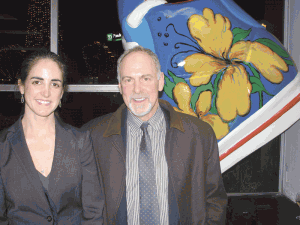 Organizers of the Art & Soles project, which brought colorful, five-foot-high sneakers to downtown Springfield, staged the official gallery opening for the celebrated footwear on Dec. 13 at 1351 Main St. Many of the artists were in attendance, as well as project coordinators and friends of the arts. At left, Evan Plotkin, president of NAI Plotkin, and Maryann Lombardi, director of Creative Economy at UMass Amherst and a program organizer, admire the works of art.
Organizers of the Art & Soles project, which brought colorful, five-foot-high sneakers to downtown Springfield, staged the official gallery opening for the celebrated footwear on Dec. 13 at 1351 Main St. Many of the artists were in attendance, as well as project coordinators and friends of the arts. At left, Evan Plotkin, president of NAI Plotkin, and Maryann Lombardi, director of Creative Economy at UMass Amherst and a program organizer, admire the works of art.  Below left, Nancy Urbschat, left, owner of TSM Design and a project organizer, admires some of the sneakers along with Sue Bader, a life insurance consultant with Epstein Financial.
Below left, Nancy Urbschat, left, owner of TSM Design and a project organizer, admires some of the sneakers along with Sue Bader, a life insurance consultant with Epstein Financial.  Below, artist Misha Epstein with her sneaker, a tribute to the historic homes in the McKnight section of Springfield. A resident of that area, she called her sneaker “In My Neighborhood,” and along the bottom, the word ‘home’ appears in 23 languages.
Below, artist Misha Epstein with her sneaker, a tribute to the historic homes in the McKnight section of Springfield. A resident of that area, she called her sneaker “In My Neighborhood,” and along the bottom, the word ‘home’ appears in 23 languages.
After 5
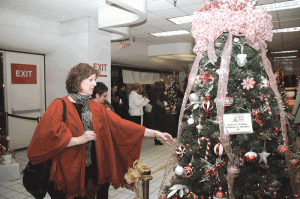 The Affiliated Chambers of Commerce of Greater Springfield staged their annual holiday After 5 event in Tower Square on Dec. 8. The event was held outside the Festival of Trees, giving attendees a chance to see this year’s collection and enter the raffle to win one of the dozens of entries.
The Affiliated Chambers of Commerce of Greater Springfield staged their annual holiday After 5 event in Tower Square on Dec. 8. The event was held outside the Festival of Trees, giving attendees a chance to see this year’s collection and enter the raffle to win one of the dozens of entries.  Far left, a visitor admires one of the trees. At left, Courtney Merrill greets visitors to the booth of Robert Charles Photography, one of the event’s sponsors.
Far left, a visitor admires one of the trees. At left, Courtney Merrill greets visitors to the booth of Robert Charles Photography, one of the event’s sponsors.
Tighe & Bond of Westfield recently promoted Christopher Bone, a Mechanical Process and Environmental Engineer, to Associate in recognition of his exceptional performance. He joined the firm in 1999 and has more than 17 years of project-management and engineering experience in providing municipal clients with innovative solutions for complicated water and wastewater challenges.
•••••
Dan Cohn has joined CornerStone Telephone Co. as an in-market Account Executive.
•••••
Hatch Mott MacDonald of Holyoke announced that Eliezer Barbosa has joined the firm as a Designer.
•••••
Linda Syniec, CPA, has joined S. Reichelt & Co., LLC. Syniec has more than 25 years of public-accounting experience, specializing in tax services for private companies and high-net-worth individuals.
•••••
Anne Mostue has joined public radio station WFCR and WNNZ as a reporter. Mostue will be based at WFCR’s Peggy and David Starr Broadcast Center in Springfield.
•••••
Massachusetts Five Colleges Inc. announced the following:
• Herbert Bernstein, Professor of Physics at Hampshire College, Amherst, has been named a Five College 40th Anniversary Professor; and
• Debbora Battaglia, Professor of Anthropology at Mount Holyoke College, South Hadley, has been named a Five College 40th Anniversary Professor.
A 40th Anniversary Professorship is an opportunity for veteran faculty members within the five campuses to share their expertise with students at other schools. During the three years of the professorship, each faculty member receives a research stipend, teaches at least three courses on other consortium campuses, and gives a public lecture on his or her work.
•••••
Garvey Communication Associates Inc. of Springfield announced the following:
• Laura Chechette has been appointed Public Relations Analyst.
•••••
Massachusetts College of Liberal Arts (MCLA) announced the following appointments to its Board of Trustees:
• William Dudley, Professor of Philosophy at Williams College. He has served on a range of college committees dealing with issues of educational policy, student and residential life, and diversity, and as an advisor to first-year students. He is a graduate of Williams, and earned his master’s and doctoral degrees from Northwestern University;
• Shirley Edgerton, Residential Program Director for the Department of Developmental Services of Berkshire County. In addition to this work, she is the founder of the Women of Color Giving Circle of the Berkshires, based in Pittsfield, as well as Youth Alive step dance program, which uses the arts as a vehicle to engage young women in educational and mentoring programs. She also serves as a board member for the Women’s Fund of Western Massachusetts. She holds a bachelor’s degree from Herbert Lehman College at the City University of New York, and a master of Education from MCLA; and
• Susan Gold, a member of the MCLA Foundation Board of Directors. Gold is an active community volunteer with experience and expertise in development and fund-raising who has worked with a number of organizations in Berkshire County, including Northern Berkshire Health Systems, the REACH Community Health Foundation, and Images Cinema. She serves as a trustee of the Massachusetts Museum of Contemporary Art. She has served as a member and officer of the MCLA Foundation Board of Directors, and co-chair of the Foundation Board’s ad-hoc Fundraising Committee. She earned a bachelor’s degree from American University.
•••••
Leslie Lawrence has been named Director of Lending for the Western Massachusetts Enterprise Fund in Holyoke.
•••••
David Rittenhouse has joined McCormick-Allum as manager of the electrical contracting division.
•••••
Lisa Doherty, Co-founder, President, and CEO of Business Risk Partners of Windsor, Conn. has been named to Business Insurance magazine’s list of “Women to Watch 2010.” Working with producers nationwide and partnering with global specialty carriers, the firm underwrites and administers professional and management liability policies for more than 160 professions in businesses of all sizes. The annual “Women to Watch” issue profiles 25 women executives based on recent professional achievements, influence on the marketplace, and contributions to the advancement of women in business.
•••••
Brenda D. Cuoco was recently recognized at Coldwell Banker for being a top producer within the Western Mass.area. She ranked 86th for units sold in Massachusetts and seventh for units sold within Western Mass.
•••••
Martin Luther King, Jr. Family Services recently honored several area residents for their community work during its ninth annual business partnership breakfast in Springfield. Honorees were:
• Hampden County Sheriff Michael J. Ashe Jr.;
• George Burtch, Vice President for Global Integration-Games at Hasbro;
• Jim Goodwin, President and Chief Executive Officer of Center for Human Development; and
• Tim Sneed, Executive Director of the Massachusetts Career Development Institute.
•••••
Kristina Drzal Houghton, a Partner with Meyers Brothers Kalicka, has been named one of three “Women to Watch” in the 2010 Experienced Leader category by the Massachusetts Society of Certified Public Accountants, in partnership with the American Institute of Certified Public Accountants’ Women’s Initiatives Executive Committee. The annual awards program highlights the achievements of women in the certified public accounting profession in Massachusetts who have made significant contributions to the profession and their community, and who demonstrate leadership within their profession.
•••••
Charles Epstein, Founder of The 401(k) Coach Program, was named to Legg Mason Inc.’s Retirement Advisory Council, a new think tank comprised of 14 retirement-industry leaders. The council will convene quarterly and examine the major challenges facing retirement products, service providers, and the best practices observed by the industry. Participants on the council include 401(k) plan providers, brokerage/financial-adviser leaders, retirement-plan advisers, and independent contribution-industry experts. Legg Mason, headquartered in Maryland, is a global asset-management firm with $677 billion in assets under management as of Oct. 31, 2010.
•••••
Delania Barbee has been appointed Community Engagement Coordinator and Massachusetts Promise Fellow for the ACCESS Springfield Promise program. The program works to increase college aspirations, access, and success among city students. It also provides free financial-aid advising and scholarships to young people in Springfield.
•••••
Sean Capaloff-Jones is the new Manager of Member Outreach for the UMass-Five College Credit Union. He will be responsible for member development and maintaining positive relationships with the credit union’s sponsor groups. He will also guide the credit union’s financial literacy program and community-outreach initiatives.
•••••
Rebecca Wylde has joined radio station Rock 102 as host for the 10 a.m. to 2 p.m. shift.
•••••
William J. Noonan has been named Director of Security for the Springfield Museums.
•••••
Robert P. Ziomek has been named Director of Major and Planned Gifts at Western New England College in Springfield.
•••••
Theodora “Teddy” W. Woeppel has joined the Goodman Speakers Bureau as Director of Marketing and Communications. She will develop and implement all online and Web-based marketing efforts and strategies for the bureau. She will oversee print, direct mail, sponsorships, and special-event marketing to increase business opportunities among the company’s national client base.
•••••
The Community Foundation of Western Massachusetts announced the election of new members to its Board of Trustees:
• Amy Jamrog, Managing Director of the Jamrog Group in Northampton;
• George C. Keady III, Senior Vice President and Branch Manager of UBS Wealth Management in Springfield;
• Robert L. Pura, President of Greenfield Community College;
• Peter J. Daboul, Executive in Residence at Western New England College, Springfield, who will serve as Chairman of the foundation’s trustees; and
• Sanford A. Belden, retired President of Community Bank System, who will serve as Vice Chair.
Affiliated Chambers of Commerce of Greater Springfield
www.myonlinechamber.com
(413) 787-1555
n Jan. 5: Business@Breakfast, 7:15 to 9 a.m., Sheraton Springfield. Cost: members $20, non-members $30. For reservations, contact Diane Swanson, ACCGS events manager, at (413) 787-1555 or [email protected]
n Jan. 19: Professional Women’s Chamber 13th Annual Business Expo, 11:30 a.m. to 1:30 p.m., Max’s Tavern, MassMutual Room. Cost, Table Top: members $60, non-members $90 (includes one lunch ticket). Cost, lunch only: members $25, non-members $35. For reservations, contact Lynn Johnson PWC liaison, at (413) 755-1310 or [email protected]
n Jan. 22: West of the River Chamber of Commerce Night at the Falcons, 7:30 p.m., MassMutual Center. Cost: $10. For reservations, call Chris Thompson at (413) 739-3344 ext. 109.
Young Professional Society of Greater Springfield
www.springfieldyps.com
n Jan. 20: Third Thursday, 5 to 8 p.m., Panana’s Restaurant, Agawam. Cost: free for members, non-members $10. Includes food and cash bar.
Amherst Area Chamber of Commerce
www.amherstarea.com
See the chamber’s Web site for information on upcoming events.
Chicopee Chamber of Commerce
www.chicopeechamber.org
(413) 594-2101
n Jan. 19: Salute Breakfast, 7:15 to 9 a.m., MassMutual Learning & Conference Center, 350 Memorial Dr., Chicopee. Cost: members $18, non-members $25. For tickets, call the chamber at (413) 594-2101 or purchase online at www.chicopeechamber.org
Franklin County Chamber of Commerce
www.franklincc.org
(413) 773-5463
See the chamber’s Web site for information on upcoming events.
Greater Easthampton Chamber of Commerce
www.easthamptonchamber.org
(413) 527-9414
n Jan. 13: Networking By Night Business Card Exchange, 5 to 7 p.m., hosted and sponsored by Harley-Davidson of Southampton, 17 College Highway, Southampton. Co-sponsor: Puffer Printing & Copy Center. Door prizes, hors d’ouevres, host bar. Cost: members $5, non-members $15.
n Jan. 27: Greater Easthampton Chamber of Commerce Annual Meeting and 50th Anniversary Dinner, 5 p.m., the Delaney House, 500 Country Club Road, Holyoke. Cranberry chicken and halibut combo luncheon. Cost: members $29.95, non-members $32.95.
Greater Holyoke Chamber of Commerce
www.holycham.com
(413) 534-3376
n Jan. 12: Winner Circle, 5 to 7 p.m., Yankee Pedlar, 1866 Northampton St., Holyoke. Sponsored by Holyoke Medical Center; Dowd Insurance; Resnic, Beauregard, Waite & Driscoll; PeoplesBank; Holyoke Community College; and Universal Plastics.
n Jan. 19: Chamber After Hours, 5 to 7 p.m., hosted and sponsored by Homewood Suites, 375 Whitney Ave., Holyoke. Cost: members $5, non-members $10 cash.
n Jan. 25: Computer Security Seminar, 8 to 11 a.m., Mass Mutual Conference Center, Chicopee
Greater Northampton Chamber of Commerce
www.explorenorthampton.com
(413) 584-1900
n Jan. 12: January Arrive @ 5, 5 to 7 p.m., Volkswagen of Northampton, 968 Bridge Road, Northampton. Cost: $10 for members.
Northampton Area Young Professional Society
www.thenayp.com
(413) 584-1900
n Jan. 30: Bowl with a Purpose, 12 to 2 p.m., Spare Time, 525 Pleasant St., Northampton. Charity fund-raiser. Teams of four to six players. Registrants can register as a team or be placed on a team. Cost: $20 pre-registered, $25 at the door. Includes unlimited bowling during the event, shoe rental, pizza, and soda. For registration information, visit www.thenayp.com
Quaboag Hills Chamber of Commerce
www.qvcc.biz
(413) 283-2418
See the chamber’s Web site for information on upcoming events.
South Hadley/Granby Chamber of Commerce
www.shchamber.com
(413) 532-6451
n Jan. 25: President’s Dinner, cocktails at 5:30 p.m., dinner at 6:30 p. m., Willitts-Hallowell Center, Mount Holyoke College. Sponsors: premier members. Special guest speakers: TBD. Annual business meeting. Cost: $37. Check must be received by Jan. 21.
Three Rivers Chamber of Commerce
www.threeriverschamber.org
413-283-6425
See the chamber’s Web site for information on upcoming events.
Greater Westfield Chamber of Commerce
www.westfieldbiz.org
(413) 568-1618
See the chamber’s Web site for information on upcoming events.
For Many Locally, There Is Room for Cautious Optimism

Lym Tech Scientific will soon be moving into this building on Westover Road in Chicopee, an acquisition that is one of many positive signs for the local economy.
He told BusinessWest that the evidence comes in the form of remarks and unspoken thoughts that come with conversations he has with prospective clients, specifically couples looking at major home-renovation projects or new-home-building initiatives.
“You sit with a couple, and whether it’s a remodeling job — a kitchen, family room, bedroom, whatever — or a new house, she’s saying, ‘we need to get this done,’ and he’s saying, ‘I’m not sure this is the right time to do it,’” said Pecoy, owner of Kent Pecoy & Sons Construction. “And she starts kicking him under the table, saying, ‘we can’t put this off any longer — the kids will be out of the house by the time we get this done.’”
While acknowledging that there is some stereotyping going on with this anecdote, Pecoy said it serves to make his point — that, during recessions, and especially this past one, couples will put off things as long as they can. The fact that the under-the-table kicking is prompting more husbands to say ‘yes’ to such projects means that many people really can’t wait any longer, but they also have the confidence to move ahead.
This is especially true with remodeling, he continued, adding that this segment of his business now accounts for far more than 50% of revenues, not the breakdown he’d like — he’d much prefer to build new, high-end homes — but he’s happy that at least one aspect of his operation is seeing an uptick, and that he’s getting more of his time-honored evidence that times are getting better.
Others involved in business and economic development say they don’t have such a tell-tale sign that a recession is winding down. For them, things are somewhat murkier. Indeed, there is still considerable uncertainty about if, when, and to what extent things will improve. There is, however, general agreement that 2010 was a real struggle, and the year ahead should yield some improvement, but this will be, by and large, a mostly jobless recovery.
“We predicted 2010 to be this kind of year; we were hoping it wouldn’t be, but we predicted it would be, in terms of land sales in our development corporations and general absorption of real estate,” said Allan Blair, president and CEO of the Economic Development Council of Western Mass. “We thought there would be a slowdown in layoffs in 2010 and there was, but we also thought the job growth would be slow, and it was. So as disappointing as all this was, it wasn’t a surprise to us.
“It looks as though the layoff situation has bottomed out, so that jobs appear to be stable, but there are a lot of unemployed people out there who are going to be struggling to find employment equal to what they left,” he continued. “They’re going to have a hard time — it’s going to be a real struggle for a lot of people, which is going to create a lot of problems for our communities and our citizens. The government is spending what it can to retrain and reposition people, but the business environment isn’t responding fast enough to absorb them.”
Russell Denver, president of the Affiliated Chambers of Commerce of Greater Springfield, said some sectors have performed better than others in 2010, and that uneven performance will likely continue in the year ahead as players in different industries respond — or don’t — to the conditions.
“It’s been a mixed bag … there is not general economic growth spread evenly among the business community. It entirely depends on what sector you’re in,” said Denver. “I’ve heard that temporary employment agencies are having a good year, and some advertising agencies are having a good year, and some architectural firms are enjoying better times.”
“Companies are becoming much more efficient, much more productive, and, interestingly, the companies that are hiring are having a difficult time finding the right person,” he continued. “People attribute this to the fact that, even a few years ago, people were willing to leave one company to go to another; now, many of the people are hunkering down, afraid to leave for another position, because the grass is not always greener on the other side, and if there’s a layoff, they may not get employed again very quickly.”
Hire Ground
Looking back on 2010, Blair said that, while it came off as predicted — rather unremarkable in terms of real growth — there were some positive developments.
At the top of that list would be the groundbreaking for the high-performance computing center, a project that has many question marks in terms of overall impact, especially with jobs, but enormous potential to spark other economic development.
“The Holyoke high-performance computing center is something that we’re looking forward to understanding, as far as the economic impact is concerned,” said Blair. “But the fact that this is happening, and with those particular players, is encouraging to say the least, and we’re optimistic that we have something to rally around in terms of that digital technology cluster, and can see what we have here.”
Movement with regard to identifying clusters and facilitating their growth was another of the bright spots in 2010, Blair continued, noting the hiring of the EDC’s first ‘manager of cluster development,’ Michael Wright (see related story, page 6).
Still another was some signs of movement on absorption of some of the vast amounts of commercial and industrial inventory now on the market, a situation that is no doubt contributing to the lack of new building in the EDC industrial parks and similar facilities across the region.
Bill Wright, president of Lym Tech Scientific, a manufacturer of cleanroom wipes, is responsible for some of that absorption. His company, which has been based in several smaller buildings at the Cabotville Industrial Park complex in Chicopee, recently acquired the 78,000-square-foot building at 2245 Westover Road that was most recently home to Engineered Polymers, and is slated to move in next month.
Wright said the move was necessitated by the need for more space and also better space — the multiple floors at Cabotville are not conducive to efficient operations — but also by confidence that the company would continue its recent growth pattern.
“I hope the economy stays on track,” said Wright. “It appears to be a jobless recovery, but we seem to have found some pockets of business that work OK for us. It’s tough to make predictions about the local economy and employment, though.”
Indeed, it is, said Jim Barrett, manager partner for the Holyoke-based accounting firm Meyers Brothers Kalicka, who hears from clients every day about the economy and how it is impacting business.
‘Cautious optimism’ was a phrase Barrett used repeatedly as he talked about 2011 and his clients’ prospects for stability, growth, and additional hiring.
“Some people are up this year, but most all business owners are thinking hard about whether they should bring back people,” he told BusinessWest. “They’re paying people overtime, things are looking up, but credit is still tight, and there are outside factors impacting specific industries, like health care reform and medical practices; there are a lot of question marks.
“With certain sectors, like manufacturers and retailers, things are looking better, but they’re not yet ready to commit a lot of capital to expansion, because they’re just not sure,” he continued, hitting on one of the variables that will certainly define progress in the year ahead: business confidence. “Some of them are, but most people are still very cautious about spending, and that includes hiring.”
Elaborating, he said many of the staffing agencies the firm represents are reporting growth in 2010, which is a good sign for the overall economy. This uptick means that, while companies might be reluctant to bring people on full-time, they are adding temporary help or paying overtime, which are big steps in the right direction (see related story, page 22).
“Some employers have people working overtime, which is always a good sign,” he said. “They’re paying OT and using temps, which is one step before actually hiring someone. Instead of hiring the staff in anticipation of the work coming, people are waiting for the work to come in, and then they’re hiring staff and they’re augmenting with temporary help or overtime.”
Watch Words
Denver said he’s also observed some improvement in various sectors. Like Barrett, he’s buoyed by the improved health of staffing agencies, but also sees rays of optimism in the growth of some marketing agencies and even architectural firms.
The former indicates that companies that have cut back on their marketing — one of the first areas to be trimmed when times are tough — are putting some dollars back in that area. As for the latter, it provides some glimmers of hope for the construction sector, one of the hardest-hit industries in the region.
Overall, Denver said 2010 was not a year of big, positive headlines in the business community, but of many important success stories. He listed the high-performance computing center, construction of Baystate Medical Center’s $251 million Hospital of the Future, more progress on the State Street corridor in Springfield and also in the South End and downtown, and the start of construction of the new data center in the old Technical High School on Elliot Street.
Many of the positive developments in 2010 were funded, or assisted, with federal stimulus money, said Denver, adding that as this pipeline dries up, which it is expected to do in the months ahead, there may be a negative impact on recovery and the rate of same.
“Government propping up the economy was the story of 2010,” he said. “And now those funds are running out. What happens without federal stimulus, or far less stimulus money, may well be the most significant story of 2011.”
Evan Plotkin knows what he would like the biggest story of the year ahead to be — more visible evidence of progress in Springfield’s central business district, a goal that has become somewhat of a passion for the president of NAI Plotkin.
While noting that the commercial real-estate market remains sluggish amid some signs of improvement, Plotkin said 2010 was a year in which downtown revitalization efforts took steps forward, through everything from the retenanting of the old federal building to the popular Art & Soles program that brought dozens of colorful, five-foot-high sneakers — and some additional vibrancy — to the downtown.
And 2011 may yield more positive developments with projects ranging from revitalization of long-dormant Union Station to ongoing efforts to bring more market-rate housing in locations such as Court Square, the Bowles Building, and others.
“I’m excited that developments like Union Station are getting to a point where people are developing those properties,” said Plotkin. “There’s been a lot of talk, and it’s been very frustrating for many years, but we’re at the end of the discussion phase, and I think we’re at the point where we’re ready to pull the trigger and get started on some of these projects.
“If we convert some of the buildings downtown into market-rate housing, and if we start to do some of these other cultural things that people have been talking about for some time,” he continued, “we’re going to start to see a whole new Springfield emerge.”
The Finish Line
If Pecoy is right, and the recession is not just technically over but really behind us, then more wives will be kicking their husbands under the table in the months ahead, urging them to move ahead with major renovation plans.
Area business owners and economic-development leaders will be looking for these and other signs — real and metaphorical — over the course of a year that seems destined to be defined by more uncertainty.
But it will be one that should, by most accounts, anyway, bring some much- anticipated improvement for a region that is still, in many ways, digging out from the Great Recession.
George O’Brien can be reached at
[email protected]
International EC Acquires MacDuffie School
SPRINGFIELD — Representatives of the MacDuffie School recently announced the planned sale of all school operations, not including the school’s city real estate, to International EC LLC, the group that acquired the former St. Hyacinth seminary campus in Granby in June. International EC is establishing an independent school in Granby and will absorb MacDuffie’s curriculum, corporate identity, intellectual property, furnishings, computers and business equipment, and faculty as it establishes a school serving grades 6 through 12 beginning next fall. The school, currently in its 120th year of operation, will continue as a day and boarding school. Massachusetts attorney-general approval is needed since the sale involves a nonprofit entity, the MacDuffie School, being acquired by a privately held company. Michael A. Serafino, chairman of MacDuffie’s Board of Trustees, noted in a statement that the acquisition “represents an exciting new chapter in MacDuffie’s history, offering the student body a larger campus with enhanced classroom space, outstanding boarding facilities, state-of-the-art technology, and athletic fields in a college-preparatory environment with high academic standards.” Serafino added that, in the highly competitive academic marketplace for private middle and secondary schools, “this move represents a chance to expand and promote the MacDuffie mission in a way that our current location, with space and infrastructure limitations, would not allow.” The sale of assets does not include the campus on Ames Hill Drive, and a workgroup has been established to ensure that the campus is maintained and secured after the school’s operations move to Granby. Efforts to prepare the campus for sale have started, according to Serafino. International EC, LLC has three managing partners — Craig Brewer, who currently oversees a large private high-school program for international students in the U.S.; Wayne Brewer, who is currently the CEO of International Student Exchange, and Dal Swain, the owner and president of FLS, which has a network of ESL schools for foreign students.
More Than 3,700 Sack Hunger at Big Y
SPRINGFIELD — In a chain-wide effort to help the hungry within their local communities, all Big Ys have initiated this year’s Sack Hunger program. The program consists of a large, green, reusable grocery bag filled with staple non-perishable food items selected by the food banks. Customers purchase a pre-assembled bag for $10, and Big Y then distributes the bags to that region’s local food bank. In turn, the food banks distribute the filled sacks to area soup kitchens, food pantries, senior food programs, day-care centers, as well as many of their other member agencies. All of the donated sacks will be distributed within the supermarket’s marketing area, so every donation stays within the local community. The Sack Hunger Campaign began Nov. 8 and will run through the rest of this year. So far, almost 4,000 bags have been sold. All five food banks within Big Y’s marketing area will be participating in Sack Hunger. These food banks represent more than 2,100 member agencies throughout the region. They are the Food Bank of Western Massachusetts, the Greater Boston Food Bank, the Worcester County Food Bank, Foodshare of Greater Hartford, and the Connecticut Food Bank. The sacks include the following non-perishable Big Y items: corn flakes, long-grain rice, elbow macaroni, kidney beans, peanut butter, cut green beans, sweet peas, whole kernel corn, chunk light tuna, and quick oats. Sacks are available at all Big Y Supermarkets and Fresh Acres. Big Y hopes to provide at least 5,000 bags to area food programs by the end of the program.
WMECo Starts Construction on Reliability Project
SPRINGFIELD — Western Massachusetts Electric Company (WMECo) recently broke ground for the Greater Springfield Reliability Project, a $795 million transmission upgrade designed to strengthen the region’s power grid, meet mandatory reliability standards, and allow power to move more freely around the Greater Springfield and North-Central Conn. area. Construction on the project has started at the new Cadwell Switching Station in Springfield and at the existing Agawam Substation. Construction of the overhead transmission line in Massachusetts is expected to begin on existing rights of way in early 2011. The creation of approximately 1,000 jobs is anticipated at the peak of construction, while adding about $11 million in much-needed tax revenues to towns along the project route. The project includes work along 39 miles of an existing transmission right of way between Ludlow and Bloomfield, Conn. The 27-mile portion in Massachusetts includes new 345-kilovolt (kV) transmission lines, new and reconstructed 115-kV lines, two new switching stations, and several substation upgrades. In Connecticut, construction is expected to begin with a substation upgrade in Bloomfield in mid-2011, and construction of the overhead line is expected to begin in late 2011. The project is expected to be in service in 2013. For more information about the initiative, visit www.neewsprojects.com
LENOX Earns OSHA ‘Star’
EAST LONGMEADOW — LENOX has been recertified for an additional five years in the prestigious ‘Star’ Voluntary Protection Program (VPP) of the U.S. Labor Department’s Occupational Safety and Health Administration (OSHA). LENOX has maintained this elite health-and-safety certification for more than 10 years. OSHA’s verification for the Star certification includes an application review and a rigorous on-site evaluation by a team of OSHA safety and health experts. In 1997, LENOX became the first cutting-tool company in the country to receive this honor. Since then, LENOX has earned recertification in 2000, 2005, and now in 2010. Sites that make the grade must submit annual self-evaluations and undergo periodic onsite re-evaluations to remain in the programs. The plant, which employs 720 workers, manufactures power-tool accessories and blades including band-saw blades, hack saws, hole saws, utility knives, and reciprocating saw blades. The VPP promotes effective worksite-based safety and health, according to Mike Avery, director of safety and security for LENOX.
Langone’s Florist Opens at Tower Square
SPRINGFIELD — Brent Bertelli, owner of Langone’s Florist, recently signed a lease to take the former Longmeadow Flowers space located on the street level of Tower Square. This new endeavor is the second Langone’s Florist operation. The original store, located at 838 Main St., has been family-owned and operated since 1967. Bertelli said he hopes to expand the business and offer more products and services to the downtown clientele through the new location. Langone’s Florist offers custom florals, tropical plants, silk arrangements, seasonal décor, and a diverse collection of gifts.
Fallon Supports
Hunger-relief Programs
WORCESTER — Fallon Community Health Plan recently distributed more than $170,000 to dozens of designated food pantries and hunger-relief programs throughout Massachusetts. The donations represent the total net proceeds from its annual fund-raising event in September. This year’s record-breaking result is due to the participation of 96 organizations that generously contributed to the effort. Organizations specifically recognized for their donations include Booz & Co., CVS Caremark, the Revere Group, Epstein Becker & Green, Fallon Clinic, Acton Medical Associates, Beacon Health Strategies, Income Research & Management, and Protector Group. Fallon will support the following regional hunger-relief programs: Alliance to Develop Power, Springfield; Amherst Survival Center; Berkshire Community Action Council, Pittsfield; Christian Pentecostal Church, Holyoke; Elder Services of Berkshire County Inc., Pittsfield; Gandara Mental Health Center, West Springfield; Jubilee Cupboard, Ware; Lorraine’s Soup Kitchen & Pantry, Chicopee; Open Pantry Community Services Inc., Springfield; Providence Ministries for the Needy Inc., Holyoke; Western MA Labor Action, Pittsfield; and the Westfield Food Pantry. Founded in 1977, Fallon is a national, not-for-profit health-care-services organization.
Baystate Rug and Flooring Receives Honor
CHICOPEE — Baystate Rug and Flooring was recently awarded the honor of being Mohawk Industries’ North American Flooring Store of the Year. Mohawk Industries awarded the firm the prestigious award based on criteria including sales, growth, marketing techniques, product knowledge, community service, and best practices. Baystate Rug competed regionally, winning the title of Northeast Flooring Store of the Year, before winning the national championship for all of Canada and the U.S. Joseph Montemagni, president of Baystate Rug, noted that, in order to qualify, “Mohawk evaluated our store’s business practices, our employees’ training, their product knowledge, and reviewed our commitment and involvement in our community.” Baystate Rug is a family-owned flooring company that specializes in retail and commercial flooring, installation, and decorating services. A diversified product selection includes carpet, ceramics, hardwoods, resilient, laminate, green flooring products, area rugs, and window treatments.
Bradley’s Paradies Shops Receive Awards
WINDSOR LOCKS, Conn. — Bradley International Airport’s prime retailer, the Paradies Shops, was recently honored with several awards recognizing its top-performing managers and first-class associates at the company’s annual management seminar and vendor show in Georgia. The seminar celebrates the accomplishments of managers and both customer-facing and support-level associates who exemplify the company’s mission statement “to exceed the expectations of the customers and business partners we serve.” The Paradies Shops has operated at Bradley for almost 25 years, serves 78,000 customers per month, and runs six retail stores at the airport. Its team at Bradley, led by General Manager Deb Donahue, received numerous awards, including Best Customer Service, Best 401(k) Participation, and the coveted Public Relations Award. These honors are considered qualifying awards and are the basis for the revered awards that recognize the best of the best within the company. Taking home the top honors as one of four Executives of the Year was Judy Heit, a regional merchandise planner based at Bradley. Additionally, Patty Tucker, also of Bradley International, was selected as one of three Assistant Managers of the Year. The Paradies Shops, a family business established in 1960, operates more than 500 stores in more than 70 markets across the U.S. and Canada.
Listings for December 20, 2010
Please click here
Commercial Real Estate BW12.10b
Send photos with a caption and contact information to: ‘Picture This’
c/o BusinessWest Magazine, 1441 Main Street, Springfield, MA 01103
or to [email protected]
Festival of Trees




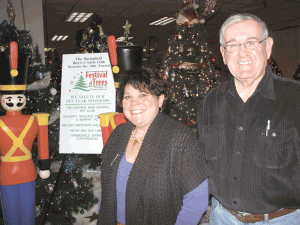 The Festival of Trees, the annual fundraiser to benefit the Springfield Boys & Girls Club, will continue through Dec. 12 in the meeting room on the second level of Tower Square. More than 100 trees, donated and decorated by businesses, civic and social organizations, schools, hospitals, families, and individuals, are now on display for this, the 10th annual festival. Visitors can purchase raffle tickets for chances to win a tree. Below, Boys & Girls Club Executive Director Gary McCarthy and Barbara Kolosowski, the agency’s director of Development, stand in front of a section set aside for those businesses and groups that have been part of the festival all 10 years.
The Festival of Trees, the annual fundraiser to benefit the Springfield Boys & Girls Club, will continue through Dec. 12 in the meeting room on the second level of Tower Square. More than 100 trees, donated and decorated by businesses, civic and social organizations, schools, hospitals, families, and individuals, are now on display for this, the 10th annual festival. Visitors can purchase raffle tickets for chances to win a tree. Below, Boys & Girls Club Executive Director Gary McCarthy and Barbara Kolosowski, the agency’s director of Development, stand in front of a section set aside for those businesses and groups that have been part of the festival all 10 years.
.
Giving Tree


Children from Greater Springfield recently helped launch the 26th Hasbro Children’s Giving Tree program at Eastfield Mall. Through the program, toys and games are donated by Hasbro Inc. and distributed to underprivileged children by the United Way of Pioneer Valley; food is collected by the community and distributed to families in need by the Food Bank of Western Massachusetts; and community members sprinkle the region with ‘Acts of Kindness.’ At left, at the kickoff event, Springfield Mayor Domenic J. Sarno connects with area children on their level. At right, Gabriel Marchetti, 9, of Warner Elementary School of Springfield, hangs his ‘Act of Kindness’ message on the tree.
.
Business Award Winners

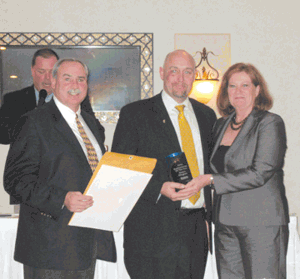
 The Greater Westfield Chamber of Commerce staged its annual meeting last month at Tekoa Country Club, an event that featured a presentation from Mayor Daniel Knapik about the future of the city, an introduction of the new 2011 chamber officers and board members, and the 2010 Business Awards presentation. Clockwise from above left: incoming Board Chairman Bill Parks, left, and outgoing Chair Kathleen Witalisz congratulate Jim Kaufman, president of Jenn-Coat, the 2010 Business of the Year; Burke and Witalisz congratulate Sean Hogan, president of Hogan Communications, the Business Man of the Year for 2010; members of the design team at Stevens 470, the 2010 Small Business of the Year, from left, Robert Burch, Web developer; Tina Stevens, principal and creative director; Kathleen Doe, senior graphic designer and studio director; Allison Gray, graphic designer; and Justin Friend, senior Web developer.
The Greater Westfield Chamber of Commerce staged its annual meeting last month at Tekoa Country Club, an event that featured a presentation from Mayor Daniel Knapik about the future of the city, an introduction of the new 2011 chamber officers and board members, and the 2010 Business Awards presentation. Clockwise from above left: incoming Board Chairman Bill Parks, left, and outgoing Chair Kathleen Witalisz congratulate Jim Kaufman, president of Jenn-Coat, the 2010 Business of the Year; Burke and Witalisz congratulate Sean Hogan, president of Hogan Communications, the Business Man of the Year for 2010; members of the design team at Stevens 470, the 2010 Small Business of the Year, from left, Robert Burch, Web developer; Tina Stevens, principal and creative director; Kathleen Doe, senior graphic designer and studio director; Allison Gray, graphic designer; and Justin Friend, senior Web developer.
.
Art Auction

 The Balise Lexus Art Auction to Benefit Autism Speaks was held Nov. 19 at the Balise Lexus in West Springfield. At left, Balise Vice President Mike Balise and event organizer Crystal Childs auction off an authentic, autographed photo of Ted Williams. At right, attendees admire the various works of art.
The Balise Lexus Art Auction to Benefit Autism Speaks was held Nov. 19 at the Balise Lexus in West Springfield. At left, Balise Vice President Mike Balise and event organizer Crystal Childs auction off an authentic, autographed photo of Ted Williams. At right, attendees admire the various works of art.
.
Pynchon Awards
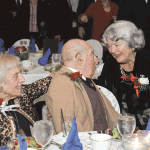
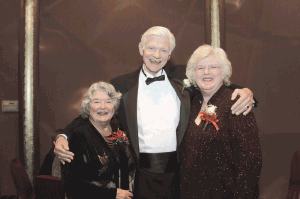 The Ad Club of Western Mass. inducted three individuals into the Order of William Pynchon at its 96th annual Pynchon Awards on Nov. 18. The honor is bestowed to people who have demonstrated exceptional community service with compassion, humility, and grace. At right, 2010 Pynchon Medalists, from left, Barbara Bernard, York Mayo, and Mary Reardon Johnson. Above, past Pynchon medalists Anne Cooley, left, and Judge Sidney Cooley congratulate Bernard.
The Ad Club of Western Mass. inducted three individuals into the Order of William Pynchon at its 96th annual Pynchon Awards on Nov. 18. The honor is bestowed to people who have demonstrated exceptional community service with compassion, humility, and grace. At right, 2010 Pynchon Medalists, from left, Barbara Bernard, York Mayo, and Mary Reardon Johnson. Above, past Pynchon medalists Anne Cooley, left, and Judge Sidney Cooley congratulate Bernard.
The following building permits were issued during the month of November 2010.
AGAWAM
Derrick Turnbull
300 North West St.
$10,000 — Exterior renovations
AMHERST
Amherst College
Goodnow House
$13,600 — Re-roof
Hampshire College
711 West St.
$8,650 — New roof
Lambda Chi Alpha Properties Inc.
374 North Pleasant St.
$17,000 — New roof
Yosrex Limited Partnership
266 E. Hadley Road
$24,000 — New roof
CHICOPEE
TRC Global Solutions Inc.
22 Benefit St.
$25,000 — Add floor joists to cellar area
GREENFIELD
Chapman Street Realty
14-16 Chapman St.
$13,000 — Replace roof
Franklin Medical Center
164 High St.
$48,000 — Renovate laboratory
Franklin Regional Transit Authority
12 Olive St.
$7,340,000 — Erect intermodal transit center and office building
The Theodore Leonard House, LLC
116 Federal St.
$9,000 — Replace rear roof
HADLEY
Jeremy Ober
12 Russell St.
$4,600 — Exterior renovations
Peter Grandonico
104 Russell St.
$58,200 — Change office partitions and add a bathroom
HOLYOKE
Rita K. Milos
555 High St.
$48,000 — Install new roof
LUDLOW
Lisa’s Hair Shop
200 Center St.
$10,000 — Interior renovations
Ludlow Housing Authority
96 Aldo Dr.
$2,500 — Replace door
NORTHAMPTON
Linda Rainville
33 Market St.
$4,100 — Install new roof
Maplewood Shops, Inc.
2 Conz St.
$10,000 — Replace rotted sill plates and damaged floor joists
Seven Day Adventists Church
35 North Main St.
$13,300 — Replace front entry steps
Packaging Corporation of America
525 Mount Tom Road
$377,000 — Install new roof
Perstop Compounds, Inc.
238 Nonotuck St.
$19,000 — Repair portion of north wall
SOUTHWICK
John Whalley
42 Powder Mill Road
$37,000 — Construct new maintenance building
SPRINGFIELD
Baystate Health
2 Medical Center Dr.
$432,000 — Fit out 3,000 square feet of office space on the second floor
Mercy Hospital
271 Carew St.
$210,000 — Complete renovation in OR suite
Peter Picknelly
330 Park Dr.
$76,000 — Construct new building to be used as pool house
Spanish Christian Church
565 Chestnut St.
$20,000 — Build handicap ramp
Springfield Florist Supply
18 Morgan St.
$84,000 — New roof
Suzanne D. Morris
29 Logan St.
$45,000 — New roof
WESTFIELD
City of Westfield
149 Neck Road
$48,000 — Commercial alteration
Continental Cable
1116 East Mountain Road
$9,200 — Alteration
WEST SPRINGFIELD
Common Ground Holding, Inc.
25 Park Ave.
$3,000 — Renovate first floor of existing restaurant
Naif Makal/New England Retail
139 South Main St.
$990,000 — Construct a new 11,300-square-foot CVS retail store
Taking Lessons — and Inspiration — from North Carolina
A group of 40 business and civic leaders from Greater Springfield were in two North Carolina municipalities — Winston-Salem and Greensboro — last week as part of the City to City program. As the name suggests, participants travel from one city to another, but they also take ideas and, hopefully, inspiration and determination back home. There were myriad thoughts expressed about what Springfield could learn from this excursion, but commentary centered around creating vibrancy downtown, focusing on steps to keep more young people in the 413 area code, crafting a more regional approach to economic development, and, perhaps most importantly, creating more positive energy in the City of Homes.Allen Joines was explaining — sort of — just how it came to be that 40 business and civic leaders from Greater Springfield were having breakfast at the Marriott in his city, Winston-Salem, N.C., listening to him talk about economic development, downtown revitalization, and generating business diversity.
“The closer you get to the guillotine, the more you start to focus,” joked Joines, now in his ninth year as mayor of this city of 220,000, located about an hour from Charlotte.
‘Focus’ is a very general, perhaps overly simplistic way to describe what the leaders of Winston-Salem, or WS, as it’s called, did when, about 20 years ago, the bottom simply fell out of an economy based on tobacco, textiles, and furniture manufacturing, all industries on the decline. “We lost more than 10,000 jobs in about 18 months,” said Joines, who was then economic development director for the community. “In just a few years, RJ Reynolds [the tobacco giant headquartered in the city] went from 16,000 employees to under 3,000.”
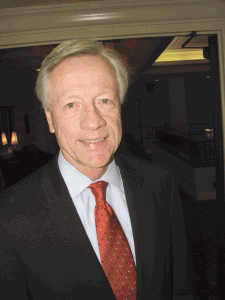
Winston-Salem Mayor Allen Joines says his city has been quite resilient, bouncing back from a series of economic calamities.
Today, the manufacturing sector that once accounted for 45% of the jobs in Greater Winston-Salem now provides roughly 14%. Dramatic gains have been made in health care (now the largest employer), the biosciences (much of it happening at the Piedmont Triad Research Park created in the heart of downtown), the broad field of design, logistics and distribution, and others. Meanwhile, the city is making major strides in its efforts to become a center for something called regenerative medicine, or the engineering of tissue and organs (more on that later).
Over the past few years, the city has successfully attracted FedEx, which has built a regional air hub at nearby Piedmont Triad International Airport; prevailed in an intense competition to land a $426 million Caterpillar assembly plant; built a new baseball stadium downtown (not without controversy); opened dozens of new restaurants in the central business district; lowered its high-school dropout rate, and earned status as one of the few cities across the nation to curb, and actually reverse, the so-called brain drain.
All this and more explains why those 40 leaders from Greater Springfield were in the Bethabara Room at the Marriott for the opening act of a program called City to City, where representatives of one (usually distressed) municipality visit another — to see, hear, ask questions, and, hopefully, take back some ideas and inspiration. Winston-Salem was chosen, said Ron Ancrum, president of the Community Foundation of Western New England and organizer of this junket, because it is like Springfield in many ways, including size, demographics, its status as a former manufacturing center, and recent challenges. Greensboro, a slightly smaller city 30 miles to the east, was chosen for the same reason.
A day after hearing about Winston-Salem’s progress, the Western Mass. contingent learned how Greensboro had waged a similar comeback in the face of deep losses in manufacturing jobs.
Reflecting on what they had absorbed in Winston-Salem on day two of the junket, participants had varying thoughts on what could be taken away.
Paul Robbins, president of the Wilbraham-based marketing and public-relations firm that bears his name, said the progress Winston-Salem has made in its downtown — with regard to everything from housing to new restaurants — and the resulting improvement in the retention of young people should prompt Springfield officials to redouble their efforts in that realm.
Meanwhile, Maryann Lombardi, director of Creative Economy for UMass Amherst, came away impressed not only with the large role the arts has played in economic development in Winston-Salem, but also how Wake Forest University, located within the city, has been part of virtually every initiative mentioned by leaders in that community and is a true “economic engine.”
Russ Denver, president of the Affiliated Chambers of Commerce of Greater Springfield, joked that he loved the city’s $11 commercial tax rate, less than one-third Springfield’s levy, and thought officials in the City of Homes might try such a number. Turning serious, he had high praise for the vision and creativity it took to put a 200-acre research park downtown.
Sally Fuller, project director for the Davis Foundation, was among many to observe that the overwhelmingly positive attitude and can-do philosophy in Winston-Salem stood in stark contrast to the negativism that she says prevails in Springfield and stifles progress.
Her remarks prompted many to nod in agreement, and Denver to summon a remark made by one of those carrying out the Urban Land Institute study on the city several years ago. “He said, ‘some people see the glass as half-full, others see it as half-empty; in Springfield, people believe they don’t even have a glass.’”
For this issue, BusinessWest recaps the City to City experience, focusing mostly on Winston-Salem, and on what participants want to take back from Tobacco Road. Their comments speak volumes about just how much work needs to be done in Springfield.
Changing the Landscape
Gayle Anderson says she’s like most chamber of commerce directors. She tracks what people say and write about her community, and takes great pride in placement on those ‘best of’ and ‘top 25’ lists that publications like to put together.
So she has a lot to be proud of these days, because WS is on many such compilations, including:
• ‘One of the Best Places to Live and Launch’ from 2008 in Fortune Small Business;
• The ‘Top 25 Places for Business and Careers’ as compiled by Forbes in 2009;
• The ‘Top 25 Locations for Biotech’ as assembled by Business Facilities magazine in 2009; and
• The ‘Top 7 Intelligent Communities in the World’ as compiled by the Intelligent Community Forum in 2008.
Meanwhile, the New York Times reported earlier this year that WS is one of only 14 cities across the country with more college graduates moving in than moving out, and North Carolina was listed on the most recent ‘Top Destination States for People Relocating’ list put together by United Van Lines.
“We didn’t get all of those people, obviously, but we certainly got our share,” said Lombardi, who like Mayor Joines and others, said Winston-Salem has come a long way over the past 20 years, and even a decade ago, when West Fourth Street, on which the WS chamber is located, was, in her words, “dead as a doorknob.”
How the business district, and the city as a whole, has come back to life, is a compelling story, one that placed WS in a 23-page report authored by Federal Reserve Bank of Boston called “Lessons from Resurgent Cities,” and garnered the attention of Ancrum as he and others considered possible destinations for a City to City tour involving Springfield area leaders.
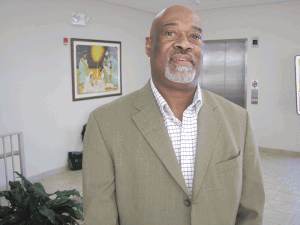
Ron Ancrum says the City to City tour was a learning expereince, but also a chance for participants to get to know one another so that they might better work together to implement what they've learned.
Several destinations were considered for the City to City experience, Ancrum continued, noting that two in New England — Providence and New Haven — while meritorious, were rejected because the committee planning the program thought it would be difficult to get business leaders to commit to a three-day itinerary, which is the preferred length of such visits, in cities so close to home.
After considering Jersey City, N.J., a community in Michigan, and several others, the planning committee chose Winston-Salem and Greensboro because of both geography and their many similarities to Springfield. The tour would ultimately have four learning focal points: education, economic development, arts and culture, and public safety.
Ancrum said he and others had many goals in mind when they put the trip together. First among them was providing a learning laboratory of sorts, but there was also the desire to bring business and civic leaders together so that they may get to know one another, talk about their experiences, and then perhaps ultimately work together to help put some of the concepts they’d seen in North Carolina to work in Greater Springfield.
Participants visited a number of locations over the three days, including the research park; the WS chamber complex; the Milton Rhodes Center for the Arts, a renovated former Hanes underwear plant now home to galleries, meeting and event spaces, the Sawtooth School for Visual Art, and the Hanesbrands Theatre; the Goler Community Development Center in WS; Bennett College in Greensboro; the International Civil Rights Museum, also in Greensboro; and other stops.
Rolling with the Punches
As he recounted Winston-Salem’s near-miss with the guillotine, Joines said the city’s comeback — still very much a work in progress — has been marked by diligence and creativity, but even moreso by resiliency.
“When I look back on all that we went through, I think of that kid’s toy, the one where when you punched it, it would fall over, but then bounce back up again,” he explained during his opening remarks. “We took a lot of punches — and we still get punched today — but we’ve always bounced back up.”
Joines said he was a somewhat reluctant mayoral candidate, but was eventually compelled to run because he didn’t think city government was moving the city in the right direction. Running with the slogan ‘One City Pulling Together,’ Joines took nearly 80% of the vote in his first election.
Since assuming the corner office, Joines says he has focused economic-development activity on job creation in seven identified sectors:
• Financial services, in which the city already had a solid base, with Wachovia, recently acquired by Wells Fargo, headquartered there;
• Health care, a sector dominated by two large medical centers, including one at Wake Forest;
• Biomedical, an emerging sector that the mayor believes may yield more than 30,000 new jobs. This sector has been bolstered by the creation of the PTRP, which is anchored by the Wake Forest University School of Medicine’s Department of Physiology and Pharmacology and now boasts more than 20 companies;
• ‘Design,’ a term that applies to the design of everything from clothing to furniture to medical devices, and has become a steady source of new jobs, said Joines;
• Advanced manufacturing;
• Logistics and distribution, a field bolstered by the arrival of FedEx, which has a history of attracting to its hubs companies that depend on overnight shipping, and the same is expected for Greater Winston-Salem; and
• Travel and tourism, which has historically been a reliable source of jobs.
Growth has come in fits and starts over the past 20 years or so, said Joines, noting that, after a great deal of activity in the mid- and late ’90s, things were slowed by the recession that followed 9/11. Meanwhile, the severe downturn of 2008 and 2009 also took a toll on several sectors, especially travel and tourism.
But there has been growth across those seven sectors, he said, adding that, despite measurable progress, city leaders were not satisfied. They studied 108 other communities, focusing mostly on 17 metropolitan areas that were growing twice as fast as WS.
“We wanted to determine if we were going at things the right way,” said Joines. “We looked at these cities to see what they were doing differently that we might do. We determined that what set them apart was a driver, or magnet, that was ruthless.
“And we set about creating our own driver,” he continued, adding that such an economic force would have to meet several criteria. “We had to ask ourselves, ‘is it feasible, is it unique, and is it impactful?
Eventually city leaders would answer ‘yes’ in each case to the field of regenerative medicine, which, says Joines, could eventually create perhaps 20,000 or 30,000 jobs.
The nucleus for this ‘driver’ is the Wake Forest Institute for Regenerative Medicine, led by Dr. Anthony Atala. The institute is an international leader in the engineering of multiple types of human tissue, allowing for the growth of replacement organs and transplanting them into patients.
“We’re galvanized around regenerative medicine,” said Joines, adding that the city now hosts all major conferences involving this field. “We believe that this is going to be a great source of growth and jobs for us.”
Young Ideas
To keep its many sources of jobs thriving, from a workforce perspective, WS officials realized that they had to do something to retain more young people and attract some from outside the region. “Jobs are the best way to do that,” said Anderson, adding quickly that the city has made major progress in creating well-paying jobs in exciting, potential-laden fields.
But there are other factors involved in attracting young people, she said, especially the need to create the kind of vibrancy that this constituency demands. With that in mind, city officials went to work downtown.
Some market-rate housing was created, and there are plans for more, Anderson continued. Meanwhile, an ambitious restaurant-loan program involving area banks and the Downtown Winston-Salem Partnership was created to help boost the hospitality sector. Despite the volatility and high failure rate in the industry, only a few of the ventures that have received funding have folded, she told BusinessWest, and, at the moment, there are no restaurant-ready sites left downtown.
Beyond new restaurants and clubs, the city has scheduled a number of events downtown, said Jason Theil, president of the downtown partnership, noting that these happenings introduce the central business district to people and reinforce the notion that it is a good place to live, work, and play.
He said that any city looking to thrive must place a heavy emphasis on downtown development because it is the central business district that often defines a community.
“When you think about it, it’s a city’s skyline that you see in many pictures and postcards and marketing materials,” he explained. “The downtown is a reflection of how a community sees itself. Each one is different, each one is unique, each one gives a city its identity.”
To create still more vibrancy downtown, city officials, working with private developers, crafted plans for a baseball stadium. But halfway through construction, amid plans to double the size of the facility, the Great Recession hit and work ground to a halt, and Jones knew he had to get it started again.
“If we didn’t finish it, 60,000 people would be looking at failure, and we didn’t want that,” said the mayor, referring to the number of commuters who pass that site every day.
City officials eventually pumped more than $20 million in public funding into the project, drawing criticism from many quarters as they did so. But today, the public is supporting the park, filling it for most all the games played there to date, said Jones, adding that the ballpark struggle is a prime example of the resiliency he spoke of early and often.
That resilience has been one of the factors that have keyed Winston-Salem’s turnaround, said Bob Leak Jr., president of Winston-Salem Business Inc. (WSBI), an economic-development group focused on attracting and retaining businesses that he described as a “marketing agency.” When asked to list some of the others, he mentioned everything from that low commercial tax rate and comparatively low cost of living to an attractive workforce; from all the improvements made downtown that are attracting young people to the fact that North Carolina has the lowest percentage of union representation among its workforce in the country.
It is a package of benefits more than any single factor that has led to the city’s resurgence, Leak said, adding that financial incentives, in the form of tax breaks and other provisions, are, while important, just part of the equation.
“Right now, labor and facilities are the two most important factors,” he said, listing some others, such as energy costs, transportation, and schools. “Incentives are important, but not at the start, because if you don’t have the labor or the physical location or the other operating advantages, there’s not enough money you can throw at it for a long enough period to make it work.”
Meanwhile, a decidedly regional outlook on economic development has certainly helped as well, he said, adding that, while the WSBI is essentially selling WS, in many instances it first has to sell the Winston-Salem/Greensboro/High Point region, and its salability helps open doors.
Gaining Perspective
As she got up to leave at the conclusion of one of the sessions in Winston-Salem — this one involving the city’s Housing Authority and the Goler Community Center, both of which are involved in outside-the-box housing projects — Joan Kagan, executive director of Square One in Springfield, turned to BusinessWest and said, “this is a city of collaboration and creativity.”
Those were the two words heard most often amid discussion and reflection on the part of those in the Springfield contingent. Others included Joines’ favorite, ‘resilient,’ as well as ‘energetic’ and ‘imaginative.’
Overall, participants were impressed with the level of cooperation among the various players in the public and private sectors, including major corporations like RJ Reynolds and institutions like Wake Forest, and wondered out loud how to bottle it and bring it home.
While most in attendance considered many of the things WS has accomplished, such as the research park and landing Caterpillar, beyond Springfield’s reach, they said the real lessons from the city are to create a working plan, and then summon the wherewithal to carry it out.
“I think that’s the biggest thing I’ll take back from this,” said Ancrum. “I think we’ve seen the importance of having a plan and having everyone on the same page with that plan.”
For Robbins, the work done downtown, and its impact on overall vibrancy and the retention of young people, was perhaps the biggest takeaway. In recent years, he said, there’s been a ‘downtown versus the rest of the world’ mentality that needs to end.
“The neighborhoods don’t think we need a downtown, the suburbs don’t think we need a downtown,” he explained. “What we’ve seen here [in Winston-Salem] is that, to have a vibrant community, you must have a core center city that people want to go to. Cities are hot again, and the proof is right here.”
Bill Ward, executive director of the Regional Employment Board of Hampden County, came away impressed with the candor of Winston-Salem officials, who, he said, weren’t afraid to talk about failures, and there have been many, nor were they taken down by them.
“They never let failure get in the way, and we can learn from that,” he said, while also making note of the many times Joines and others made use of the phrase ‘collaborative leadership.’
“Those words have also been heard in Springfield,” he said, adding that, for the most part, people are talking about it, not doing it. “We have to drill down and figure out exactly what that means.”
For Fuller, the positive energy in WS is palpable, and something Springfield needs to create for itself.
“We have so many of the ingredients in place,” she said, referring to downtown specifically but also the city as a whole. “But what we seem to be lacking is the excitement. Here [in Winston-Salem] people feel they can make things happen. In Springfield, I think we’re down on ourselves; we spend too much time agonizing about what we can’t do.”
On the Cutting Edge
A decade ago, Joines said, Winston-Salem certainly wouldn’t have been a destination for any City to City tours. It had escaped the guillotine he mentioned metaphorically, but most of the major success stories were still to be written.
The fact that the city is now hosting groups like the one from Springfield in its Marriott should provide some additional inspiration to those who took this trip, he said. And, indeed, some of those who listened to the mayor expressed the optimism that someday, probably no time soon, the City of Homes may just be on the other side of the City to City equation.
To get there, though, it appears that the city will first have to find a glass, and then make sure people consider it at least half full.
In other words, and to sum up and paraphrase those who took this excursion, there must be more focus.
George O’Brien can be reached
at [email protected]
New Law Offers Tax Savings to Real-estate Industry
After several months of negotiations and overhauls within the House and Senate, President Obama recently signed into law the Small Business Jobs Act of 2010. This bill contains two key provisions for the real-estate industry: enhanced Section 17 depreciation and the return of ‘bonus’ depreciation.Both provisions are designed as incentives targeted to small-business owners, but owners of many large businesses will benefit, too.
Boost to Section 179 Depreciation
Rather than depreciating business property over several years, Section 179 now allows a taxpayer to expense the entire cost of certain property in the year of purchase. The new law allows a Section 179 deduction for up to $500,000 in 2010 and 2011 for qualified property. If the total purchase of all acquired property exceeds $2 million, there is a dollar-for-dollar decrease in the allowable deduction.
Generally, qualified property includes tangible personal property (such as equipment and furniture) and software that must be used more than 50% in a trade or business. Prior to this new act, real property (buildings and structural components, air and heating units) did not qualify for this special treatment. Now the definition of qualifying property expands to include ‘qualified real property,’ and limits the Section 179 deduction on this type of property to $250,000. Qualified real property includes the following:
• Qualified leasehold improvements. These are improvements to interior parts of non-residential real property placed in service more than three years after the date the building was first placed in service. This does not include improvements to the exterior, elevators or escalators, common areas, or internal structural framework.
• Qualified restaurant property, a building or improvement to a building if more than 50% of the building’s square footage is devoted to preparation of and seating for on-premises consumption of prepared meals.
• Qualified retail improvement property, improvements to non-residential real property if such space is open to the general public and used in the retail business of selling to the general public that meets the other definition of qualified leasehold improvements.
The Section 179 deduction is allowed to the extent of taxable income, with the remainder carried forward to the next year. Be careful, however, because Section 179 carry-forwards on qualified real property are not allowed beyond 2011.
Extension of ‘Bonus’ Depreciation
The bill also extends through 2010 the 50% first-year bonus depreciation that had expired. The allowance is 50% of the depreciable basis of qualified property for assets purchased and placed in service for 2010. To qualify, the property must be a new (not used) asset that has a depreciable tax life of 20 years or less, software, water-utility property, or qualified leasehold-improvement property.
Land improvements also qualify as eligible property and include items such as sidewalks, roads, fences, bridges, and landscaping. There are no purchase or income limitations as described in the Section 179 deduction, and many large businesses can benefit from taking this extended provision to offset taxable income.
New Reporting Requirements
The law provides for $12 billion of tax relief and builds in some revenue raisers to help foot that bill. One revenue booster requires informational reporting (typically 1099-MISC) on rental-property expense payments of $600 or more for individuals who receive rental income. There are exceptions to reporting requirements, such as for individuals who can show that the requirements create a hardship, individuals who receive rental income of a minimal amount, for members of the military who rent their principal residences temporarily. Further guidance on these exceptions should come out by the end of the year.
What This Means for Your Business
For many, 2010 may be a year when cash flow does not match taxable income, and businesses are striving to maintain their capital in the business instead of paying taxes. If qualified-asset purchases are less than $2 million, a Section 179 deduction can be taken to reduce taxable income.
In addition, if there are new land improvements or qualified asset purchases over $2 million, taxable income can be offset by taking the bonus 50% depreciation. Businesses can also elect to exclude real property from qualified Section 179 property if the regular $2 million cap is close to being reached. Whichever method is used, there are several strategies that may be implemented to defer taxation. In deferring taxation, property owners have additional cash available to grow their business.
The act has given plenty to discuss over the coming months. With proper planning and analysis of capital purchases, businesses can achieve favorable tax treatment. Consult your tax professional as to the most effective approach as well as proper qualification and timing of purchases.
Jeffrey Cheney, CPA/CFE, is a manager in the Tax Department at Kostin, Ruffkess & Co., LLC, a certified public-accounting and business-advisory firm with offices in Springfield as well as Farmington and New London, Conn. Beyond traditional accounting, auditing, and tax consulting, the firm also specializes in employee-benefit-plan audits, litigation support, business valuation, succession planning, business consulting, forensic accounting, wealth management, estate planning, fraud prevention, and information-technology assurance; (413) 233-2300; www.kostin.com
He’s Found the Right Ingredients for Career Success
Doug Bowen says cooking is a big part of who he is — in more ways than one.
He and his wife, Anna, have traveled to Europe a few times for culinary tours, or extensive learning experiences (more on those later), and he really enjoys bringing new recipes off the page of a book and onto a plate — although he admits that Anna does most of the cooking at home.
Meanwhile, he jokes that it was someone else’s cooking that just might have enabled him to launch what has become a 35-year career in banking, all with the same institution: PeoplesBank.
“My wife’s mom was a short-order cook at one of the luncheonettes in Holyoke,” he said while explaining how he eventually landed work after a lengthy search in the midst of the recession of the mid-’70s. “It just happened to be where Warren Rhodes, the president of the bank, went for lunch every single day; she just kept plugging me to Warren.”
Whether it was his future mother-in-law’s persistent selling or Bowen’s résumé that landed him in PeoplesBank’s leadership-development program is a matter of speculation. What is known is that Bowen made it all the way from the teller’s window (that’s where all those in the program began, and still start today) to the president’s office, and in so doing, he provided a dramatic illustration of one of the bank’s commonly used tag lines: ‘a passion for what is possible.’
“We make it happen every day for employees and customers,” said Bowen. “When you start as a teller and end up in the corner office, that just shows that anything’s possible.”
These days, Bowen and the extended team are making PeoplesBank known for much more than a catchy marketing slogan. Indeed, it is taking the lead in everything from ecologically minded programs and ‘green lending’ to corporate philanthropy.
Indeed, toward the end of the interview in Bowen’s office at the PeoplesBank Executive Office Park in Holyoke, the bucket of a boom truck suddenly appeared in one of the windows, lifting a worker toward the top of one of the light poles in the parking lot outside the complex.
“We’re replacing the bulbs with more energy-efficient products,” he explained, adding that this exercise is one of many at the bank, which acquired the office tower a decade ago, that fall into the broad category of green initiatives. Others include everything from a LEED-certified branch in Springfield, opened earlier this year, to LED lights on holiday displays, which those in the boom truck were also putting up.
The environmentally friendly steps are like PeoplesBank’s now-regular standing near the top of the Boston Business Journal’s annual list of top corporate givers in the Commonwealth, and its recent listing among “America’s Best Banks to Work For” — just some of the ways the institution reflects the character of its president and CEO, who is quite involved in the community.
But Bowen, whose leadership efforts in all of these areas, as well as his extensive work in the community — he currently sits on six boards — helped make him one of BusinessWest’s first Difference Makers in 2009, is prolific in his use of the words ‘team’ and ‘we.’ And he states repeatedly that leadership in such things as corporate giving and going green reflect the mood and direction of an institution, not one person.
Consider this remark when he was asked about his management style and strategy. “I’m a big fan of ‘good to great,’ and I think it all starts with people, getting the right people on the bus, as they say metaphorically, getting them in the right seats, and then providing the driving and direction for the bus. My philosophy is simple: you get good people, give them some direction, and then get out of the room; they do all the heavy lifting.”
For this, the latest installment of its Profiles in Business series, BusinessWest talks with Bowen about everything from his take on the local banking scene to his fascination with wine and wine-making, to what he called a “holistic approach” to both work and life.
Shedding Some Light
Bowen said the economic conditions that prevailed when he graduated from Salem State College in the spring of 1975 were quite similar to what exists today.
“The unemployment rate was around 9%, about what it is now,” he explained. “I was looking for work — GE was right there in Lynn, and Polaroid was close by as well — but no one was hiring.”
Engaged to be married to Anna, his high-school sweetheart, at that time, Bowen started focusing his employment search in Western Mass., and eventually applied to jobs at PeoplesBank, MassMutual, and the former Third National Bank. With that assist, whatever it was worth, from his future mother-in-law, he landed in downtown Holyoke — and has never left.
He credited the leadership-development program with putting him on the proper path and honing the skills he would need to stay on it. And he now considers such talent development some of the most important and intriguing work he does.
“Our program is a little more accelerated now — we put people through it in about six to 12 months as opposed to two years when I did it,” he said. “And we still start people off as tellers, because that’s great experience. Most banks don’t have programs like this anymore, but we’re at a size where we need to have a constant influx of these management-development candidates, so we hire two to three a year, sometimes out of the Isenberg School of Management at UMass, and sometimes out of other schools in New England.
“Leadership development is probably the most fun part of my job; it’s rewarding to see these young people come on and work their way up,” he continued. “I was given the opportunity so many years ago, and it’s great to see these people at the beginning of their careers and know that there’s no limits for them. People can do what I did.”
Indeed, to say that Bowen made the most of his opportunity would be a huge understatement. Before becoming just the 10th president in the history of the 125-year-old bank in 2007, he held just about every title one could have in such an institution.
He acknowledged that most people don’t stay with one bank for 35 years, but quickly added that PeoplesBank is one of a maybe a handful of institutions in this region that someone could work with for that long, given the large number of banks that have disappeared from the landscape or been absorbed by larger banks.
“I was fortunate to work in pretty much all areas of the bank,” he explained. “I started in retail, moved on to operations, and actually trained to be the new chief financial officer, but the person who was going to retire didn’t, so I moved on, which was a good thing. I moved on to the lending areas — consumer lending, residential mortgages, and then in the early ’80s, started the commercial-loan department — before eventually becoming executive vice president.”
Today, Bowen is driving the bus at PeoplesBank, in that metaphoric sense. He has steered it toward leadership in not only green initiatives such as paper-use reduction and those LED lights on the Christmas decorations, but also in green lending. The bank has funded a number of clean-energy business initiatives, ranging from wind-power projects to a partnership with the Holyoke Gas & Electric Department to develop and expand hydroelectric facilities.
He’s also taking the bank ever higher on the Boston Business Journal’s list of the most charitable companies doing business in Massachusetts. In the most recent ranking, involving 2009 numbers, the bank was at number 35 with $705,000 in corporate giving, behind only MassMutual on the list of companies based in Western Mass. Two years earlier, it was 52nd, at $412,000.
Bowen said the bank has historically been generous in its corporate giving, but management, and the workforce as a whole, have made this even more of a priority in recent years.
As for the local banking scene, Bowen said it is more competitive than ever, and that individual institutions, like businesses in most all sectors, must work harder, and be more diligent and creative, to record the profits they have enjoyed over the years.
As an example, he cited one of the bank’s recent initiatives, a drive to open new checking accounts that included a $125 incentive, to match the bank’s 125th birthday.
“It was hugely successful; we did better than we anticipated,” he said, adding quickly that banks have to keep such creative ideas coming. “You need more programs like that because people will copy your idea or try something similar; you have to keep developing new concepts for generating business.”
Recipe for Success
Bowen says PeoplesBank got what he calls a “two-fer” when it hired him.
By that, he meant that his wife, Anna, while never actually an employee, has nonetheless been a visible and, in some cases, integral part of some of the things Bowen and the bank have been doing within the community.
“The bank got me, and it got her, too … she’s such a huge part of my life,” he said, adding quickly that the two do almost everything together, be it in Western Mass. or the Hawaiian islands, where they vacation for a few weeks every late winter, around the time the whales are migrating.
“Sometimes, we’ll kayak out to see the whales — there are hundreds of them,” he said, adding that Hawaii is the perfect place to leave the often-frenetic pace, and formal wardrobe, of a bank president far behind. “It’s a great place to relax and unwind; it’s all T-shirts, flip-flops, and shorts.”
Things were a little different when the two traveled to France and later Italy with friends to learn from some of the best chefs in the world.
The first culinary tour, to the Bordeaux region of France, was 10 compelling days spent with Jean-Pierre Moulle, long-time head chef at the renowned Chez Panisse restaurant, and his wife, Denise.
“It was an incredible experience,” Bowen recalled. “We’d go to the market every day and pick out what we wanted, we’d cook for a good part of the day, then go do a little sightseeing in the afternoon — maybe see cheesemakers or see where they made wine barrels — and then come back, finish cooking, and eat what we had prepared; we had a blast.”
The second trip was to Tuscany in Italy, “another 10-day adventure,” Bowen called it, at a facility connected with a restaurant. “Some of the things we cooked were actually served to guests that evening, and I guess we did OK — no complaints,” he said. “It’s a great way to learn about food, and for a long time I’ve been fascinated by food and how to properly prepare it.”
Bowen was quick to say that he had nothing entrepreneurial in mind when it comes to his culinary interests, and dispatched the notion that he might spend retirement running a restaurant somewhere.
“No, this is something I like to do on a very small scale; I’d never want to do this on a large scale for other people,” he explained, adding that he rarely cooks at home. “My wife is a great cook; on most days, my job is to pick out the wine for dinner, which I’m fine with. Maybe down the road I’ll do more cooking.”
The Bottom Line
Bowen says he’s not looking too far down the road at this point. He’s only 57 and not even thinking about retirement, except to the extent that, when it does come, he’ll be able to spend more time, perhaps a month or more, in Hawaii each year.
“I do two weeks now; maybe I can get it to three — I’ll have to check with the board,” he joked.
In the meantime, he’s perfectly content to keep driving the bus for the bank, helping to find new ways to be green, giving back to the community, and, perhaps most importantly, helping people unlock their passion for what’s possible.
George O’Brien can be reached at [email protected]
Henry J. Drapalski Jr. has been named Vice President of Business Planning and Analysis at the Center for Human Development in Springfield. In his new role, Drapalski is responsible for analyzing business operations and fiscal performance and planning future growth for the nonprofit agency.
•••••
Attorney Carol Cioe Klyman of Shatz, Schwartz and Fentin, P.C., of Springfield and Northampton, has been elected as a Fellow of the Board of Regents of the American College of Trust and Estate Counsel (ACTEC). Klyman concentrates her practice in elder law, estate planning and administration, special needs trust planning, estate settlement, guardianships, and probate litigation. ACTEC, based in Washington, D.C., is a nonprofit association of lawyers whose members are elected by demonstrating the highest level of integrity, commitment to the profession, competence, and experience as trust and estate counselors.
•••••
Hatch Mott MacDonald of Holyoke announced the following:
• Holland Shaw has joined the firm as a Senior Project Manager. As a survey manager, he will be responsible for coordinating survey projects in the region. He has more than 36 years of experience in surveying as a party chief, survey manager, and project surveyor.
• Daren Gray has joined the firm as a Senior Project Manager. He is experienced in stormwater and site design, site- and wetlands-related permitting, environmental-issue mitigation, and utilities design, permitting, and coordination.
•••••
Ellen Noonan has been promoted to Associate Vice President for Educational Enterprise and Executive Director for Extended Campus Programs at American International College in Springfield.
•••••
Carla Oleska, Chief Executive Officer of the Women’s Fund of Western Massachusetts, participated in the first “Women Leaders Summit: Global Solidarity for Empowering Women” in October at the United Nations in New York. She was also chosen as a Vision 2020 national delegate and met with the Congress of National Delegates in Philadelphia on Oct. 21.
•••••
Rosemary J. Nevins has joined Royal & Klimczuk, LLC of Springfield and Northampton, as Senior Counsel. She has more than 25 years of experience in labor and employment law.
•••••
Rodney C. Scott has been named Vice President in Commercial Lending for TD Bank in Springfield. He is responsible for providing portfolio management, focused on retaining and growing existing and new clients throughout Western Mass.
•••••
Holly Mott has joined Bidwell ID in Florence as an Account Coordinator. She will support client services and operations.
•••••
Attorney Megan E. Kludt has joined Curran & Berger LLP of Northampton as an Associate. She has been practicing immigration law since 2006, with experience at immigration law firms in New York City, Detroit, and Boston.
•••••
•••••
Kevin Nestor has joined the Feeding Hills office of Park Square Realty as a Sales Associate.
•••••
Sara E. Campbell was recently presented with the Citizen Engineer of the Year Award at the 162nd annual awards dinner of the Boston Society of Civil Engineers Section of the American Society of Civil Engineers. The award is presented to a society member or registered professional engineer for outstanding public involvement in local or national legislation, education at all levels, nonprofit volunteer organizations, community activities, and similar activities improving the image of civil engineering.
•••••
S. “Thai” Thayumanavan, chemistry professor at UMass Amherst, has been chosen as the school’s first Spotlight Scholar in recognition of his research and innovation in clean-energy science. The Spotlight Scholar program recognizes scholarly achievements and contributions of faculty members. Thayumanavan, who co-directs the Mass. Center for Renewable Energy Science and Technology, was chosen in part for his discovery of a solution to one of the biggest obstacles in the development of hydrogen fuel cells. He and colleagues Ryan Hayward, in polymer science, and Mark Tuominen, in physics, discovered a new material that improves ‘charge transport,’ a key energy-generating process for efficient and affordable hydrogen fuel-cell design.
•••••
Ana Lapinski recently joined Dietz & Co. Architects in Springfield as a licensed Architect.
•••••
Michael R. Fanning, Executive Vice President of the MassMutual Financial Group, was recently among seven life-insurance executives named to LL Global, the international trade group for the life-insurance industry.
‘Anchors’ Need to Step up in Springfield
A little over a year ago, I submitted an op-ed piece to BusinessWest. The subject was my attendance at the annual meeting of the Initiative for a Competitive Inner City (ICIC).
ICIC founder Michael Porter, a renowned Harvard Business School professor, presented 10 years of data about small, successful inner-city businesses. Some of you may recall that Porter spoke in Springfield during the mid-1990s about the importance of small businesses relocating to the urban center. His presentation prompted the move of my business to a downtown Springfield location, where it continues to operate.
While I didn’t attend this year’s ICIC meeting, I received a copy of Porter’s presentation. His subject was the role of anchor institutions — hospitals, colleges, and universities — in the transformation of economically disadvantaged inner cities. These anchors are generally among the disadvantaged cities’ largest employers. This is certainly true in Springfield, and thus the topic is certainly relevant.
Local colleges and universities and health care institutions make significant contributions to Springfield’s health and well-being. They have a sense of obligation and act as good corporate citizens. I believe they view these contributions as distinct from their core businesses and as such are considered expenses. They report how much they contributed in both dollars and volunteer hours, and measure both as costs to the institution.
If anchors are to have the transformative effect that Porter observed in other cities, he contends that these anchors must dramatically change their mindset. He believes they must begin to look at their relationship with the inner city where they reside through the lens of “shared value.” They must answer the questions: what do we (the anchor institution) need from the city? What does the city need from the anchor? At the intersection is where they will find shared value.
Porter challenges these anchor institutions to expand their definition of their respective core businesses beyond the obvious to include fundamentals such as real-estate developer, employer, purchaser, and workforce developer, among others. To achieve shared value requires making investments, but the outcomes are measured as returns on those investments. If you’re interested, you can access Porter’s presentation on the ICIC Web site, www.icic.org.
Among the data cited are some outstanding examples of anchor institutions that have created shared value in inner cities. One such example is the University of Pennsylvania and the impact made on West Philadelphia. In one category, that of purchaser, the university has increased its purchasing from local vendors to 12% of its entire procurement budget. According to Porter, this is by far the largest commitment he’s been able to document. Dramatically expanding local purchasing requires a commitment from an anchor organization’s leadership. These institutions are so large, their leadership understandably has no idea where goods and services are being purchased and who the qualified local vendors are. Porter says these anchors must clearly articulate their needs as well as their expectations to the local vendor community.
While anchors may need to change the way they normally structure contracts or the way they view vendor relationships, there are discernible benefits. Doing business in Springfield is generally less costly. Doing business locally means greater vendor access. This, in turn, should yield a better product. Doing business with people you know and work with on not-for-profit boards and community initiatives should provide assurances about the values of these small, local businesses. Most importantly, the impact of anchors willing to purchase from local businesses sends a signal to other small companies about business opportunity in Springfield.
Last year, I made an informal request of several anchors as well as the EDC — the organization that represents the region’s 80 largest employers. In each case, I asked them to review their accounts payable to determine their degree of local purchasing. I suggested each consider increasing local procurement by 5%. Naturally, they are under no obligation to respond to my request. However, this simple act would have an enormous impact on the local economy and specifically on the health of well-established small businesses.
The return on this investment could be easily measured, and is one of many examples of shared value that these anchor institutions can and should achieve. It is also a big step toward transformation, which is vital to the interests of businesses of all sizes in Springfield. v
Nancy Urbschat is the owner of TSM Design in Springfield; (413) 731-7600.
StenTel Keeps the Information Flowing
Ray Catuogno didn’t graduate high school with plans to become a court reporter. But when opportunity knocked, he ran with it, and eventually founded a company that employs about 700 people nationwide, providing transcription services for the medical, legal, law-enforcement, and insurance fields. His story is a case study in how embracing new technology, and being willing to change with the times, have continually opened doors for growth.In the front lobby of StenTel in Springfield, several shelves are lined with decades-old typewriters, adding machines, and other outmoded devices.
One is a Dictaphone that used wax cylinders to make recordings; to erase a message and start over, the wax was simply heated and melted. Against another wall sits a Graphotype, a century-old machine that punched words onto paper from metal plates. One of the typewriters dates from the 19th century.
Among these devices, which Raymond Catuogno has collected over a lifetime in the transcription industry, is the first dictation machine he used to record court proceedings some 40 years ago. He would keypunch words onto reel-to-reel tapes, which a secretary would type onto paper. “How far we’ve come,” he said.
Indeed, Catuogno — who launched Catuogno Court Reporting in 1978 and later expanded the business to medical dictation and other fields under the name StenTel — is now president of a nationwide network of transcription services that employs the Internet and state-of-the-art communication tools to provide clients with same-day or next-day turnaround.
“We’ve grown to approximately 700 people working for the firm, across the United States,” he said. “Most of them work out of their homes, using the Internet, doing transcription for us.”
It’s a classic story of a business model that rode a wave of technological advances to grow market share. In this issue, BusinessWest examines how StenTel has continually staked out new ground on the cutting edge, and why this family business is well-positioned for the next wave of changes, particularly in health care.
Courting a Career
Catuogno’s life may have been completely different had he not taken a typing course as a teenager.
“After high school, I wanted to build skyscrapers and bridges around the world. But my father said, ‘geez, Ray, I don’t have the money to send you to college; what about joining the Navy on the GI Bill?’ I said, ‘sure, Pop, no problem, I can do that,’ and I joined the Navy.”
He ended up stationed in Key West, Fla., and because he had taken that high-school typing class, he was assigned an administrative role there. Later, his boss sent him to Newport, R.I., where he went through the Naval War College, learning about military law. After that, he returned to Florida, where he served as a court reporter for Navy court martials in Key West and similar Air Force proceedings at Homestead Joint Air Reserve Base in Miami.
“Back and forth along the Florida Keys for three and a half years … that was a really good duty,” he recalled with a smile.
After his military service, Catuogno brought his skills back home to Springfield, where he took a job as a court reporter at Hampden Superior Court, and also started picking up freelance work in courts across the region. In 1978, sensing a growing opportunity, he launched Catuogno Court Reporting, and eventually grew it to five offices, in Springfield, Boston, Worcester, Chelmsford, and Providence, R.I.
But that was only the beginning.
“Over the course of time, we ended up helping a gentleman out with medical transcription, and medical transcription was becoming a national type of business, so we started doing that, too,” Catuogno said. Transcription for insurance companies and police departments soon followed.
But medical transcription was a slower process back then, and required employees who were local.
“The way it used to be done was on tapes — cassette tapes, or even reel-to-reel tapes when we first began — and it’s changed along the way,” he said. “We went from tapes to phone dictation with 800 numbers, and then, of course, to the Internet.”
Catuogno’s son George joined the company in the mid-’80s and eventually took the reins of the medical-transcription side of the business.
“When we entered into medical transcription, we were transcribing cassette tapes for the first customers we picked up,” the younger Catuogno told BusinessWest. But even after the Internet, “we saw an opportunity to further develop that part of the business and do it well. We wanted to get the technology that would allow us to pick up and support customers anywhere in the United States, and wouldn’t be limited to the local region.
“When we went down that road,” he continued, “we saw what technology was available, and we saw an opportunity to develop our own technology.”
The breakthrough was the company’s development and patent of a system of combining audio and text in the same database, allowing doctors, police officers, or other clients to dictate information into the system and print out the transcript from the same location the next day. That technology allowed Sten-Tel to grow rapidly nationwide.
StenTel has since adopted speech-recognition technology and developed a product called Natural Language Processing, that codifies items such as problems, findings, allergies, procedures, lab tests, etc. That capability will streamline the construction of electronic medical records, which will soon be required of all medical practices in the U.S.
That federal mandate, George Catuogno said, will only make cutting-edge medical-transcription services more important, as doctors, by and large, are not going to want to keypunch their own records.
“That’s just not going to happen. In smaller markets, the low-volume guys may be willing to do that, or have their staff do some of that work,” he said, but he predicts most offices will rely on transcription professionals who can create those documents with speed, completeness, and efficiency. “In the end, time is money for these guys.”
New Opportunities
StenTel has built its client roster to more than 7,000, including some of the largest hospitals in the region, including Baystate Medical Center, Mercy Medical Center, Holyoke Medical Center, Wing Memorial Hospital, and UMass Medical Center, as well as Mass General and Brigham and Women’s Hospital in Boston.
“Police, lawyers, doctors — they use handheld recording devices, and they download those through the Internet, and thousands of reports come here daily,” Ray Catuogno said. “Transcriptionists located across the country access those reports, transcribe them in their homes, and then send them back to our mainframes.”
From his start in a one-room office on State Street, Catuogno’s Springfield operation now occupies the entire sixth floor of Monarch Place downtown. And with additional space has come new avenues for business.
“Our five New England offices are set up for attorneys to use,” he said, gesturing around the large conference room where he spoke to BusinessWest. “Lawyers come in and do arbitrations or depositions here just about every day. It gives attorneys a neutral place to go, which works well for the legal profession.”
The offices are also equipped with videoconferencing equipment, so individuals, groups, or companies can connect to some 10,000 sites around the world. “We can connect to China, Russia, Japan, South America, Europe … almost anywhere in the world.”
Like the use of StenTel offices by attorneys, this was a service that grew organically, and made sense. “It’s expensive to fly, and time-consuming,” Catuogno said. “Here, talking to someone on the TV screen, within five minutes, it’s like they’re here in the room. It’s amazing how it works.”
When asked what he enjoys most about this work, Catuogno immediately cited the relationships he has built over 45 years in the profession — with attorneys and court personnel, insurance companies and medical practices, and the public, but especially with the people his growing business employs.
“One of the things I enjoy is seeing young people come into this business and start their lives — lots of them don’t even have an apartment or an automobile — and then begin to grow,” he said. “As their lives evolve, down the road, you see them get their car, get their apartment, eventually become engaged, get married, have children, and really launch their lives.
“I call them all my family, my working family,” Catuogno continued. “I feel close to all the people here, and I love to see their successes. That’s probably my favorite part of doing this work today.”
But it’s a family business in the literal sense, too, as three of Ray’s children work in the Springfield office full-time, and another daughter, a teacher, helps out during the summer.
“That’s the exciting part,” he said. “The family being here means the business will continue for years to come and, I’m sure, become a much larger and more exciting business with all the new technologies coming on line.”
Whether it’s giving credit to the people who helped grow StenTel into a major player in transcription or proudly displaying those typewriters and dictation machines from the last century or two, Catuogno hasn’t forgotten the past as he looks to what promises to be a bright future. n
Joseph Bednar can be reached
at [email protected]
2010: A Year of Some Forward Progress
When all is said and done, 2010 will go down as a rather unremarkable year when it comes to business and economic development in Western Mass. Quite unremarkable might be more accurate.
Overall, there were few large-scale success stories, and as far as individual businesses were concerned, few if any will be calling this their proverbial ‘best year ever.’ As for headlines, besides the economy, which simply didn’t rebound here the way everyone was hoping and some were expecting, the next-biggest story was the groundbreaking for the high-performance computing center in Holyoke. This was really a 2009 story, and the groundbreaking was rather underwhelming and anti-climactic.
But while this past year lacked real drama, there were many stories from the pages of BusinessWest that seem to indicate some forward progress and give cause for optimism, if one is inclined to be optimistic.
Here are some positives to come away with:
• More signs of life in downtown Springfield. Maybe not as we’d like, but there are some. The lights are on in the old federal building, and the major landscaping work outside is nearly complete. The retenanting of the structure, a work in progress to be sure, will bring more foot traffic downtown and could help spur more retail development in a central business district that needs it.
Meanwhile, the Asylum building is coming down (not just yet, but soon, we hear) and the New England Farm Workers’ Council has acquired the historic Bowles Building, with designs on bringing market-rate housing and perhaps some retail to the long-vacant upper floors of the property known primarily as home to the Student Prince restaurant.
Other signs of progress: One Financial Plaza is turning more lights on, the State Street Corridor project added new chapters, work is underway on the new data center to take shape in the old Technical High School, and the ‘sneaker’ project, otherwise known as Art and Soles, spread some color downtown and gave people another reason to visit. And some did.
• More involvement from the state university. UMass Amherst Chancellor Robert Holub and his fedoras were seemingly everywhere this year, from the computing center festivities to an expansion of the Pioneer Valley Life Sciences Institute, to ceremonies marking construction of the new $156 million New Laboratory Sciences Building on the Amherst campus.
The multiple sightings of Holub and his hats mean that the university is doing what we know it has to do — become more of a force in this region. Initiatives such as those outlined above, as well as the university’s many other initiatives in Springfield, from the sneakers project to taking a lead role at the Andrew M. Scibelli Enterprise Center at the Technology Park at STCC, all bode well for the future.
• The continued health of the ‘eds and meds’ sector. These institutions have been hit hard by the recession, just like every other sector, but they continue to be the rock of the local economy. Area hospitals have weathered the economic storm and appear ready for a rebound, while the $250 million Hospital of the Future at Baystate Medical Center moves quickly toward an opening that will mean substantial job growth.
On the eds side, the renamed Westfield State University is playing a key role in revitalizing the downtown in that city, while Holyoke Community College is expanding its presence with the new learning center downtown. Meanwhile, other institutions, from Elms to Bay Path to AIC, continue to make an impact far outside their campuses.
There were many other positive stories in 2010, from the continued growth of the biosciences and clean-energy sectors to advancement of the Ludlow Mills project being undertaken by WestMass Development Corp. Together, they don’t make 2010 a year of big headlines or profound developments. But it was a year of some important forward progress.
The following Business Certificates and Trade Names were issued or renewed during the month of November 2010.
AGAWAM
Boston Beautiques
525 Springfield St.
Pawel Muskus
Phipps Discount Liquors
1350 Springfield St.
Spero Phillips
S & N Detailing Services
226 Lancaster Dr.
Neil Donah
V. Mulka @ Shear Illusions
497 Springfield St.
Valerie Mulka
AMHERST
Art is Possibility
34 Main St.
Judith E. Sanders
Beach Club Training
65 University Dr.
Michael Serrichio
Classic Chevrolet LLC
40 Dickinson St.
Todd M. Volk
College Street Motors
260 College St.
John Stanley
CHICOPEE
ENGSafety.com
5 Hummingbird Dr.
Mark B. Bell
Smart Looks II
1245 Granby Road
Brenda-Lee Fortin
Ray’s State Inspection
817 Front St.
Ramez Y. Matta
EAST LONGMEADOW
4c Property Services
91 Pease Road
Carl H. Otto III
Artifacts
201 Shaker Road
Matthew Reed
Bach Towing
174 Shaker Road
Leonard Eremento III
Floating Lotus Jewelry
82 Gates Ave.
Janet Weinberg
Kendall’s Closet
165 Shaker Road
Melissa Schechterle
Maple Street Medical Group
281 Maple St.
Robert S. Howe
Meadow Place Dental
200 North Main St.
Lawrence Commisso
GREENFIELD
A & M Reclistote Services
20 Keegan Lane
Matthew Goglin
Artcycles Boutique
302 Main St.
Loretta Viecelli
Complete Automotive Service
14 French King Highway
Robert M. Vassar
Lundgren Honda of Greenfield
409 Federal St.
Forza Autogroup Inc.
HOLYOKE
Alex Auto Repair
555 South Canal St.
Alexis Gonzalez
Celean’s Beauty Supplies
50 Holyoke St.
Celestine Boateng
CT Bodymagic.com
50 Holyoke St.
Kathy Woodward
Hunter Logging & Tree Service
918 Main St.
Steve Hunter
Ivette’s Images
233 Maple St.
Petra I. Cappas
Pelletier Insulation
143 Suffolk St.
Donald W. Pelletier
R & L Wholesale Seafood
67 Brown Ave.
Ana M. Rodriguez
Riverside Auto & Cycle
85 North Bridge St.
Michael Richardson
Simplicity
1735 Northampton St.
Jacqueline Dominguez
LUDLOW
Butler Carpet Cleaning Company
23 Cady St.
Carl Meshear
The Luxy
200 Center St.
Lisa Tereso
NORTHAMPTON
Burke GMC
200 North King St.
Bryan J. Burke
Electronic Errands
131 High St.
Peter Brunette II
Frogpond Photography & Design
144 Acrebrook Dr.
Diane H. Bowyer
Grab-A-Cab
93 Main St.
Said Lmoalem
Mill River Co.
15 Willow St.
Mara Dupour
Pleasant Journey Used Cars
5 Fulton Ave.
John N. Davey
Ryan Imported Car Repair
3 Brewster St.
Joseph Ryan
PALMER
King Landscape Service
8 Green St.
Michael Larrow
Place Free Classifieds
2092 Main St.
Deborah M. Ciejka
Ray Kelley & Son
11 Water St.
Robert Kelley
Target Engineering & Target Health
111 Woodland Heights
Norman Leclair
Yankee Flea Market Inc.
1311 Park St.
Keith Walker
Yankee Fields
1164 Ware St.
Nancy Kerigan
SOUTHWICK
J&R Consulting
8 Pearl Brook Road
Janet Brodalski
Katie’s Marketing
160 Point Grove Road
Katie Hauff
Walt’s Garage
483 College Highway
Kathy Whalley
Westview Farms
72 Mort Vining Road
Arthur Pinell
SPRINGFIELD
J & D Reptiles
47 Savoy Ave.
Jeremy J. Turgeon
JMS Business Services
6 Macomber Ave.
James M. Skarbek
La Primera Iglesia Elahim
113 Orchard St.
Carmen Rodriguez
Little Workshop
4 Front St.
Paul Stasiak
Majestic Barber Shop
444 Chestnut St.
Jose A. Martinez
Manna-Hata
897 Carew St.
Carlos E. Garcia
Miguel’s Towing LLC
155 Rocus St.
Miguel Santiago
Nikki’s Grill
1655 Boston Road
Nicole Kent
P & P Services
11 Kimberly Ave.
Maria Alicea
Plus Designs
161 Hancock St.
Tanya Daniels
Ramos Accounting and Tax
405 Armory St.
Oscar Ramos
Rocky’s Lawn Care
73 Navajo Road
Rocky L. Kelly Sr.
Shamrock Tech Solutions
116 Denwall Dr.
Thomas P. Hayes
St. James Auto Body
503 St. James Ave.
Ta-Tanisha Ayala
The Chimera Menagerie
182 Main St.
Valentim A. Porfirio
The Sushi
60 Avocado St.
Jae H. Choi
WJH Construction
62 Spence St.
William J. Harnum
WGBH Educational Foundation
44 Hampden St.
James A. Gallerani
Wheelers Cars & Convenience
321 Walnut St.
Wajid Mahmood
Witconn Enterprises LLC
15 Monrovia St.
Richard F. Connery
Wunstarr Marketing
11 Pearl St.
Christopher Jefferson
WESTFIELD
Atkinson Enterprise
97 Reservoir Ave.
Denise Atkinson
MD Kane Construction
35 Day Avenue
Marcus D. Kane
U.S. Asia Alliance
350 Valley View Dr.
Richard Loftus
Wzorek Automotive
22 Little River Road
Carl Wzorek Jr.
WEST SPRINGFIELD
Nursefinders of Springfield, MA
181 Park Ave.
Susan Salka
Pet Supplies
175 Memorial Ave.
PSP Stores LLC
Rita’s HairCare
8 Chestnut St.
Rita E. Liberopoulos
The Official Cuts Barber Shop
715 Main St.
Luis A. Marrero
Wireless Zone – ATI
7 Westfield St.
Kevin Sinclair
Karen Randall Reinvents the Family Farm

Karen Randall has been willing to adapt to what customers want, which is why her business is much more than a farm today.
Maintaining a viable family farm is a pursuit subject to many different variables, Mother Nature and changing markets among the top contenders. Maintaining a successful farm store is no different, said Karen Randall, and it presents all the complexities of running a business — in addition to agriculture.
But Randall has had good ideas on how to keep both the family farm and a farm market not only viable, but a growing enterprise that has been evolving over time. It’s a tradition that she has been fine-tuning for the past few decades, but she thanks her late father, Bill, for starting the trend.
As the second-generation owner of Randall’s Farm and Greenhouse on a rural stretch of Center Street in Ludlow, she told BusinessWest how her father was not only a good farmer, but a good businessman as well.
Starting out in the 1950s, the operation was originally an egg farm, and Bill would travel the Pioneer Valley delivering his goods. “On his travels,” said Karen, “he would bring home cider, apples, asparagus, things like that, to sell with the eggs.”
Spotting the opportunity to become what Randall called a “convenience store before there were such things,” her father built a small roadside stand where he sold a little of everything.
“Everything you’d possibly imagine,” she continued, “from batteries and fuses to other convenience items. And because of the perishable nature of the produce, we were open all the time, seven days a week all year ’round. I remember on Christmas morning my dad and Uncle John would go open the store for a few hours.”
It wasn’t always her plan to take over the family business, though. After graduating from college in the 1970s with a degree in Childhood Education, she said that a tough job market plowed the way for her to help out on the farm and in the farm market, located in what is now Elsie’s Creamery, named after her mother. She stayed on, became a key employee, and, when her father passed away in 1987 after a short illness, found herself running the operation with her mother.
Life on a farm is all about adaptation, said Randall, from those variables that one can’t control to the decisions that can make or break a business. It was in the mid-1990s when the time came to face another epoch in the history of the farm, and Randall had to decide what to do next.
“I had a milestone birthday,” Randall explained, “and I thought to myself, we have outgrown our building at the creamery. We had gotten out of the recession of the late ’80s and early ’90s. So the questions were, ‘do I take this to the next level — not create a new business, but modernize what I do have and expand certain departments, expand on different ideas? Or do I get out?’”
The answer, of course, was not the latter, but rather the beautiful structure that Randall built in the winter of 1996 to expand the farmstand into an expansive greenhouse and marketplace that also incorporates a kitchen and deli.
“There were other businesses in the eastern part of the state that had done similar things,” she said of her decision to take the farm to the next level. “It was the time for agricultural businesses to grow. There aren’t a lot of them, but there had been some successful expansions, in places like Lexington and Acton.”
Randall came up with a business plan and strategy, borrowed the capital necessary for such a venture, and hired Associated Builders to handle the design and construction to realize her business goals. The 20,000-square-foot structure houses both retail greenhouse space and a post-and-beam market, and gave the business breathing room for those expanded operations, but also some new ventures entirely.
Produce and plants had always been the basis of the retail operations, and the small kitchen she built for the bakery and deli reflected that. “I thought, we’ll make a few sandwiches, sell some deli items, some pies,” she remembered. “Never would I have expected it to become the number-one department in sales for the business.”
It’s a trend that Randall’s has adapted to, she said, to reflect the changing nature of shoppers’ preferences. “People’s lifestyles have changed so much,” she said, adding that “the bakery and deli department grows in sales every year.
“And it’s not just the prepared foods, either,” she continued. “I guess I grew up cutting my teeth in a different environment. We used to sell a lot of 50-pound bags of potatoes, half-bushels of apples, and cases of produce. Well, that’s a thing of the past. We sell a lot of single potatoes now. My dad, who has been dead for 20 years, could never have imagined that we’d be selling out of cut and peeled butternut squash. And green beans already snipped, ready to go in the microwave.”
The downturn in the economy hit the retail greenhouse, Randall said, citing the discretionary nature of such purchases as houseplants. But, keeping true to the adaptive nature of this business over the past few decades, the space today not only houses flowers and plants, but gives the staff a chance to showcase seasonal products and displays.
“And it’s a great place for people to take their deli items and enjoy them all year,” she said.
From spring flowers to the homemade ice cream at Elsie’s, to the popular maze through the cornfields in autumn, to the twinkling holiday trees up now, Randall’s has continued to be a full-year business, and a testament to the success of locally-grown produce — a key concept that’s remained from the old days.
“There are times in this business where you’re selling things that spoil in just a few days,” Randall said, reflecting on the past decade. “You say to yourself, I’d rather be selling cars or refrigerators. Well, I have to say that in the past few years, I take back all of those words, and I’m happy to be selling things that people love to eat.” n
— Dan Chase
Jack St. Clair Becomes a Bold Addition at Bacon Wilson
Jack St. Clair says he rose to the ranks of the region’s most prominent criminal-defense lawyers in large part because he was always pushing himself to reach higher and accept new challenges. This philosophy helps explain his recent decision to join Bacon Wilson, a firm that has aggressively expanded its reach and more than doubled in size in the past eight years. Both sides are looking forward to seeing how this move works out, and they’re both using the same language to describe it: “perfect fit.”Jack St. Clair says that, while he was recovering from a serious automobile accident this past spring and summer — he was broadsided by a driver who ran a red light, and sustained nine broken ribs and a collapsed lung, among other injuries — he had a lot of time to think and reflect on his life and career.
As he was doing all this thinking, he told BusinessWest, he came to the conclusion that, despite what most would consider a highly successful career, mostly as a noted criminal-defense lawyer, he thought something was missing from the equation.
That ‘something’ became somewhat difficult for him to articulate, but it boils down to a desire to do more for many of his clients, while also honing his skills in what would have to be considered a new specialty within the law — representing the families of special-needs students with the goal of securing them the rights and services to which they are entitled from the community in which they live.
This new career ambition was spawned in large part by St. Clair’s grandson, an autistic child whom he referred to early and often as he talked with BusinessWest. Successfully representing the child and his parents in a recent case involving claims of unmet needs prompted St. Clair to want to do the same for others. And he’s hoping to achieve all that and much more by joining the Springfield-based firm Bacon Wilson, a move that both sides believe will bring a number of benefits.
A sole practitioner for most of his career, St. Clair said he opted to join a firm now because of the many opportunities such a move presents.
“When you’re one person, as I was for most of my career, you’re limited in what you can do,” he said, referring to both the volume of cases he could handle and the services he could provide to specific clients. “I didn’t want to be limited any more. I want to continue to develop a client base and service them in areas that I did at times, such as tax law and business law, but couldn’t continue to do.”
Meanwhile, Steve Krevalin, managing partner for Bacon Wilson, said the addition of St. Clair will enable this steadily growing firm, now with 44 lawyers, to reach new levels of prominence in this region and far outside it.
“He’s one of the best-known and highest-regarded lawyers in Western Mass. — by far,” Krevalin said. “His reputation allows him to attract a lot of clients.”
For this issue and its focus on business law, BusinessWest talked with St. Clair and Krevalin about what this partnership means for the lawyer and the firm.
Cases in Point
St. Clair officially arrived at Bacon Wilson on Nov. 1, and now occupies a large office in space that was most recently occupied by PeoplesUnited Bank (formerly Bank of Western Mass.) while it was still a tenant in the building at 33 State St., which is owned by several partners at the law firm.
There are boxes still to be unpacked, but St. Clair is mostly settled in. While his desk and credenza are dominated by pictures of his family, and especially his grandson, the walls are devoted mostly to paintings of the holes that comprise Augusta National Golf Club’s fabled Amen Corner.
St. Clair had the opportunity to attend a number of Masters tournaments, and has also amassed a sizable amount of golf memorabilia, including some letters from Bobby Jones, thanks mostly to his father, who was the long-time head of design and custom manufacturing with Spalding back in the days when it was a major player in the golf-equipment market. But St. Clair also secured from his father an intriguing outlook on retirement.
“He never retired, and I have the same opinion on that subject,” St. Clair explained. “My father used to say that, when you retire, you start to hang around with people who are only interested in whether there’s enough mayonnaise on the tuna salad; I have no intention of ever retiring.”
It was with this knowledge that his 34-year career is on the proverbial back nine, but certainly not near its end, that St. Clair contemplated what its next chapter would be. After all that contemplation while recuperating from the accident, he said it was time for a change — and to be re-energized.
“There’s a tremendous amount of vision in this firm — they don’t want to remain stagnant,” he said of Bacon Wilson. “They’re always looking for new ways to serve a client base, and they have a philosophy based in growth; that started the discussions, and after we talked, everyone felt that this could be an extremely good fit.”
St. Clair was with a smaller firm early in his career — he was part of Chicopee-based Murphy, McCoubrey, Murphy, St. Clair, Gelinas, and Auth — but for the past 20 years or so, he’s been on his own.
Part of the reason he didn’t join a large firm early on is that he was fairly certain that, if he did so at that stage of his career, he probably wouldn’t have been able to try the high-profile cases he would go on to handle.
“I wanted to try cases right away,” he explained. “And if I was the head of any large firm in Boston, Washington, or here, I wouldn’t let a rookie out like that. But I had the confidence, and I won those cases. That’s something I wouldn’t have had the opportunity to do if I was with a large firm.”
Three decades later, however, circumstances had certainly changed. St. Clair was no longer a rookie and didn’t have to worry about getting high-profile cases. He was, however, looking for an opportunity to tap the resources of a larger firm and generate growth potential for himself and those he would work beside.
That’s when talks began in earnest, first between St. Clair and Gary Fialky, a long-time friend and senior partner with Bacon Wilson, and later with Krevalin, who told BusinessWest that the addition of St. Clair made sense for both parties, which is a pre-requisite for any move of this nature.
“The first threshold before we take in anyone — first year or after 30 years — is that the personalities have to gel; if that doesn’t work, we pass,” he explained, adding that St. Clair easily met this test, and that his personality, track record, and reputation combined to make this a a solid fit.
Krevalin said the decision to bring in St. Clair is perhaps the firm’s most high-profile addition in recent years, but also simply the latest of many steps taken to give the firm more depth and opportunities for growth. Elaborating, he said the firm has added a number of lawyers with established practices over the past decade, many in Hampshire County, where the firm has greatly increased its presence with offices in Northampton and Amherst, but also several in Springfield.
Growth opportunities from such additions come from essentially acquiring those lawyers’ existing books of business, but also from the potential to provide other services to those clients from attorneys in the firm that specialize in many different areas, Krevalin continued, adding that, in St. Clair’s case, the potential is vast.
“He has a lot of clients that have used his litigation services that have other requirements, including estate planning, business, and many others,” he said. “We’re able to provide the backup and safety net for him.”
St. Clair agreed. “I’ve always had a practice that was all-consuming in that I was always running from one court to another,” he said. “And I’ve had a varied practice, doing a lot of criminal work in seven different states, but also civil work in three. I’ve always had a lot friends and acquaintances I couldn’t service because I was a sole practitioner. And this firm can service almost any need a person could have.”
While shedding some of the prior limitations he mentioned, St. Clair said he is also looking forward to working with other lawyers at Bacon Wilson to develop a specialty in special-needs work.
“I saw what can happen in a school district that fails the child and doesn’t provide the resources it agreed to provide,” he explained. “I really wanted to develop a practice dealing with the special needs of children; it’s certainly one of the most rewarding areas one can get into, and I’m going to bring a passion to this.”
Powerful Arguments
As he talked with BusinessWest, St. Clair used the words ‘energy’ and ‘energized’ several times each.
He said there is quite a bit of the former at Bacon Wilson, a firm that has more than doubled in size over the past eight years. And he utilized the latter when talking about what both his move to the firm and the experiences representing his grandson have done for him.
Just where all this energy will take St. Clair and the firm remains to be seen, but it’s certain that this high-profile change for both parties will bear watching. n
George O’Brien can be reached at [email protected]
Polish National Credit Opens New Office
HAMPDEN — The Polish National Credit Union’s newest office recently opened at 25 East Longmeadow Road. The branch has an in-house mortgage origination office, a drive-thru teller, and drive-up ATM. Carole A. Scott is the branch manager, with Claudine LaValley serving as the assistant branch manager. Tellers are Katie Vient, Sylvia Nadeau-Poole, and Sherry Skinner. Headquartered in Chicopee, the credit union operates full-service branches in Chicopee Center, Granby, Westfield, Southampton, and a stand-alone Mortgage Center on Main Street in Chicopee.
Stony Brook Receives ‘Pacesetter’ Designation
LUDLOW — The Stony Brook power plant, operated and principally owned by the Massachusetts Municipal Wholesale Electric Company (MMWEC), has been named a “Pacesetter Plant” for 2009-10 by the Combined Cycle Journal, an international publication that tracks innovation and advanced technology in combined cycle electric generators. In naming Stony Brook a Pacesetter Plant, the journal cites MMWEC’s role as an industry leader in retaining plant value through technological upgrades and innovative maintenance practices that address changing market conditions. The designation also reflects the successful installation this year of new generator-control systems on four of the plant’s five turbine generators. New controls will be installed on the fifth in the near future. Stony Brook is a nonprofit, public corporation and political subdivision of the Commonwealth of Massachusetts that provides a variety of power-supply, financial, risk-management and other services to the state’s consumer-owned, municipal utilities.
United Bank Provides
Gifts for Children
WEST SPRINGFIELD — United Bank has partnered with the Department of Children and Families in Springfield, Holyoke, and Worcester to provide holiday gifts for local youngsters who might otherwise go without. United’s Foster the Spirit program is in its 13th year in the Springfield area, and will be introduced for the first time this year in the bank’s new Worcester region locations. All United Bank branches are displaying a holiday tree decorated with tags, each representing a child’s wish. Customers, staff, and members of the public are welcome to participate by selecting a tag from the tree and donating that unwrapped gift for the child. Cash donations are used to purchase gift certificates for movies, clothing, and toys. United’s corporate contribution to Foster the Spirit will be supplemented by a special campaign at facebook.com/bankatunited. The bank will donate $1 (up to $1,000) for every visitor to the site who clicks ‘like’ from now until Dec. 17.
Baystate Named
One of Top 50 Hospitals
for Cardiovascular Care
SPRINGFIELD — Baystate Medical Center is one of the nation’s top 50 hospitals for heart and vascular care, according to a new Thomson Reuters study that examined patient outcomes and rated hospitals for their performance in several key areas of cardiovascular treatment. The study, now in its 12th year, examined the performance of 1,022 hospitals by analyzing outcomes for patients with heart failure and heart attacks and for those who received coronary bypass surgery and percutaneous coronary interventions such as angioplasties. Baystate Medical Center is on the Thomson Reuters honor roll for the second consecutive year. The study evaluated general and applicable specialty, short-term, acute-care, non-federal U.S. hospitals treating a broad spectrum of cardiology patients. Baystate was one of 15 teaching hospitals with cardiovascular residency programs named to the list. Thomson Reuters researchers analyzed 2008 and 2009 Medicare Provider Analysis and Review data, Medicare cost reports, and Centers for Medicare and Medicaid Services Hospital Compare inpatient data. The researchers scored hospitals in several key performance areas: risk-adjusted mortality, risk-adjusted complications, core measures, percentage of coronary bypass patients with internal mammary artery use, 30-day mortality rates, 30-day readmission rates, severity-adjusted average length of stay, and wage- and severity-adjusted average
cost.
Westfield Chamber Recognizes Businesses
WESTFIELD — Jen-Coat was named 2010 Business of the Year during the annual meeting of the Greater Westfield Chamber of Commerce on Nov. 17. Jen-Coat was chosen for its policies and projects that have had a positive impact on the community, as well as evidence of working together with community organizations and acting as a role model and inspiration to other organizations. The chamber also recognized Stevens 470 as 2010 Small Business of the Year; Sean Hogan, president of Hogan Communications, as 2010 Business Man of the Year; and Kathleen Damon, CEO of the Carson Center for Human Services, as 2010 Business Woman of the Year. Al Ferst, a long-time resident who has generously funded many projects in Westfield for the benefit of children, was named this year’s recipient of the Don Blair Outstanding Community Service Award.
MassMutual Plans RetireSmart Participant Web Site
SPRINGFIELD — Beginning in the first quarter of 2011, MassMutual’s Retirement Services Division will launch phase one of its new RetireSmart participant Web site that promises to be an “engine for action” among participants striving to plan and save for retirement. The new site will capitalize on significant technology investments MassMutual is making to support its simple, action-oriented approach to participant education. The differentiator behind RetireSmart is that it prompts participants to take appropriate steps when it makes the most sense for them — and makes it as easy as possible for participants to do so in the manner they prefer. Highlights of phase one include a video game designed to raise retirement awareness in a fun, engaging way, and shorter, more intuitive menus to help participants find what they need quickly and easily. For more information, visit www.massmutual.com.
Firm Creates Marketing Materials for New
Home Care Agency
WESTFIELD — Stevens 470 recently created brand marketing for Integra Home Health, LLC, a new home health care agency in the Greater Springfield area. Projects for the agency included a logo, brand standards, stationery, a consumer brochure, and an informational Web site. The Web site is built on a content-management system that allows Integra to update the site through an easy-to-use text editor. In addition, Integra can edit and create new content, update, and manage pages on the Web site. Integra’s Web site is www.integrahomehealth.com.
Giving Tree Marks
26th Year
SPRINGFIELD — The 2010 Hasbro Children’s Giving Tree program is now underway and runs through Dec. 17. Hasbro Inc. donates toys and games during the holidays to children in need in the Greater Springfield area while encouraging community members to perform “acts of kindness” and donate nonperishable food items to the program. The acts of kindness slips will be displayed on the giving tree through Dec. 17, the food items collected will be distributed by The Food Bank of Western Massachusetts, and the toys and games donated by Hasbro will be distributed by the United Way of Pioneer Valley.
ACCGS
www.myonlinechamber.com
(413) 787-1555
n Dec. 7: Springfield Chamber of Commerce Executive Committee meeting, 12-1:30 p.m., EDC Conference Room, Springfield.
n Dec. 8: ACCGS After 5, 5-7 p.m., hosted by Festival of Trees, located at Tower Square, 2nd Floor. Co-sponsored by YPS and Festival of Trees. Cost: members $10, non-members $20.
n Dec. 10: ACCGS Legislative Steering Committee meeting, 8-9 a.m., TD Bank Conference Center, Springfield.
n Dec. 15: ERC Board of Directors meeting, 8-9 a.m., hosted by the Gardens of Wilbraham, Community Room, 2 Lodge Lane, Wilbraham.
n Dec. 15: ACCGS Ambassadors’ meeting, 4-5 p.m., EDC Conference Room, Springfield.
n Dec. 16: ACCGS Executive Committee meeting, 12-1 p.m., TD Bank Conference Center, Springfield.
n Dec. 28: WRC Board of Directors meeting, 8-9 a.m., hosted by Captain Leonard House, Agawam.
Young Professional Society of Greater Springfield
www.springfieldyps.com
n Dec. 8: December’s YPS social networking event will join with the ACCGS at Tower Square for the Festival of Trees, 5-7 p.m. Cost: free to YPS members; general admission is $10 or a toy donation.
n Dec. 31: YPS New Year’s Eve Gala, 8 p.m. to 2 a.m., Springfield Sheraton at Monarch Place. Music provided by the Hot House Band and JX2 Productions. Book early, as tickets are limited. For more information, visit www.springfieldyps.com.
Chicopee Chamber of Commerce
www.chicopeechamber.org
(413) 594-2101
n Dec. 8: Holiday Open House, 4:30-6:30 p.m., 264 Exchange St., Chicopee. Cost: free for members.
n Dec. 15: Salute Breakfast, 7:15-9 a.m., Castle of Knights 1599 Memorial Dr., Chicopee. Cost: members $18, non-members $25.
Franklin County Chamber of Commerce
www.franklincc.org
(413) 773-5463
n Dec. 21: Holiday Breakfast and Recorder Citizen of the Year, 7:30-9 a.m., hosted by Deerfield Academy Dining Hall. Sponsored by the Recorder. Music, gifts, and sumptuous food. Cost: members $23, non-members $25.
Greater Holyoke Chamber of Commerce
www.holycham.com
(413) 534-3376
n Dec. 8: Holiday Salute Breakfast, 7:30 a.m., hosted by the Delaney House, One Country Club Road, Holyoke. Sponsored by Holyoke Gas & Electric and Health New England. Cost: $20. Tables reserved for parties of eight.
n Dec. 15: Chamber After Hours, 5-7 p.m., hosted and sponsored by the Delaney House, One Country Club Road, Holyoke. Cost: members $5, non-members $10 cash.
Greater Easthampton Chamber of Commerce
www.easthamptonchamber.org
(413) 527-9414
n Dec. 16: Holiday Dinner Dance, 6-11 p.m., hosted by the Log Cabin Banquet & Meeting House, 500 Easthampton Road, Holyoke. An evening of friends and holiday spirit including the Chamber Annual Awards , a $5,000 raffle drawing, butlered hors d’ouevres, multi-station entrees, Viennese dessert table, cash martini and full-service bar, music provided by Michael J Productions. Public invited. Excellent business party opportunity. Cost: $45 per person inclusive; group reservations available.
Greater Northampton Chamber of Commerce
www.explorenorthampton.com
(413) 584-1900
n Dec. 8: Arrive @ 5, 5-7 p.m., hosted by Silverscape Design, 1 King St., Northampton. Sponsored by Johnson & Hill Staffing Services and Florence Savings Bank. A casual mix and mingle with colleagues and friends. Cost: $10 for members. Contact the chamber at (413) 584-1900 or [email protected] for tickets and sponsorship opportunities.
n Dec. 10: New Member Breakfast, 8-9 a.m., hosted by the Northampton Chamber of Commerce, 99 Pleasant St., Northampton. This is our chance to sit down with you and learn more about your business and how the chamber can best serve you; introduce you to people who are active in the chamber; and tell you how to make the most of your chamber membership. A light breakfast will be served. Cost: free. RSVP to (413) 584-1900 or [email protected].
n Dec. 14: Meet & Eat, 7:30-9 a.m., hosted by the Delaney House, Route 5 at Smith’s Ferry, Holyoke. Sponsored by Easthampton Savings Bank. Learn from your colleagues at breakfast with the chamber. Cost: $15 for members.
The following bankruptcy petitions were recently filed in U.S. Bankruptcy Court. Readers should confirm all information with the court.
Acosta, Salustina Javier
20 Vernon St.
Holyoke, MA 01040
Chapter: 7
Filing Date: 11/11/10
Barber, Sherryl
1095 Mohawk Trail, Lot 16
North Adams, MA 01247
Chapter: 7
Filing Date: 11/09/10
Bartley, Ann M.
36 Davis Road
Southwick, MA 01077
Chapter: 13
Filing Date: 11/02/10
Beaulieu, Jeffrey J.
143 Peterson Road
Palmer, MA 01069
Chapter: 7
Filing Date: 11/02/10
Beharry, Russell A.
14 Porter Dr.
Agawam, MA 01001
Chapter: 7
Filing Date: 11/02/10
Bellerose, Edward J.
Bellerose, Lori A.
21 Forge Pond Road
Granby, MA 01033
Chapter: 7
Filing Date: 11/02/10
Bennett, Mark
Poole, Angela Denise
109 Denver St.
Springfield, MA 01109
Chapter: 13
Filing Date: 11/09/10
Benson, Frances G.
48 Elizabeth Ave.
Westfield, MA 01085
Chapter: 7
Filing Date: 11/10/10
Berrios, Eric O.
24 Curtis St.
Springfield, MA 01119
Chapter: 7
Filing Date: 11/08/10
Bigwood, Steven M.
266 Main St.
Orange, MA 01364
Chapter: 7
Filing Date: 10/30/10
Bishop, John D.
Bishop, Amy S.
2 Haynes Hill Road
Wales, MA 01081
Chapter: 7
Filing Date: 11/15/10
Bisson, Marc A.
Bisson, Patricia J.
50 Bardwell St.
South Hadley, MA 01075
Chapter: 7
Filing Date: 11/10/10
Boucher, Marc P.
Boucher, Kim
133 Laurel Road
West Springfield, MA 01089
Chapter: 7
Filing Date: 11/15/10
Bovat, Linfred A.
113 North Blvd.
West Springfield, MA 01089
Chapter: 7
Filing Date: 11/08/10
Boyd, Paul L.
15 Kimball St.
Chicopee, MA 01013
Chapter: 7
Filing Date: 11/11/10
Brothers, Mark F.
Brothers, Susan D.
89 Main St.
Monson, MA 01057
Chapter: 7
Filing Date: 11/15/10
Campeglio, Richard J.
259 Salisbury Road
Sheffield, MA 01257
Chapter: 7
Filing Date: 11/09/10
Cantwell, David J.
62 Allen Road
Sturbridge, MA 01566
Chapter: 13
Filing Date: 11/02/10
Carrasquillo, Myrna L.
a/k/a Torres, Myrna L.
54 Prospect St.
Springfield, MA 01107
Chapter: 7
Filing Date: 11/08/10
Casebolt, Ralph L.
Casebolt, Loretta E.
29 New Broadway St.
Westfield, MA 01085
Chapter: 7
Filing Date: 11/02/10
Chadderton, Lynn
350 Meadow St., Apt. 4
Agawam, MA 01001
Chapter: 7
Filing Date: 11/03/10
Colen, Leith F.
150 Hoxsey St.
Williamstown, MA 01267
Chapter: 7
Filing Date: 11/12/10
Considine, Glenn
7 Groveland St.
Easthampton, MA 01027
Chapter: 7
Filing Date: 10/31/10
Costigan, Angela M.
26 School St.
South Hadley, MA 01075
Chapter: 7
Filing Date: 11/15/10
Dansereau, Tobe Daniel
Dansereau, Jennifer Ann
47 Bushnell Road
Sturbridge, MA 01566
Chapter: 7
Filing Date: 11/15/10
Deane, Brian John
Deane, Caroline Ann
94 9th Ave.
Chicopee, MA 01020
Chapter: 7
Filing Date: 11/02/10
Denning, Helen M.
2009 Central St.
Three Rivers, MA 01080
Chapter: 7
Filing Date: 11/12/10
DeVine, Eric D.
P.O. Box 91
Brimfield, MA 01010
Chapter: 7
Filing Date: 11/04/10
DiLorenzo, Americo C.
DiLorenzo, Esther A.
16 Stratford Ter.
Springfield, MA 01108
Chapter: 7
Filing Date: 11/11/10
Dubish, Jennifer A.
Dubish, Edward S.
25 Merriam St.
East Longmeadow, MA 01028
Chapter: 13
Filing Date: 11/01/10
Eaton, Mark D.
780 Tinkham Road
Wilbraham, MA 01095
Chapter: 7
Filing Date: 11/15/10
Epstein, Joshua L.
128 4th St., Apt. 1R
Turners Falls, MA 01376
Chapter: 7
Filing Date: 11/08/10
Erali, Eric J.
Erali, Bobbi Jo
172 Sanders St.
Athol, MA 01331
Chapter: 7
Filing Date: 11/12/10
Estremera, Jesus J.
Estremera, Wanda
1018 Parker St.
Springfield, MA 01129
Chapter: 7
Filing Date: 11/12/10
Florence, Kenneth M.
Florence, Lori A.
159 Mallard Circle
Agawam, MA 01001
Chapter: 13
Filing Date: 10/31/10
Flynn, Russell J.
88 South St.
Granby, MA 01033
Chapter: 7
Filing Date: 11/05/10
Fortin, Pamela T.
80 Columbia St.
Adams, MA 01220
Chapter: 7
Filing Date: 11/02/10
Fournier, Billie-Jo
39 Rugby St.
Holyoke, MA 01040
Chapter: 7
Filing Date: 11/08/10
Gentile, Patricia A.
57 Ellsworth Ave.
Springfield, MA 01118
Chapter: 7
Filing Date: 11/08/10
Godaire, Mark L.
Godaire, Rachael J.
40 Pleasant St.
Westfield, MA 01085
Chapter: 13
Filing Date: 10/31/10
Hadley, Thomas G.
111 West Ave.
Ludlow, MA 01056
Chapter: 7
Filing Date: 11/08/10
Hale Home Improvement
Hale, Todd R.
75 Deepfield Road
Springfield, MA 01118
Chapter: 7
Filing Date: 10/31/10
Hale, Kristen A.
115 New Ludlow Road
Chicopee, MA 01020
Chapter: 7
Filing Date: 10/31/10
Herbert, Linda E.
103 Stephens St.
Chicopee, MA 01022
Chapter: 7
Filing Date: 11/05/10
Hubbard, Kevin James
91 Williams St.
North Adams, MA 01247
Chapter: 7
Filing Date: 10/29/10
Hughes, William J.
131 Ashley Ave., Apt A5
West Springfield, MA 01089
Chapter: 7
Filing Date: 11/15/10
Irwin, Amy C.
29 Westbrooke Road
South Hadley, MA 01075
Chapter: 7
Filing Date: 11/03/10
Jones, Gemma Hart
118 Surrey Road
Springfield, MA 01118
Chapter: 13
Filing Date: 11/01/10
King, Jessica
77 Pinevale St.
Indian Orchard, MA 01151
Chapter: 7
Filing Date: 11/11/10
King, Steven
LePage-King, Gina
54 Chestnut St.
North Adams, MA 01247
Chapter: 7
Filing Date: 10/29/10
Kniskern, Lawrence B.
176 West Road
Bernardston, MA 01337
Chapter: 7
Filing Date: 11/10/10
Lamore-LaCourse, Tina Marie
68 Hagan Ave.
Westfield, MA 01085
Chapter: 7
Filing Date: 11/08/10
Lopez, Luis M.
Lopez, Angelita I.
73 Gold St.
Springfield, MA 01107
Chapter: 7
Filing Date: 11/08/10
Lumelsky, Zane C.
150 Hoxsey St.
Williamstown, MA 01267
Chapter: 7
Filing Date: 11/12/10
Mariettos, Irene
40 Ware Road, Unit 4
Belchertown, MA 01007
Chapter: 7
Filing Date: 11/09/10
Mariettos, John E.
40 Ware Road, Unit 4
Belchertown, MA 01007
Chapter: 7
Filing Date: 11/09/10
McClellan, David F.
McClellan, Paula M.
6 Woodsong Road
Westfield, MA 01085
Chapter: 7
Filing Date: 10/31/10
Mohammed, Amin
22 Keddy Blvd.
Chicopee, MA 01020
Chapter: 7
Filing Date: 11/08/10
Mollison, Brett M.
12 Linden Ave.
Westfield, MA 01085
Chapter: 7
Filing Date: 11/08/10
Moreau, Robert W.
Moreau, Theresa A.
454 Westfield Road
Holyoke, MA 01040
Chapter: 7
Filing Date: 11/02/10
Morin, Glenn Ronald
1 East St. Court
South Hadley, MA 01075
Chapter: 7
Filing Date: 11/09/10
Morin, Michael
23 Atkins St.
Chicopee, MA 01013
Chapter: 13
Filing Date: 11/10/10
Murcell, Richard C.
Murcell, Carla R.
96 West River St.
Orange, MA 01364
Chapter: 13
Filing Date: 11/15/10
Muzzy, Michael A.
176 Forest Hill Road
Feeding Hills, MA 01030
Chapter: 7
Filing Date: 11/04/10
Naughton, Neil P.
Naughton, Frances M.
12 Cedar Swamp Road
Monson, MA 01057
Chapter: 7
Filing Date: 11/12/10
Nedeoglo, Nikolay
Nedeoglo, Yekaterina
6 Sam West Road
Southwick, MA 01077
Chapter: 7
Filing Date: 10/31/10
Nieske, Craig K.
Nieske, Susan L.
P.O. Box 1043
Wilbraham, MA 01095
Chapter: 7
Filing Date: 11/12/10
O’Brien, Thomas H.
73 Franklin St.
North Adams, MA 01247
Chapter: 13
Filing Date: 11/02/10
O’Donnell, William Kevin
296 Ardsley Road
Longmeadow, MA 01106
Chapter: 7
Filing Date: 11/12/10
Ottomaniello, Nicholas J.
Ottomaniello, Kimberly A.
20 Queen Circle
South Hadley, MA 01075
Chapter: 7
Filing Date: 11/08/10
Paolino, John A.
Paolino, Penny L.
65 Pheland St.
Springfield, MA 01109-1317
Chapter: 7
Filing Date: 11/10/10
Patton, Susan E.
176 West Road
Bernardston, MA 01337
Chapter: 7
Filing Date: 11/10/10
Peloquin, Ronald J.
180 Barton Ave.
Belchertown, MA 01007
Chapter: 7
Filing Date: 11/15/10
Perez, Faustino
Perez, Margarita
24 Winthrop St.
Springfield, MA 01105
Chapter: 7
Filing Date: 11/08/10
Prendergast, Michael D.
10 Valley St.
Adams, MA 01220
Chapter: 7
Filing Date: 11/15/10
Progulske, Donald A.
592 Southwick Road
Feeding Hills, MA 01030
Chapter: 7
Filing Date: 11/04/10
Provost, Susan Marie
12 Danaher Circle
Springfield, MA 01118
Chapter: 7
Filing Date: 11/10/10
Ramos, Carlos A.
Ramos, Alba N.
16 Alvin St.
Springfield, MA 01104
Chapter: 7
Filing Date: 11/08/10
Reed, Melissa
6 Willard Place
Pittsfield, MA 01201
Chapter: 7
Filing Date: 11/02/10
Richardson, Nora
P.O. Box 732
Great Barrington, MA 01230
Chapter: 7
Filing Date: 11/05/10
Rittmaier, Eleanor I.
116 Barber St.
Springfield, MA 01109
Chapter: 7
Filing Date: 11/10/10
Roberge, Maurice R.
Roberge, Yvonne T.
110 Darling St.
Indian Orchard, MA 01151
Chapter: 7
Filing Date: 11/11/10
Robinson, Ronald J.
321 Belmont Ave., Apt. 4R
Springfield, MA 01108
Chapter: 7
Filing Date: 11/10/10
Salvadore, Daniel R.
695 Barre Road
Oakham, MA 01068
Chapter: 7
Filing Date: 11/08/10
Santiago, Jessica
24 Curtis St.
Springfield, MA 01119
Chapter: 7
Filing Date: 11/08/10
Scantic Valley Corp.
Mazzuca, Michael Anthony
Mazzuca, Krista Maria
a/k/a Marinelli, Krista M.
7 Scenic Dr.
Wilbraham, MA 01095
Chapter: 7
Filing Date: 11/04/10
Sekula, Stanley S.
1027 Chestnut St.
Palmer, MA 01069
Chapter: 7
Filing Date: 11/03/10
Sims, David
PO Box 91211
Springfield, MA 01139
Chapter: 7
Filing Date: 11/01/10
Smith, Merinda
237 Merrimac Ave.
Springfield, MA 01104
Chapter: 7
Filing Date: 11/09/10
Smith, Renee
239 Merrimac Ave.
Springfield, MA 01104
Chapter: 7
Filing Date: 11/09/10
Sobota, Michael R.
21 Brown St.
Pittsfield, MA 01201
Chapter: 7
Filing Date: 10/30/10
Stetson, Jayne L.
236 North Main St.
South Deerfield, MA 01373
Chapter: 7
Filing Date: 11/12/10
Strobel, Gordon N.
Strobel, Rosemarie
46 Smyrna St.
West Springfield, MA 01089
Chapter: 7
Filing Date: 11/10/10
Sullivan, Lawrence G.
Sullivan, Christen A.
P.O. Box 166
West Warren, MA 01092
Chapter: 7
Filing Date: 11/09/10
Taylor, Kenneth J.
261 Lockhouse Road
Westfield, MA 01085
Chapter: 7
Filing Date: 11/01/10
Tessier, David Roger
18 Laurel St.
Greenfield, MA 01301
Chapter: 13
Filing Date: 11/15/10
Tortoriello, Thomas N.
86 Pembroke St.
Springfield, MA 01104
Chapter: 7
Filing Date: 11/12/10
Tower, James C.
Tower, Lillian I.
6 Unity St.
Turners Falls, MA 01376
Chapter: 7
Filing Date: 11/03/10
Turek, Lori A.
25 Otis St.
Chicopee, MA 01020
Chapter: 7
Filing Date: 11/10/10
Valley, Frank W.
Valley, Julia T.
73 Cyman Dr.
Chicopee, MA 01013
Chapter: 7
Filing Date: 11/08/10
Wojciak, Zachary R.
28 Pennsylvania Ave.
Chicopee, MA 01013
Chapter: 7
Filing Date: 11/08/10
Wroldson, Erik B.
P.O. Box 124
Lee, MA 01238
Chapter: 7
Filing Date: 11/06/10
NLRB: Employees May Complain About Their Employers on Facebook
It’s not surprising, but it’s official. The National Labor Relations Board has taken the position that criticizing one’s employer on Facebook or other social-networking sites constitutes protected concerted activity under the National Labor Relations Act.Over the past several years, as Facebook and other social-networking sites have increased in popularity, employers have become concerned about the potential implications of their employees’ use of such Web sites. Social-networking sites tend to foster a very casual atmosphere, and such an atmosphere often leads to interactions that employers feel are inappropriate. Facebook status updates like “my job sucks” or “I hate my boss” (or worse) are not uncommon. Understandably, employers want to discourage employees from broadcasting negative comments about them to the Web, and many employers have adopted social-networking policies for employees to follow in their use of these sites.
One such employer is American Medical Response of Connecticut. AMR created a policy prohibiting employees from representing AMR “in any way” on social-networking sites. It also prohibited employees from making disparaging comments about the company or the employees’ superiors or coworkers.
Accordingly, when an employee posted comments on Facebook complaining about her supervisor, AMR fired the employee. The employee had posted the complaint about her supervisor on her Facebook wall, and other co-workers saw the message and posted follow-up comments, creating a situation where employees were having a discussion about the supervisor. The National Labor Relations Board filed a complaint against AMR, alleging that its termination of the employee violated the employee’s right to engage in protected concerted activity.
Section 8 of the National Labor Relations Act provides, among other things, that it is an unfair labor practice for employers to “interfere with, restrain, or coerce employees in the exercise of the rights guaranteed in Section 7.” Among the rights guaranteed in Section 7 is the right for all employees, whether unionized or non-unionized, to engage in concerted activity for the purpose of “collective bargaining or other mutual aid or protection.” This means that employers may not prohibit their employees from discussing with co-workers their wages or other terms and conditions of employment, such as benefits, work hours, or assignments.
The NLRB traditionally has interpreted employees’ Section 7 rights very broadly. For example, under the National Labor Relations Act, employers may not enact confidentiality policies that require employees to keep secret their wages or benefits, and the NLRB has held that even a general confidentiality provision that makes no reference to wages or working conditions constitutes a violation of the National Labor Relations Act if an employee reasonably could interpret the confidentiality provision to include information concerning wages or other working conditions.
Given the NLRB’s broad interpretation of employees’ rights to engage in protected concerted activity, the NLRB’s position regarding employees’ social-networking activity is not surprising. The NLRB has taken the position that AMR’s termination of an employee for complaining about her supervisor on Facebook was a clear case where an employer took action against an employee for discussing the terms and conditions of her employment. According to Lafe Solomon, the NLRB’s acting general counsel, “this is a fairly straightforward case under the National Labor Relations Act — whether it takes place on Facebook or at the water cooler, it was employees talking jointly about working conditions, in this case about their supervisor, and they have a right to do that.”
The NLRB also has suggested that merely having a general policy prohibiting employees from making disparaging comments about the company violates the National Labor Relations Act, because it interferes with the right of employees to discuss their working conditions with each other.
An administrative law judge is scheduled to hear the NLRB’s case on Jan. 25. Although we expect the employee’s conduct in this case to be protected by the NLRA, there may be circumstances in which an employee’s Facebook activity is not protected by the NLRA, such as when the employee’s comments are not shared with any co-workers, or when the employee makes false (i.e., defamatory) statements about his or her employer.
Still, employers should review their social-networking policies to determine whether they could be interpreted to interfere with employees’ rights to discuss wages and working conditions, and, if so, they should revise their policies accordingly. Employers who are uncertain as to whether their social-networking policies would run afoul of the National Labor Relations Act should consult with labor and employment counsel. n
Kimberly A. Klimczuk, Esq. is a partner at Royal LLP, a women-owned law firm that exclusively represents management in all aspects of labor and employment law; (413) 586-2288; [email protected]
Extreme Business Makeover
Dec. 8: Western New England College’s Law and Business Center for Advancing Entrepreneurship will host an Extreme Business Makeover session from noon to 1:30 p.m. in the NUVO Bank community room, 1500 Main St., Springfield. Olive Tree Books-N-Voices will be the featured business that will receive advice from Pamela Aronson, owner of Pam’s Paperbacks “Plus”; Lou Cadorette, CPA, MST; Antonio Dos Santos, Esq., Robinson Donovan, P.C.; Janine Fondon, president and CEO, Unity First Direct Inc.; and John F. White, SVP commercial lending, NUVO Bank & Trust Company. Olive Tree Books-N-Voices is a familyowned bookstore which focuses on African-American books and literature, multicultural books, book accessories, journals, Bibles, religious books, and many more Afro-centric items. The event is free and open to the public. Lunch will be served.
Value Management Seminar
Dec. 9: The Purchasing Management Assoc. of Western New England is sponsoring a breakfast seminar titled “Value Management: Key to a Profitable Company” from 8:15 to 10:15 a.m. at the Yankee Pedlar Inn in Holyoke. Breakfast will be served at 7:30. Joseph F. Otero, CVS of Pratt & Whitney, will discuss how to implement the value- management approach to the purchasing of goods and services. The business objective, according to Otero, is to avoid paying for features and functions that one’s company doesn’t need. The cost is $25 for members and $30 for non-members. The deadline to register is Dec. 6. For more information or to register, visit www.pmawne.com, e-mail [email protected], or call Donna Bitzer at (413) 594-4400.
Nutcracker & Sweets
Dec. 10-12: The Wistariahurst Museum in Holyoke welcomes back the Massachusetts Academy of Ballet and members of the Ballet Educational Training Assoc. for several magical performances with a Skinner twist on a holiday classic. Listed on the National Register of Historic Places, Wistariahurst is the former home of William Skinner, a prominent silk manufacturer. Advance registrations are recommended; seating is limited. Show times are Friday at 7 p.m., Saturday at 1:30 and 4 p.m., and Sunday at 2 p.m. Admission is $10 with children 12 and under admitted free. For more information, call (413) 322-5660. The Wistariahurst is located at 238 Cabot St.
‘Talking with Dolores’
Dec. 15: The Center for Human Development (CHD) will host a one-act play about aging, life, and death choices from 1:30 to 2:30 p.m. at the Majestic Theater, 131 Elm St., West Springfield. The performance celebrates the merger of Hawthorn Services and CHD and introduces a new elder-services division, Hawthorn Elder Care. A reception will follow the play. Tickets are $10 and $7 for seniors. The deadline to make reservations is Dec. 10. For more information, contact Janet Simeone at (413) 439-2106, or visit www.chd.org.
Victorian Crafts Workshop
Dec. 18: Celebrate the holidays by crafting ornaments and gifts from 1 to 3 p.m. in the decorative splendor of the Wistariahurst Museum in Holyoke. Participants of all ages will employ Victorian techniques to make fresh orange pomanders decorated with clove designs, embellished gift boxes, and paper lanterns to hang from ceilings or on trees. The cost is $5 per person. For more information, call (413) 322-5660. The Wistariahurst is located at 238 Cabot St.
Hometown Heroes
Seeks Nominations
March 17: The American Red Cross Pioneer Valley Chapter will present its annual Hometown Heroes breakfast at the MassMutual Center in Springfield. The event honors local individuals (or groups of individuals) who have shown courage, kindness, and unselfish character when a friend, family member, or stranger faced a life-threatening situation, or who have had an extraordinary impact on the community or his or her fellow man. Members of the community are invited to nominate a local hero for consideration. Honorees will be selected by a committee of individuals from our community, including former Hometown Heroes. The chapter welcomes the submission of nominations from throughout Hampden, Hampshire, and Franklin counties. Nomination forms and criteria are available on the chapter Web site at www.redcrosscwm.org. Nominations must be submitted online or postmarked no later than Dec. 30, 2010. Sponsorship opportunities are also available. Hometown Heroes is the chapter’s largest annual fund-raising event, helping to provide the resources necessary to serve its communities. For further information, contact Dawn Leaks at [email protected] or (413) 233-1006.
Growth Projections Remain Sluggish
WASHINGTON — The National Assoc. for Business Economics (NABE) recently noted that survey panelists made only modest revisions to their forecasts for the November report compared with their October projections for economic growth, according to NABE President Richard Wobbekind, associate dean of the Leeds School of Business at the University of Colorado. Wobbekind noted that projections for real GDP growth remain sub-par through the first quarter of 2011, but accelerate gradually through the forecast period. For next year as a whole, GDP growth is expected to be moderate. Factors restraining growth going forward include ongoing balance-sheet restructuring by consumers and businesses, and a diminished contribution to GDP growth from inventory restocking and government stimulus. Confidence in the expansion’s durability is intact, but panelists remain concerned about high levels of federal debt, a continuing high level of unemployment, increased business regulation, and rising commodity prices. To a large extent, the latest NABE forecast reflects the view that the economy will struggle against financial headwinds; 40% of survey respondents — compared to 37% in October — characterize the expansion as “sub-par with severe wealth losses and onerous debt burdens inhibiting spending and lending.” In contrast, 28% of respondents feel that “the economy will overcome its headwinds, and behave more in line with a traditional business cycle expansion: real output will grow at a rate above potential, and households and businesses will boost discretionary spending.” The likelihood of either stagflation or the economy slipping back into recession is viewed as relatively low. Also, consumer spending is expected to remain modest throughout the forecast horizon due to weak job gains, persistently high unemployment, and negligible growth in household net worth. This year’s holiday retail sales are still expected to be weak, rising only 2.5% from those of last year. Roughly half of the panelists expect the personal saving rate to fall over the forecast period, while the other half of the panel is divided as to whether it will rise further or stay at roughly the same rate. Additionally, labor market conditions are expected to improve slowly. Monthly payroll gains are forecast to average less than 150,000 until the latter half of 2011, at which time gains will improve at a range of roughly 150,000-170,000. Joblessness will remain high, with the unemployment rate persisting at over 9.5% or higher through the first quarter of 2011 before easing — but only slightly — to 9.2% by year-end 2011. This will mark the weakest post-recession job recovery on record. Panelists estimate the current long-run or natural rate of unemployment at 5.8%, up by one-half-percentage point since 2007.
Colonial Theatre, Berkshire Theatre Festival Team Up
PITTSFIELD and STOCKBRIDGE — The boards of trustees for the Colonial Theatre in Pittsfield and Berkshire Theatre Festival (BTF) in Stockbridge recently announced a partnership that will combine resources to strengthen the cultural vitality in the Berkshires. The partnership will stage performances and festivals interchangeably at the two historic theaters and BTF’s Unicorn Theatre. The Colonial and BTF will retain their boards of trustees and create a new board to oversee all operations. Staff activities of both organizations will also be integrated to produce efficiencies and reduce costs.
Calendar Sales Support Schools
AMHERST — The 2011 edition of the educational calendar When I Grow Up I Want To Be is now available at several local venues, according to Carroll G. Lamb, executive director of the Institute of Black Invention & Technology Inc. The calendar features color photographs of preschool-age children expressing their desire to be like significant black achievers in science, technology, engineering, mathematics, and other fields. Biographies of these achievers are included in the calendar. Donations from businesses and individuals and calendar sales enable the gift of calendars to elementary school classrooms in Springfield, Amherst, and Hadley. Calendars are available at Olive Tree Books-N-Voices, 97 Hancock St., Springfield; Helen’s Hairum Salon in Tower Square, Springfield; A.J. Hastings, 45 South Pleasant St., Amherst; and Food for Thought, 100 North Pleasant St., Amherst. For more information, visit www.tibit.biz.
Bright Nights Featured
on MSN
SPRINGFIELD — Bright Nights at Forest Park is featured at msn.com in an article titled “Everything is Illuminated.” The holiday-lighting display is first on the list of 10 lighting displays in the U.S. and Canada. The article notes that Bright Nights “adds a little color to the wintry staging with Dinner with Dickens, Supper with Santa, carriage rides, and an engine tour from Hartford to Springfield.” Bright Nights runs nightly from Dec. 8 through Jan. 2, starting at 5 p.m. Bright Nights is sponsored by the Spirit of Springfield with the Springfield Department of Parks, Buildings and Recreation Management. For more information, call (413) 733-3800 or visit www.brightnights.org.





